Using the latest Zillow Home Value Index data, we’ve ranked the 30 most expensive towns in Alabama based on current home prices. These communities represent more than just high price tags—they showcase locations with strong economic fundamentals, desirable amenities, and consistent market growth. From lakefront retreats to upscale suburbs near Birmingham, each town on this list has captured buyer attention for specific reasons that drive sustained demand.
Whether you’re exploring investment opportunities, considering a move, or simply curious about Alabama’s housing landscape, this comprehensive breakdown reveals where home values are highest across the state. The data shows remarkable price appreciation across diverse communities, from coastal destinations to university towns, each with unique characteristics that justify premium pricing in today’s market.
30. Wedowee – 101% Home Price Increase Since 2012
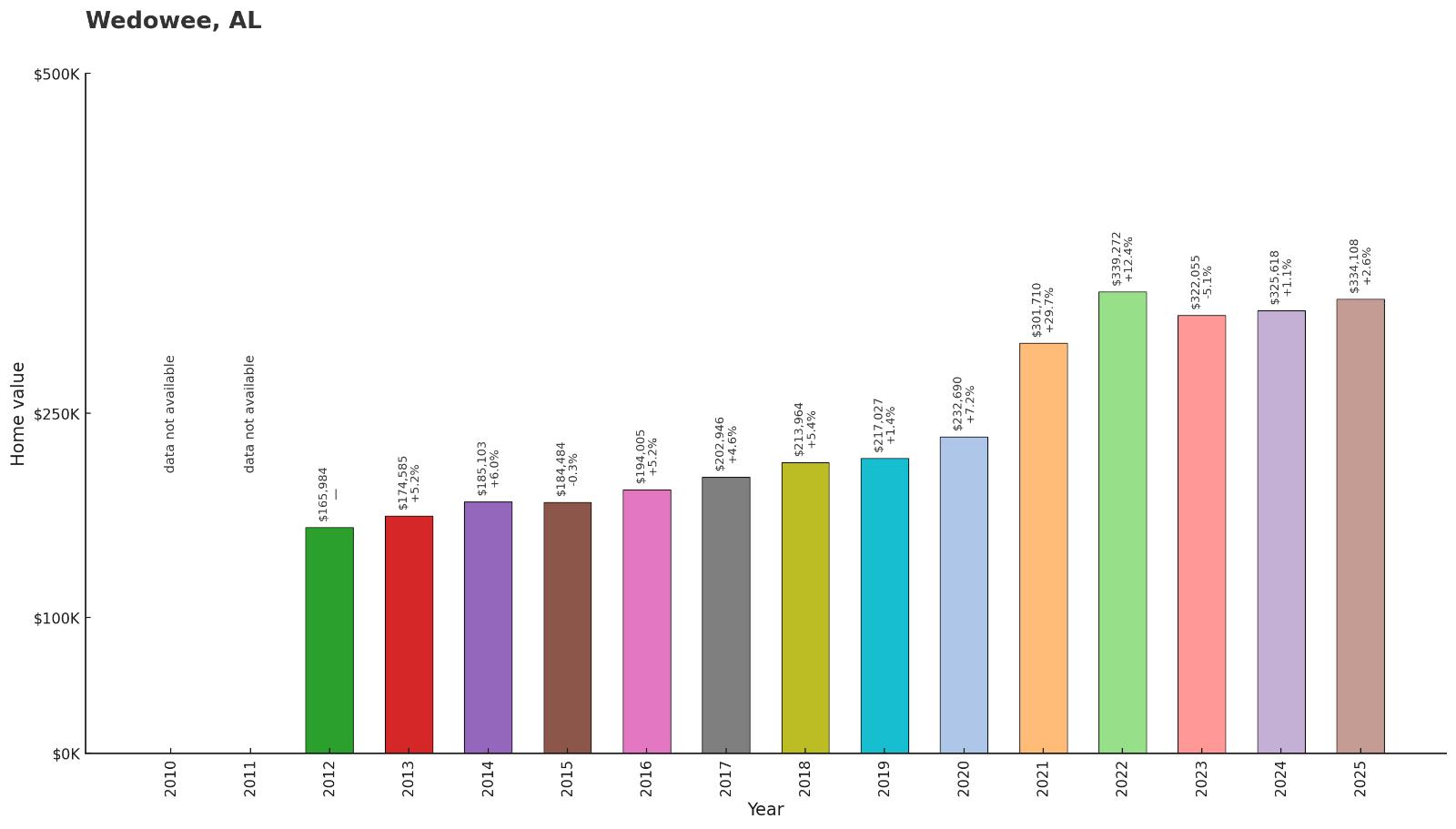
- 2010: N/A
- 2011: N/A
- 2012: $165,984
- 2013: $174,585
- 2014: $185,103
- 2015: $184,484
- 2016: $194,005
- 2017: $202,946
- 2018: $213,964
- 2019: $217,027
- 2020: $232,690
- 2021: $301,710
- 2022: $339,272
- 2023: $322,055
- 2024: $325,618
- 2025: $334,108
Wedowee has doubled in value since tracking began in 2012, with the most dramatic surge occurring in 2021 when prices jumped nearly $70,000 in a single year. The town experienced a brief cooling period in 2023 but has since recovered to reach $334,108 by 2025. This steady upward trajectory reflects growing interest in small-town Alabama living and the area’s appeal as an affordable alternative to larger markets.
Why Wedowee?

Why Are People Willing to Pay So Much to Live Here? What’s Special About It?
Wedowee offers a peaceful small-town lifestyle in east-central Alabama, serving as the county seat of Randolph County. Families appreciate the lower cost of living compared to urban areas while still having access to quality schools and community services. The town provides an authentic Southern experience with local festivals, historic downtown areas, and friendly neighbors who take pride in their community.
Lake Wedowee, a 10,500-acre reservoir, serves as the area’s primary recreation draw with excellent fishing, boating, and waterfront activities. The combination of rural tranquility and outdoor recreation appeals to retirees and families seeking a slower pace of life. Property taxes remain relatively low, and the town maintains basic amenities without the congestion and higher costs of metropolitan areas.
How Wedowee Rose to Prominence
Wedowee was established in 1836 and named after a Creek Indian word meaning “water.” The town’s early economy centered on agriculture and timber, with cotton farming playing a major role throughout the 19th and early 20th centuries. Wedowee served as a regional trading center for surrounding rural communities, establishing its role as the county seat.
The creation of Lake Wedowee in the 1980s by Alabama Power transformed the area’s appeal and economic base. This man-made reservoir brought recreational opportunities and waterfront development that attracted new residents and vacation homeowners. The lake became a catalyst for modest population growth and increased property values as people discovered the area’s natural beauty and affordable real estate.
3 Interesting Tidbits
- Confederate History – Wedowee was the birthplace of William C. Oates, a Civil War colonel who later became Alabama’s governor and a U.S. congressman.
- Lake Paradise – Lake Wedowee offers 10,500 acres of water with over 270 miles of shoreline, making it one of Alabama’s larger recreational lakes.
- Annual Celebration – The town hosts the annual Wedowee Old Timers Day festival, celebrating local history and community traditions that date back decades.
29. Stapleton – 159% Home Price Increase Since 2010

- 2010: $130,188
- 2011: $123,663
- 2012: $128,713
- 2013: $140,238
- 2014: $145,971
- 2015: $158,210
- 2016: $168,457
- 2017: $178,326
- 2018: $194,068
- 2019: $201,228
- 2020: $223,062
- 2021: $272,730
- 2022: $304,560
- 2023: $321,257
- 2024: $331,970
- 2025: $337,651
Stapleton has shown remarkable growth since 2010, with home values more than doubling over the 15-year period. The most significant acceleration occurred between 2020 and 2022, when prices increased by over $80,000. Current values at $337,651 represent sustained demand for this Baldwin County community that combines rural character with strategic location advantages.
Why Stapleton?

Why Are People Willing to Pay So Much to Live Here? What’s Special About It?
Stapleton appeals to buyers seeking rural tranquility with urban accessibility in Baldwin County. The community offers generous lot sizes, newer construction, and peaceful surroundings that attract families and retirees looking to escape denser suburban developments. Its strategic location between Bay Minette and Spanish Fort provides easy access to employment centers, shopping, and services.
The town maintains its agricultural character with horse properties and small farms scattered throughout the area. Residents value the close-knit community feel, low crime rates, and the ability to own larger properties at more affordable prices than coastal Baldwin County markets. The area’s continued growth reflects its appeal as a value alternative to more expensive nearby communities.
How Stapleton Rose to Prominence
Originally settled as an agricultural community in the mid-1800s, Stapleton was built around cotton farming and timber production. The town remained primarily rural throughout most of its history, serving local farming families and maintaining a small population centered on agricultural pursuits.
The transformation began in the 2000s as suburban expansion from Mobile and the Eastern Shore pushed development northward. Stapleton’s location along major transportation routes made it attractive to commuters seeking larger lots and newer homes while maintaining reasonable drive times to employment centers. The community experienced its fastest growth in the past decade as buyers discovered its rural charm and affordability compared to coastal markets.
3 Interesting Tidbits
- Agricultural Roots – The town was originally built around cotton farming and still maintains some agricultural character with horse properties and small farms scattered throughout the area.
- Strategic Location – Stapleton sits roughly equidistant from Mobile, Montgomery, and the Gulf Coast beaches, making it an attractive base for commuters and retirees.
- Growth Surge – The community has experienced its fastest growth in the past decade, with new construction and renovations reflecting increased interest from buyers seeking rural charm.
28. Wilsonville – 94% Home Price Increase Since 2010
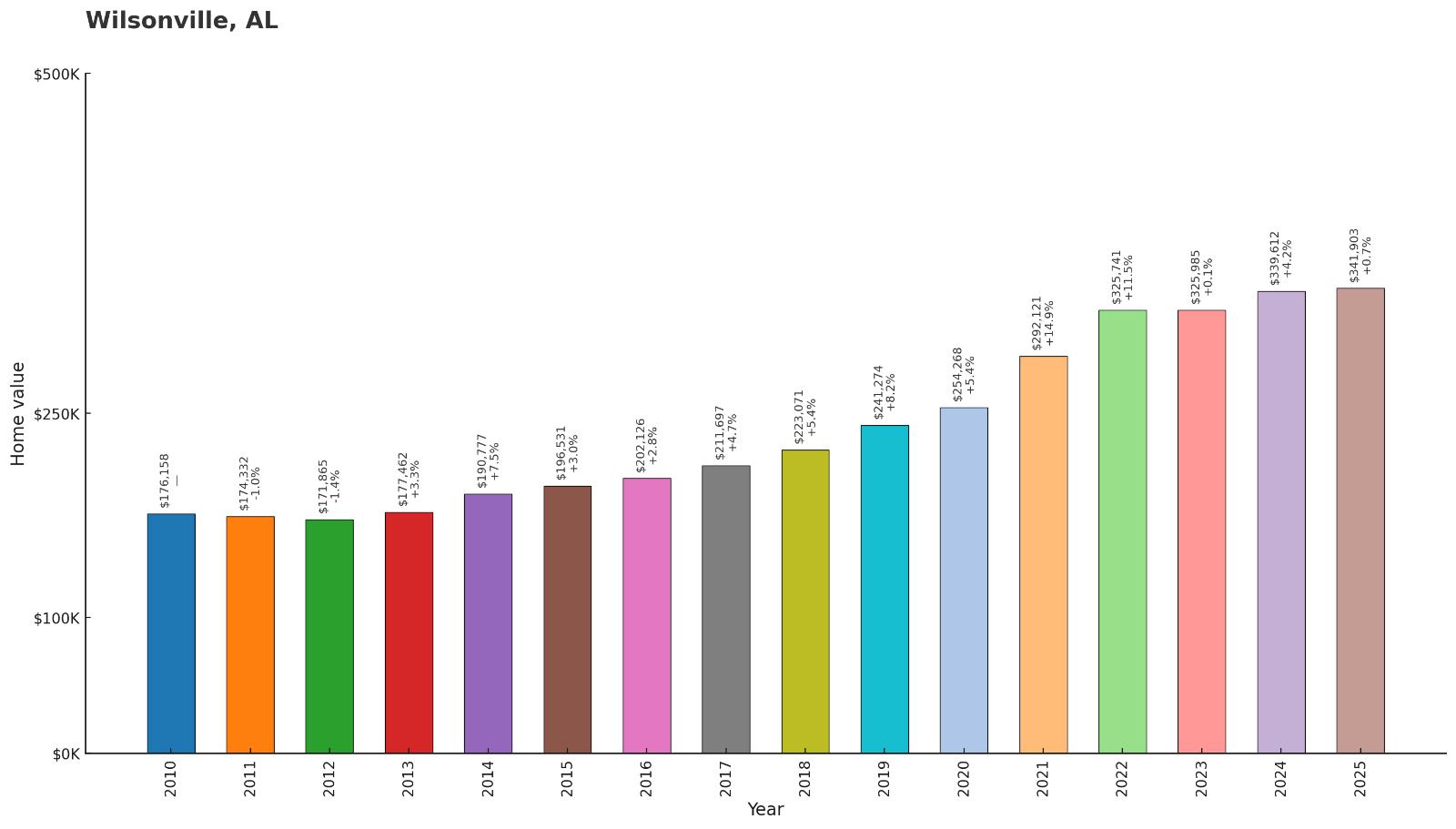
- 2010: $176,158
- 2011: $174,332
- 2012: $171,865
- 2013: $177,462
- 2014: $190,777
- 2015: $196,531
- 2016: $202,126
- 2017: $211,697
- 2018: $223,071
- 2019: $241,274
- 2020: $254,268
- 2021: $292,121
- 2022: $325,741
- 2023: $325,985
- 2024: $339,612
- 2025: $341,903
Wilsonville has demonstrated steady appreciation since 2010, nearly doubling in value over the 15-year period. The town experienced its strongest growth between 2019 and 2022, with prices rising from $241,274 to $325,741. Current values at $341,903 reflect consistent demand for this Shelby County community that offers suburban amenities with small-town character.
Why Wilsonville?
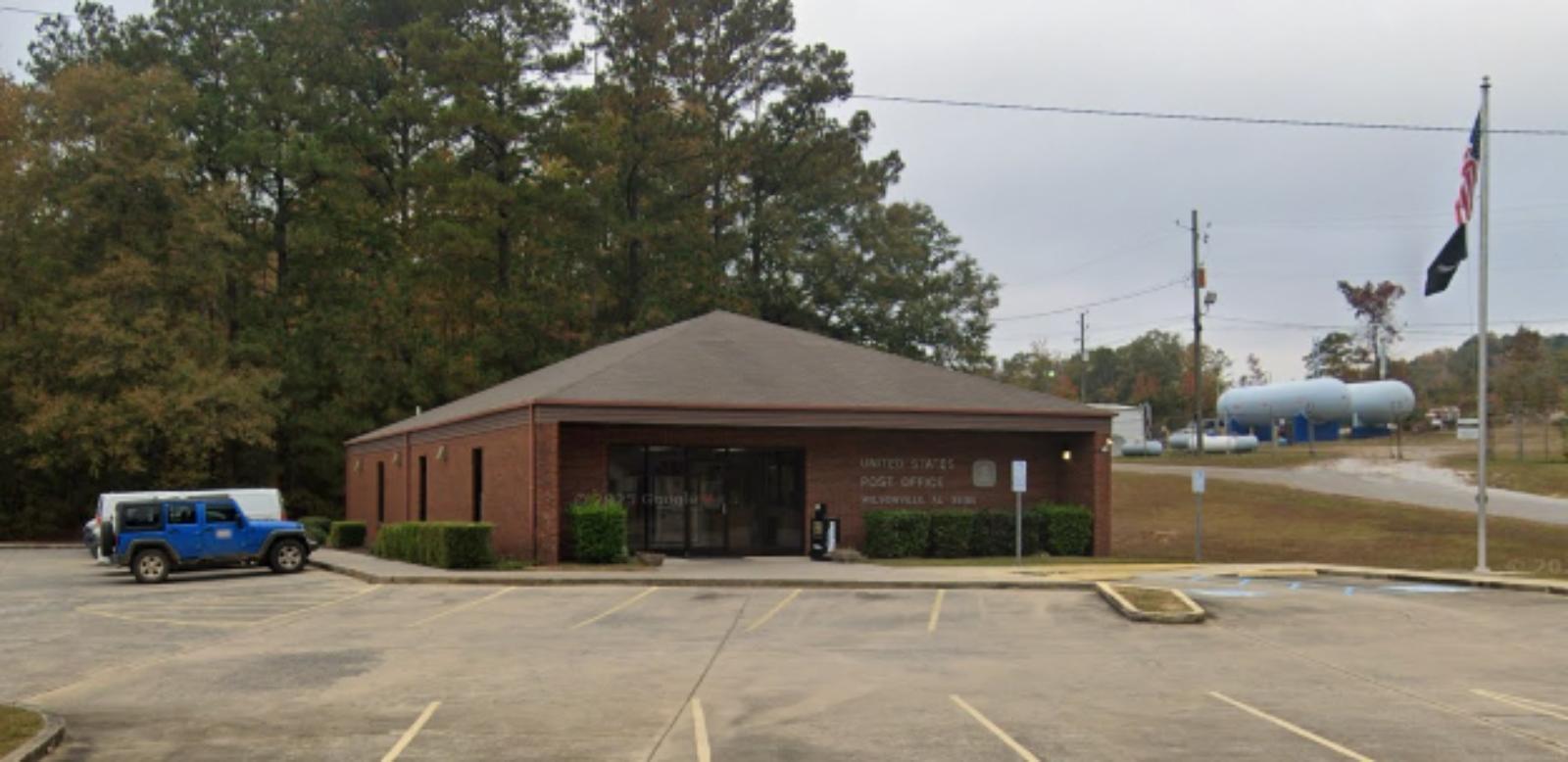
Why Are People Willing to Pay So Much to Live Here? What’s Special About It?
Wilsonville attracts families and professionals seeking quality schools, low crime rates, and community-oriented living in Shelby County. The town offers newer subdivisions, well-maintained neighborhoods, and access to recreational facilities including parks and walking trails. Its location provides convenient commuter access to Birmingham while maintaining a distinct small-town identity.
Residents appreciate the town’s commitment to controlled growth and maintaining green space. The community features family-friendly amenities, local businesses, and civic organizations that foster neighborhood connections. Property values remain attractive compared to other Shelby County communities while offering similar quality of life benefits and school system access.
How Wilsonville Rose to Prominence
Wilsonville was incorporated in 1897 and originally developed around agriculture and small manufacturing. The town remained relatively small throughout most of the 20th century, serving as a rural community in southeastern Shelby County with limited residential development.
Growth accelerated in the 1990s and 2000s as Birmingham’s suburban expansion reached Shelby County and families sought newer communities with good schools and affordable housing. Wilsonville’s location along major highways made it attractive to commuters while offering lower density living than established suburbs. The town has managed growth carefully, maintaining its small-town character while adding modern amenities and infrastructure.
3 Interesting Tidbits
- Historical Depot – The town features a restored train depot that serves as a community center and reminder of its railroad heritage from the early 1900s.
- Family Focus – Wilsonville hosts an annual Family Day festival that brings the community together with food, entertainment, and local vendor booths.
- Green Commitment – The town maintains several parks and green spaces, including walking trails that connect neighborhoods and promote outdoor recreation.
27. Eclectic – 90% Home Price Increase Since 2010
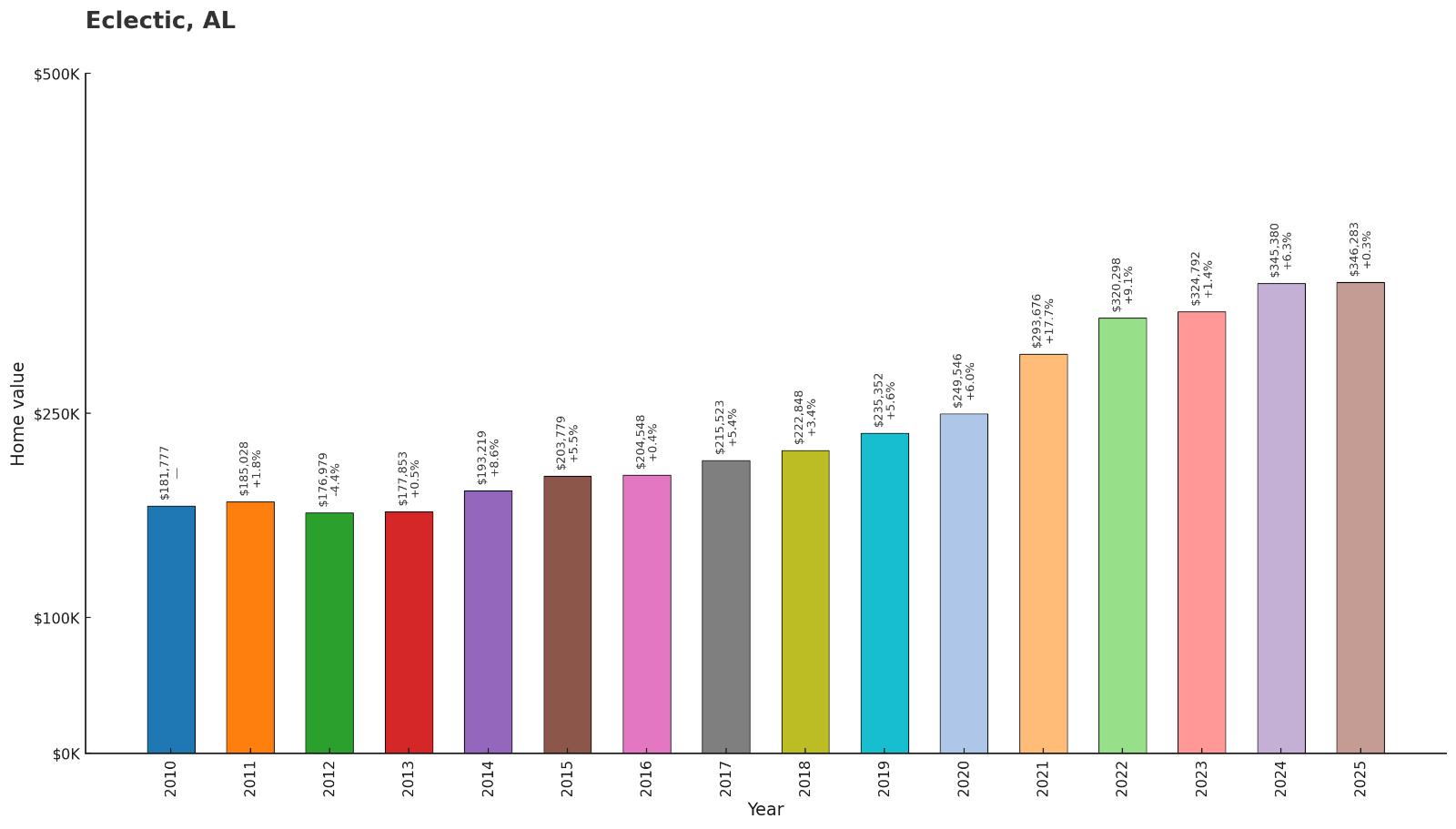
- 2010: $181,777
- 2011: $185,028
- 2012: $176,979
- 2013: $177,853
- 2014: $193,219
- 2015: $203,779
- 2016: $204,548
- 2017: $215,523
- 2018: $222,848
- 2019: $235,352
- 2020: $249,546
- 2021: $293,676
- 2022: $320,298
- 2023: $324,792
- 2024: $345,380
- 2025: $346,283
Eclectic has shown strong appreciation since 2010, with values increasing by 90% over the 15-year period. The most significant growth occurred between 2020 and 2022, when prices rose from $249,546 to $320,298. Current values at $346,283 reflect the enduring appeal of this Lake Martin community that offers waterfront living and recreational opportunities.
Why Eclectic?
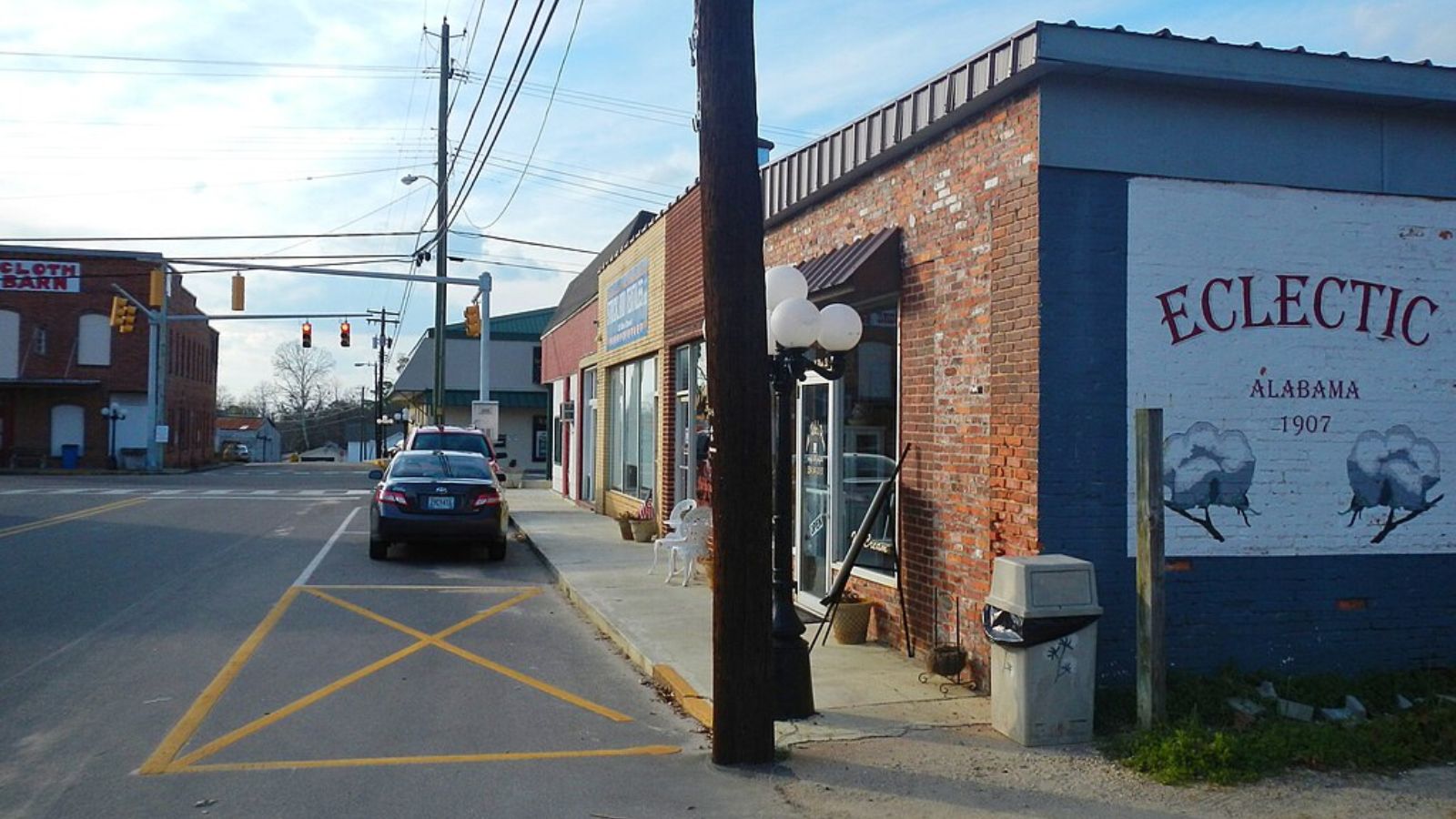
Why Are People Willing to Pay So Much to Live Here? What’s Special About It?
Eclectic sits on the shores of Lake Martin, one of Alabama’s most popular recreational lakes with 750 miles of shoreline. The town attracts buyers seeking waterfront living, fishing, and water sports in a scenic setting. Lake Martin’s reputation as a premier recreational destination drives much of Eclectic’s real estate appeal.
The community offers a mix of year-round residents and weekend homeowners from Birmingham, Montgomery, and Atlanta. Eclectic provides affordable lake living compared to similar markets in other southeastern states, making it attractive to retirees and recreational buyers. The area combines natural beauty with modern amenities while maintaining a relaxed, resort-like atmosphere.
How Eclectic Rose to Prominence
Originally a small farming community, Eclectic’s destiny changed with the creation of Lake Martin by Alabama Power in the 1920s. The massive hydroelectric project created one of the South’s largest man-made lakes, transforming the area into a recreational destination. The town’s name reportedly came from its diverse mix of early settlers.
As Lake Martin gained popularity for recreation and vacation homes, Eclectic evolved from an agricultural village into a lakefront community. Development accelerated in the 1970s and 1980s as more people discovered the lake’s appeal for boating, fishing, and weekend getaways. The town has maintained its small-town character while embracing its role as a gateway to Lake Martin’s recreational opportunities.
3 Interesting Tidbits
- Lake Paradise – Lake Martin spans 44,000 acres with 750 miles of shoreline, making it one of the Southeast’s premier recreational lakes for boating and fishing.
- Power Heritage – The lake was created by Alabama Power’s Martin Dam, completed in 1926 as part of the company’s expansion of hydroelectric generation.
- Weekend Gateway – Many Atlanta and Birmingham residents maintain vacation homes in Eclectic, creating a seasonal population that swells during summer months.
26. Helena – 83% Home Price Increase Since 2010
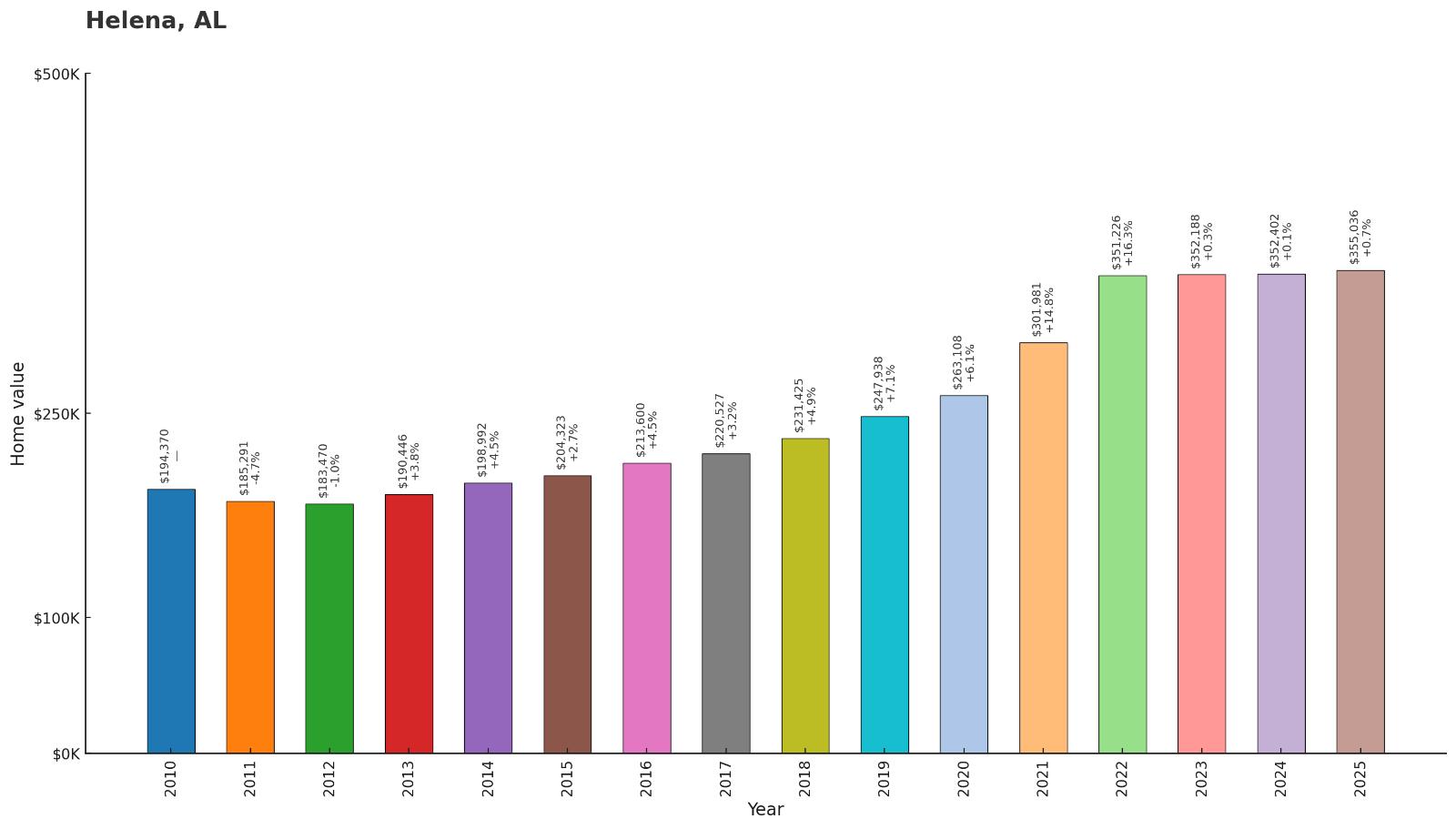
- 2010: $194,370
- 2011: $185,291
- 2012: $183,470
- 2013: $190,446
- 2014: $198,992
- 2015: $204,323
- 2016: $213,600
- 2017: $220,527
- 2018: $231,425
- 2019: $247,938
- 2020: $263,108
- 2021: $301,981
- 2022: $351,226
- 2023: $352,188
- 2024: $352,402
- 2025: $355,036
Helena has experienced steady growth since 2010, with home values increasing by 83% over the period. The most dramatic appreciation occurred between 2020 and 2022, when prices jumped from $263,108 to $351,226. Current values at $355,036 reflect the community’s appeal as a growing Shelby County suburb with excellent schools and family-oriented amenities.
Why Helena?

Why Are People Willing to Pay So Much to Live Here? What’s Special About It?
Helena offers families an ideal combination of excellent schools, new construction, and community amenities in fast-growing Shelby County. The city features numerous parks, recreational facilities, and family-friendly events that create a strong sense of community. Residents appreciate the well-planned neighborhoods, low crime rates, and access to quality municipal services.
The community’s strategic location provides easy commuter access to Birmingham while maintaining a distinct suburban identity. Helena’s commitment to controlled growth and infrastructure development has created an attractive environment for young families and professionals. Property values reflect the area’s desirability and the premium buyers place on newer communities with modern amenities.
How Helena Rose to Prominence
Helena was incorporated in 1917 but remained a small rural community for most of the 20th century. The area was primarily agricultural, with small farms and timber operations dominating the local economy. Limited development occurred until Birmingham’s suburban expansion began reaching Shelby County in the 1980s and 1990s.
Rapid growth began in the 2000s as developers recognized Helena’s potential for family-oriented suburban development. The city’s leadership focused on planned growth, quality infrastructure, and recreational amenities that would attract young families. Helena’s emergence as a destination community accelerated after 2010, driven by excellent schools, new construction, and its reputation for family-friendly living.
3 Interesting Tidbits
- Sports Complex – Helena features the Buck Creek Trail system and multiple sports complexes that host youth athletics and community events throughout the year.
- Planned Growth – The city has implemented comprehensive planning to manage rapid growth while maintaining quality infrastructure and community character.
- Festival Town – Helena hosts annual events including Bucktoberfest and other community celebrations that bring residents together and showcase local businesses.
25. Madison – 168% Home Price Increase Since 2010
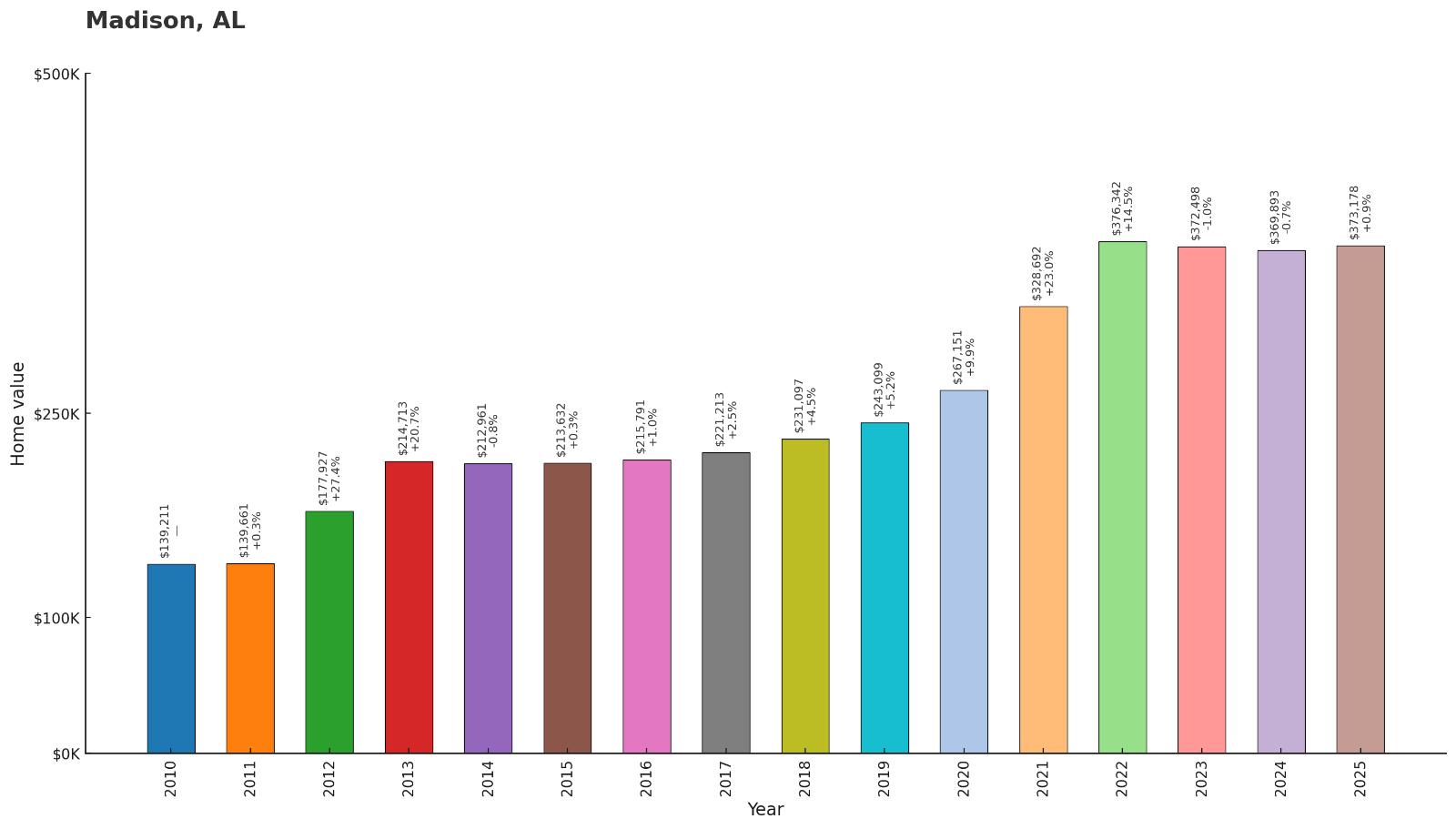
- 2010: $139,211
- 2011: $139,661
- 2012: $177,927
- 2013: $214,713
- 2014: $212,961
- 2015: $213,632
- 2016: $215,791
- 2017: $221,213
- 2018: $231,097
- 2019: $243,099
- 2020: $267,151
- 2021: $328,692
- 2022: $376,342
- 2023: $372,498
- 2024: $369,893
- 2025: $373,178
Madison has delivered exceptional appreciation since 2010, with values increasing by 168% over the period. The community experienced a notable jump between 2012 and 2013, then steady growth through 2022 when prices peaked at $376,342. Current values at $373,178 reflect the sustained demand for this limestone County community known for excellent schools and quality of life.
Why Madison?

Why Are People Willing to Pay So Much to Live Here? What’s Special About It?
Madison attracts families and professionals drawn to its excellent school system, which consistently ranks among Alabama’s best public education options. The community offers well-planned neighborhoods, abundant parks and recreational facilities, and a strong sense of civic engagement. Residents value the city’s commitment to quality municipal services and infrastructure maintenance.
The city’s location in the Huntsville metro area provides access to aerospace and technology employment while maintaining suburban character. Madison has successfully managed growth while preserving community amenities and avoiding urban sprawl. The combination of top-tier schools, family-friendly atmosphere, and economic opportunity justifies premium housing costs for many buyers.
How Madison Rose to Prominence
Madison was incorporated in 1869 but remained a small agricultural community for over a century. The area was primarily farmland with limited residential development until the growth of Huntsville’s aerospace and defense industries created demand for suburban housing options. Early development focused on providing quality neighborhoods for young professionals.
The transformation accelerated in the 1990s and 2000s as Madison became synonymous with excellent schools and family-oriented living. The city’s strategic planning emphasized quality over quantity, creating well-designed neighborhoods and comprehensive recreational amenities. Madison’s reputation for educational excellence and community life established it as a premium destination within the Huntsville area.
3 Interesting Tidbits
- School Excellence – Madison City Schools consistently rank among the top public school systems in Alabama, driving significant demand from families with children.
- Research Triangle – The city benefits from proximity to Huntsville’s aerospace corridor, including NASA Marshall Space Flight Center and numerous defense contractors.
- Park System – Madison maintains over 400 acres of parkland, including the Dublin Memorial Park complex with sports fields, walking trails, and community facilities.
24. Chelsea – 71% Home Price Increase Since 2010
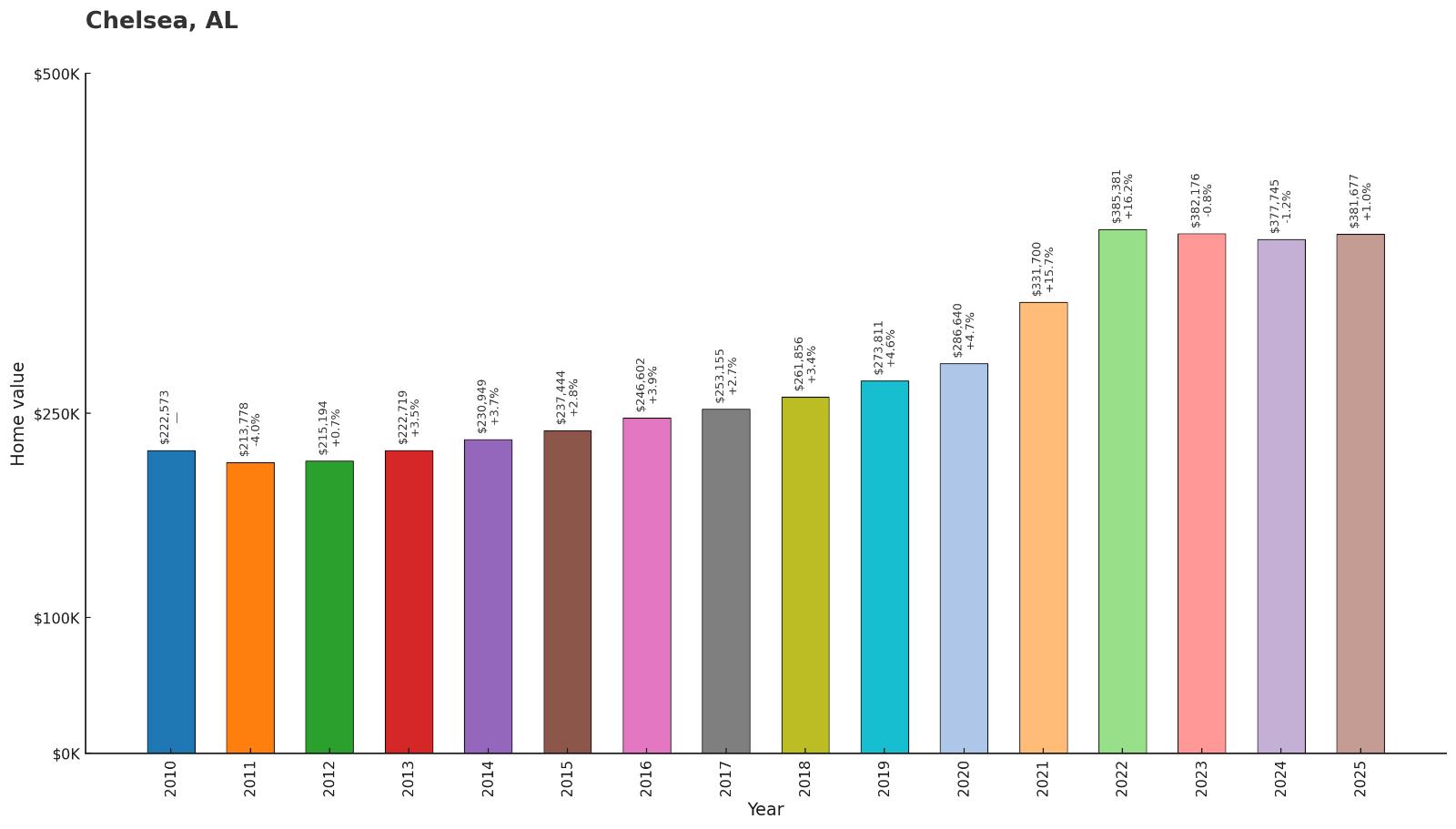
- 2010: $222,573
- 2011: $213,778
- 2012: $215,194
- 2013: $222,719
- 2014: $230,949
- 2015: $237,444
- 2016: $246,602
- 2017: $253,155
- 2018: $261,856
- 2019: $273,811
- 2020: $286,640
- 2021: $331,700
- 2022: $385,381
- 2023: $382,176
- 2024: $377,745
- 2025: $381,677
Chelsea has shown consistent appreciation since 2010, with home values increasing by 71% over the 15-year period. The community experienced its strongest growth between 2020 and 2022, when prices rose from $286,640 to $385,381. Current values at $381,677 reflect the area’s appeal as an established Shelby County community with quality schools and suburban amenities.
Why Chelsea?

Why Are People Willing to Pay So Much to Live Here? What’s Special About It?
Chelsea attracts families seeking a balance of suburban convenience and small-town character in Shelby County. The community offers excellent schools, well-maintained neighborhoods, and access to recreational facilities including parks and sports complexes. Residents appreciate the city’s commitment to planned growth and quality infrastructure development.
The area provides easy commuter access to Birmingham while maintaining lower population density and a family-friendly atmosphere. Chelsea’s numerous subdivisions feature newer construction and modern amenities that appeal to young professionals and families. The community’s emphasis on parks, trails, and recreational activities creates an attractive lifestyle for active residents.
How Chelsea Rose to Prominence
Chelsea was incorporated in 1996, making it one of Alabama’s newer municipalities. The area was previously unincorporated parts of Shelby County that experienced residential development as Birmingham’s suburban growth pushed southward. Community leaders sought incorporation to gain local control over zoning, services, and development standards.
Growth accelerated after incorporation as the city implemented comprehensive planning and infrastructure development. Chelsea’s focus on family-oriented amenities, quality schools, and controlled development attracted young families seeking newer suburban communities. The city’s strategic approach to growth management and recreational facilities established its reputation as a desirable place to raise families.
3 Interesting Tidbits
- Young City – Chelsea was incorporated in 1996, making it one of Alabama’s newest municipalities with modern infrastructure and planning.
- Community Events – The city hosts numerous family-friendly events including the annual Chelsea Community Festival and various recreational programs for all ages.
- Trail System – Chelsea maintains extensive walking and biking trails that connect neighborhoods and provide outdoor recreation opportunities for residents.
23. Elberta – 146% Home Price Increase Since 2010
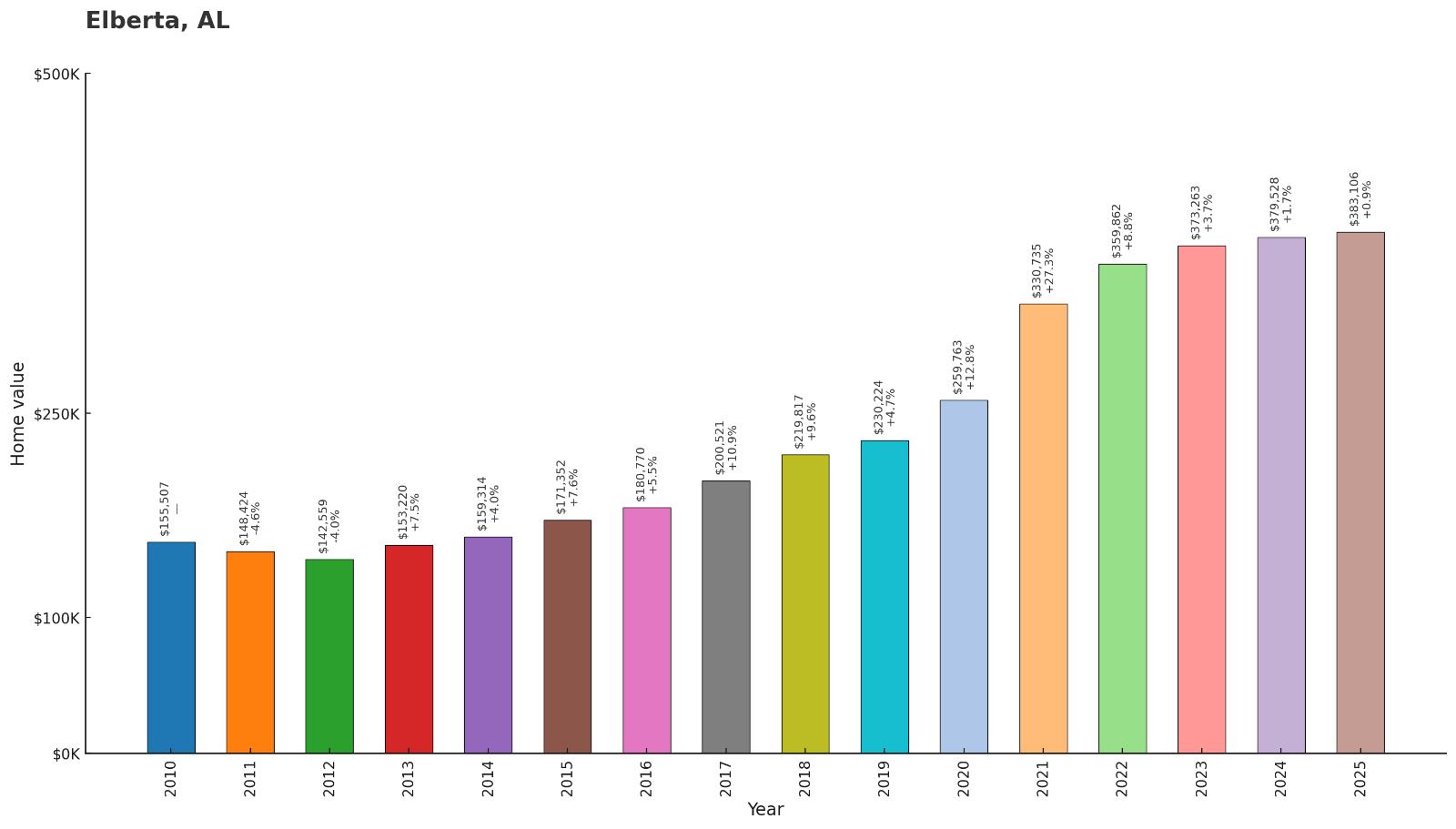
- 2010: $155,507
- 2011: $148,424
- 2012: $142,559
- 2013: $153,220
- 2014: $159,314
- 2015: $171,352
- 2016: $180,770
- 2017: $200,521
- 2018: $219,817
- 2019: $230,224
- 2020: $259,763
- 2021: $330,735
- 2022: $359,862
- 2023: $373,263
- 2024: $379,528
- 2025: $383,106
Elberta has delivered remarkable appreciation since 2010, with home values increasing by 146% over the period. The community showed steady growth through 2020, then accelerated dramatically with prices rising from $259,763 to $359,862 between 2020 and 2022. Current values at $383,106 reflect the strong demand for this Baldwin County community that offers coastal access with rural character.
Why Elberta?

Why Are People Willing to Pay So Much to Live Here? What’s Special About It?
Elberta offers buyers an attractive combination of coastal proximity and rural charm in south Baldwin County. The community provides easy access to Gulf Shores and Orange Beach while maintaining lower population density and more affordable land costs. Residents appreciate the area’s agricultural heritage, including local farms and roadside produce stands.
The town’s location along major highways provides convenient access to beach communities, shopping, and employment centers while offering larger lot sizes and newer construction. Elberta appeals to families and retirees seeking a quieter lifestyle with coastal access. The community has retained its small-town character while accommodating steady growth from buyers seeking alternatives to more expensive coastal markets.
How Elberta Rose to Prominence
Elberta was founded in the early 1900s as an agricultural community, originally known for its peach orchards and diversified farming. The town was established by Midwestern settlers who were attracted by the area’s fertile soil and mild climate for year-round farming. Agriculture remained the primary economic driver for most of the 20th century.
The community’s transformation began in the 1990s and accelerated in the 2000s as coastal Baldwin County experienced rapid growth. Elberta’s strategic location between Interstate 65 and the coast made it attractive to buyers seeking affordable land with beach access. The town has managed to preserve its agricultural heritage while accommodating residential growth and new development.
3 Interesting Tidbits
- Peach Heritage – The town was originally known for its extensive peach orchards, with agriculture remaining an important part of the local economy and character.
- German Sausage – Elberta is home to Elberta German Sausage Festival, an annual celebration of the area’s German immigrant heritage and local food traditions.
- Coastal Gateway – The community serves as a popular stopping point for visitors traveling to Gulf Shores and Orange Beach, with several local restaurants and businesses.
22. Waverly – 109% Home Price Increase Since 2010
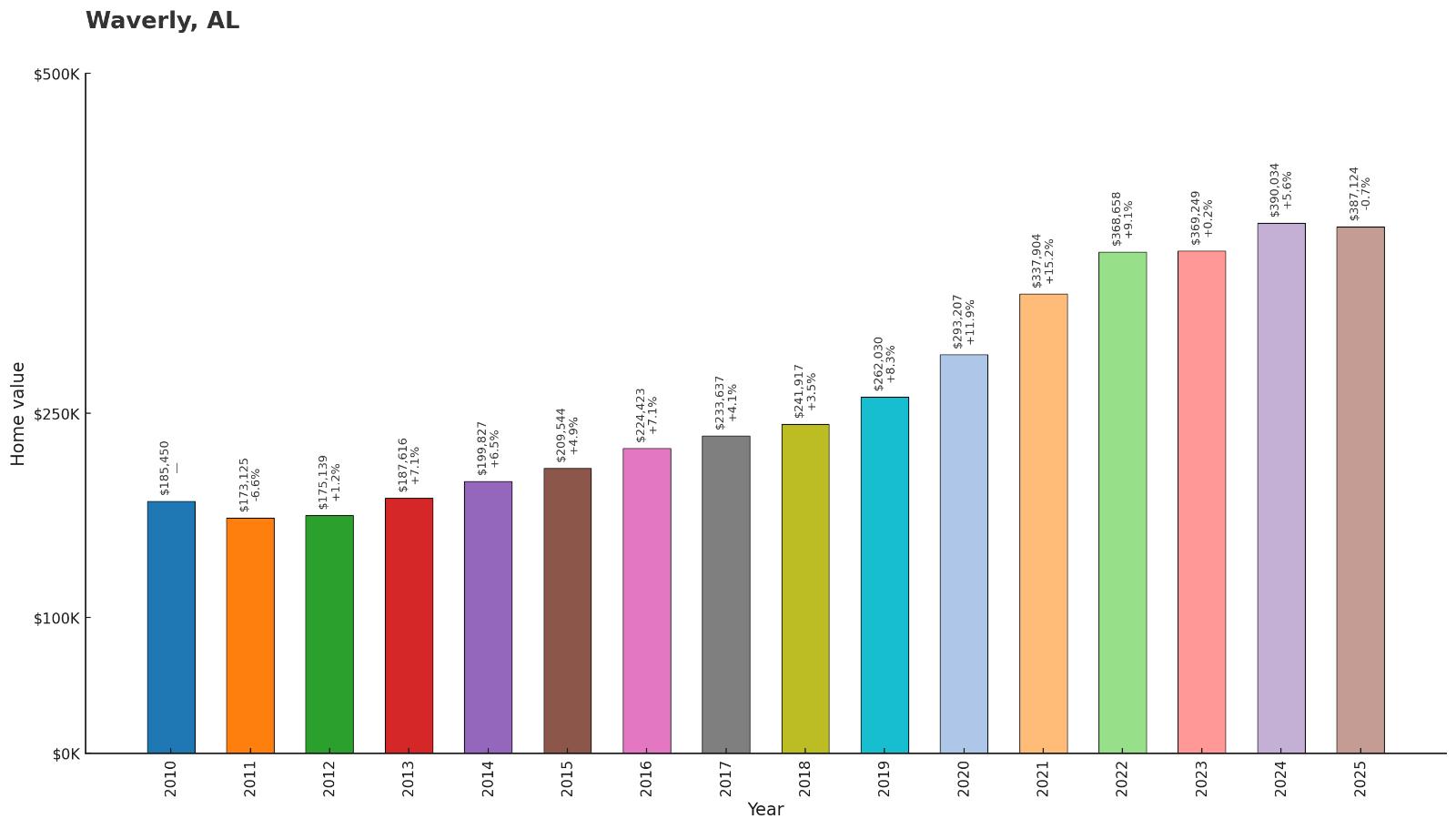
- 2010: $185,450
- 2011: $173,125
- 2012: $175,139
- 2013: $187,616
- 2014: $199,827
- 2015: $209,544
- 2016: $224,423
- 2017: $233,637
- 2018: $241,917
- 2019: $262,030
- 2020: $293,207
- 2021: $337,904
- 2022: $368,658
- 2023: $369,249
- 2024: $390,034
- 2025: $387,124
Waverly has more than doubled in value since 2010, with home prices increasing by 109% over the 15-year period. The community showed consistent growth through 2020, then accelerated significantly with prices rising from $293,207 to $368,658 between 2020 and 2022. Current values at $387,124 reflect the premium buyers place on this small Lee County community known for its historic character and cultural activities.
Why Waverly?
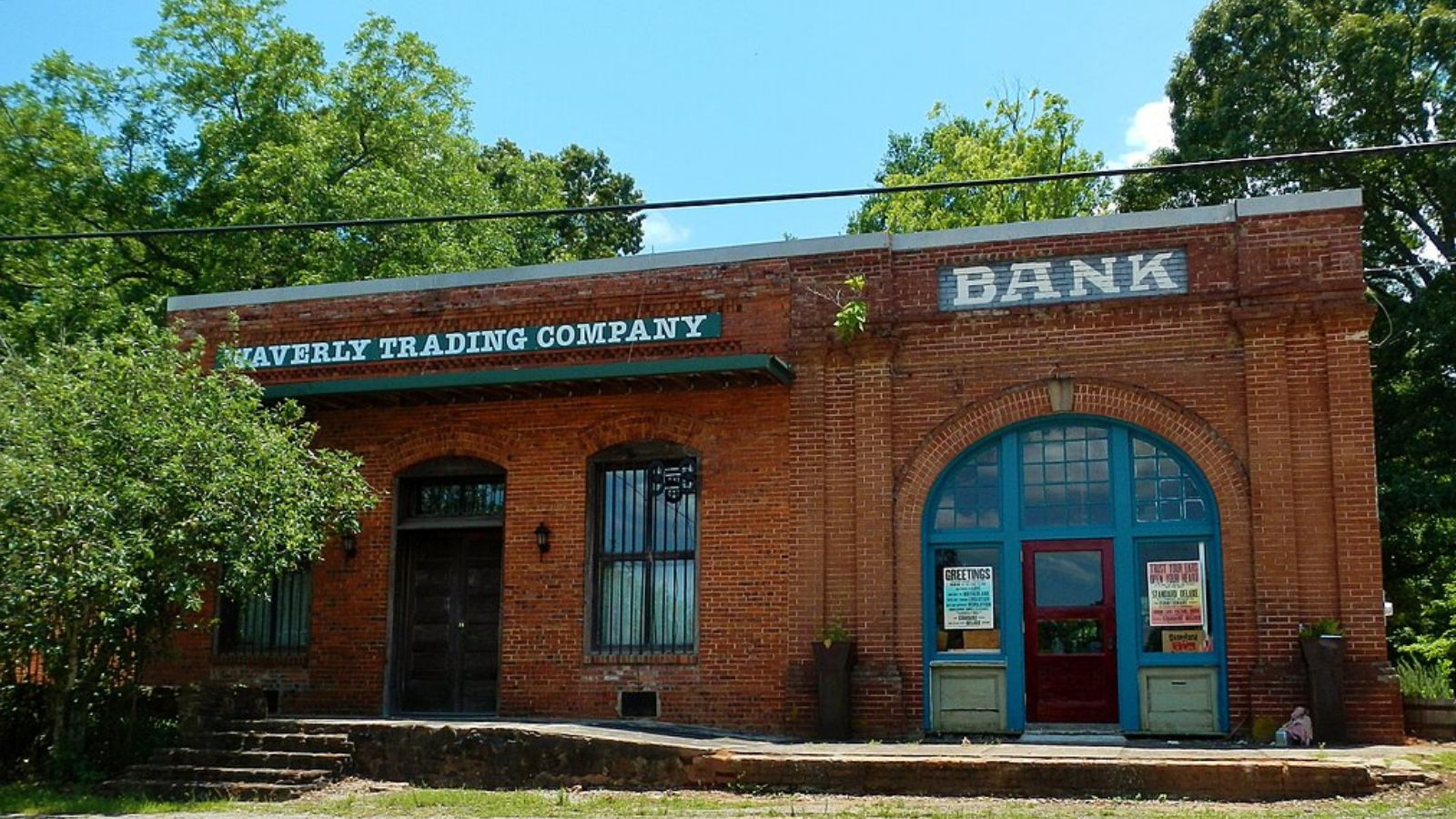
Why Are People Willing to Pay So Much to Live Here? What’s Special About It?
Waverly offers a unique blend of historic charm and cultural activities in a small-town setting near Auburn. The community hosts one of Alabama’s most popular independent arts and music festivals, attracting creative professionals and cultural enthusiasts to the area. Residents value the town’s carefully preserved historic character and intimate community atmosphere.
The limited inventory of homes, many custom-built or historical, creates scarcity that drives up values. Waverly appeals to buyers seeking weekend retreats, retirement properties, or unique homes with character that can’t be found in typical subdivisions. The town’s proximity to Auburn University and Lake Martin adds to its appeal for diverse buyer groups.
How Waverly Rose to Prominence
Waverly was established in the 1840s as a small agricultural and trading community in Lee County. The town developed around cotton farming and served as a local commercial center with mills, shops, and services for surrounding rural areas. Throughout the 19th and early 20th centuries, Waverly maintained its role as a quiet agricultural town with limited growth.
The community’s transformation began in the 1970s and 1980s as preservationists and artists discovered its historic buildings and small-town character. Waverly’s annual music festival, started in the 1990s, put the town on the cultural map and attracted attention from creative professionals and weekend visitors. The combination of historic preservation, cultural activities, and proximity to Auburn has created a unique niche market that commands premium prices.
3 Interesting Tidbits
- Music Festival – Waverly hosts an acclaimed annual independent music festival that draws performers and visitors from across the Southeast, boosting the town’s cultural reputation.
- Historic Preservation – Many of the town’s buildings date to the 19th century and have been carefully preserved, creating a unique architectural character.
- Artists’ Haven – The community has attracted artists, musicians, and creative professionals who appreciate the small-town atmosphere and historic setting.
21. Trussville – 74% Home Price Increase Since 2010
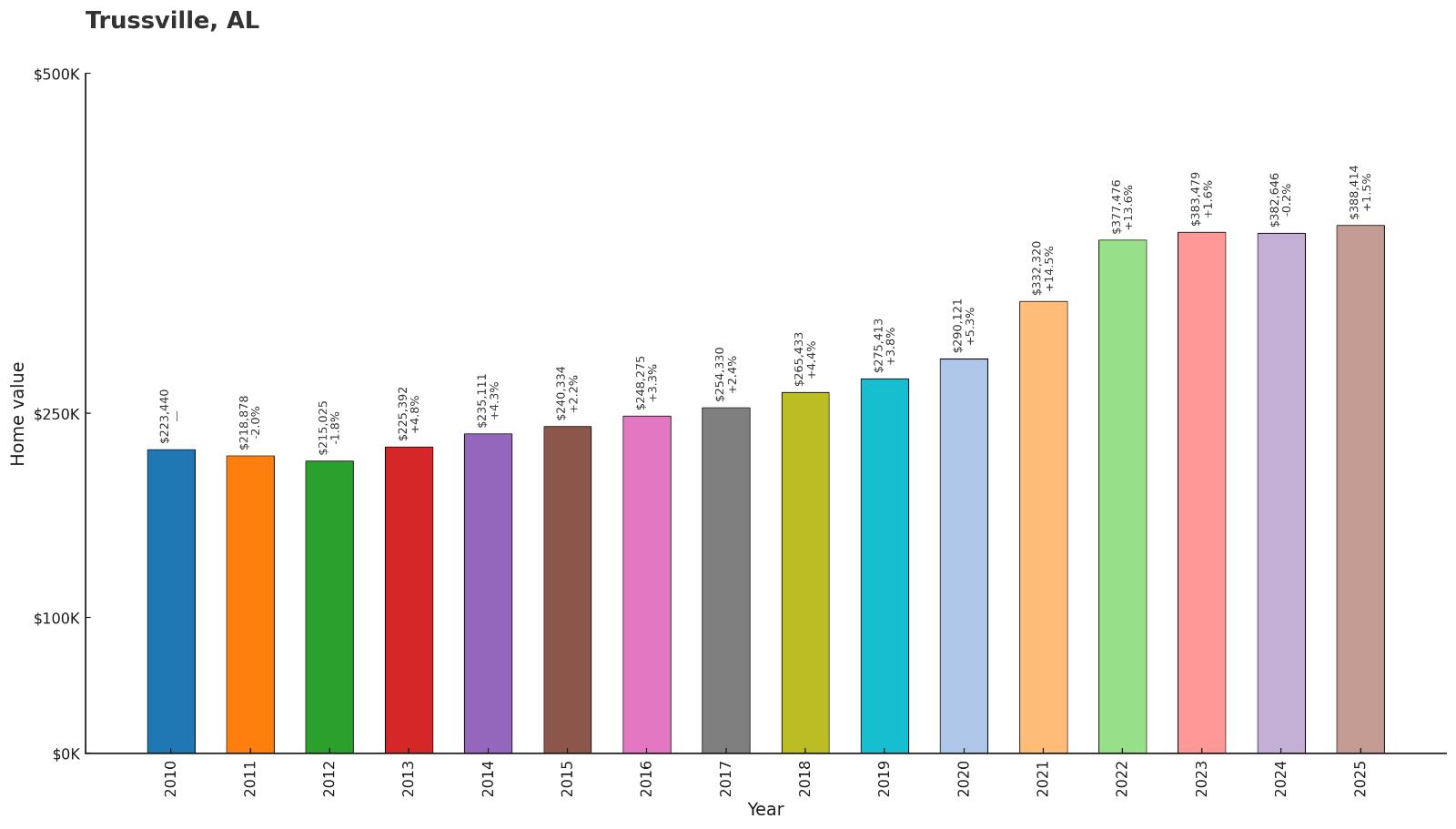
- 2010: $223,440
- 2011: $218,878
- 2012: $215,025
- 2013: $225,392
- 2014: $235,111
- 2015: $240,334
- 2016: $248,275
- 2017: $254,330
- 2018: $265,433
- 2019: $275,413
- 2020: $290,121
- 2021: $332,320
- 2022: $377,476
- 2023: $383,479
- 2024: $382,646
- 2025: $388,414
Trussville has shown steady appreciation since 2010, with home values increasing by 74% over the 15-year period. The community experienced consistent growth through 2020, then accelerated between 2020 and 2022 when prices rose from $290,121 to $377,476. Current values at $388,414 reflect the sustained demand for this Jefferson County community known for excellent schools and family-oriented amenities.
Why Trussville?
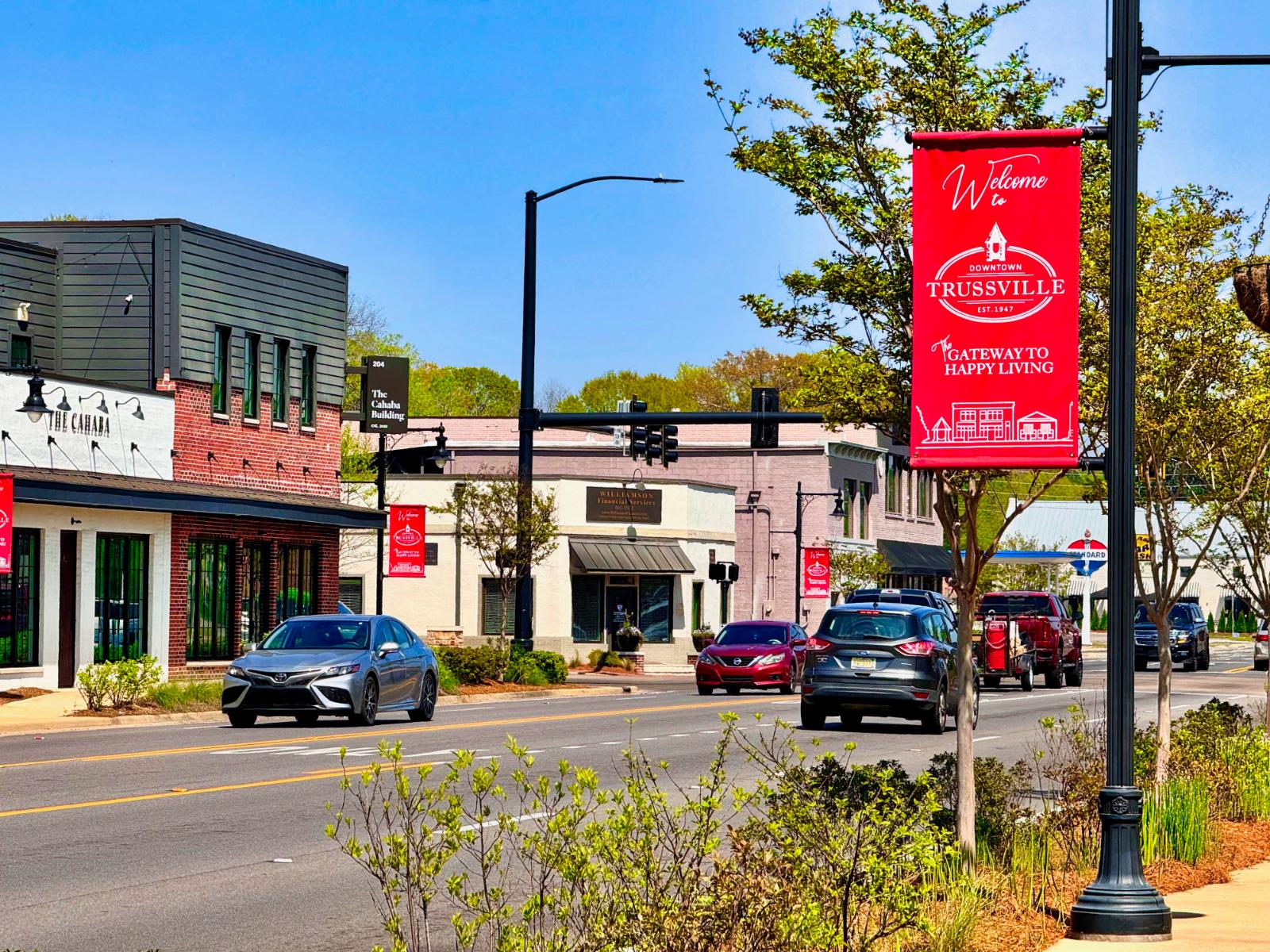
Why Are People Willing to Pay So Much to Live Here? What’s Special About It?
Trussville attracts families seeking top-rated schools, safe neighborhoods, and community-centered living in the Birmingham metro area. The city offers excellent municipal services, well-maintained parks, and recreational facilities that create an attractive environment for raising children. Residents value the strong school system, low crime rates, and active civic engagement.
The community provides easy commuter access to Birmingham while maintaining suburban character and small-town friendliness. Trussville’s downtown area features local businesses, restaurants, and community events that foster neighborhood connections. The city’s commitment to quality infrastructure and planned growth has created a stable, desirable environment that justifies premium housing costs.
How Trussville Rose to Prominence
Trussville was incorporated in 1947 but traces its origins to the 1820s when settlers established farming communities in the area. The town was named after Warren Truss, an early landowner and developer who promoted the area’s potential for residential development. For most of its early history, Trussville remained a small agricultural community.
Growth accelerated in the 1960s and 1970s as Birmingham’s suburban expansion reached Jefferson County and families sought quality school districts and newer neighborhoods. Trussville’s leadership focused on maintaining high standards for development and municipal services, establishing the community’s reputation for family-friendly living. The city’s emphasis on education, recreation, and community engagement has sustained its appeal over multiple decades.
3 Interesting Tidbits
- School Pride – Trussville City Schools consistently rank among Alabama’s top public school systems, driving significant demand from families with school-age children.
- Cahaba River – The city sits along the Cahaba River, providing natural beauty and recreational opportunities including fishing and kayaking.
- Community Spirit – Trussville hosts numerous annual events and festivals that bring residents together and showcase local businesses and organizations.
20. Spanish Fort – 78% Home Price Increase Since 2010
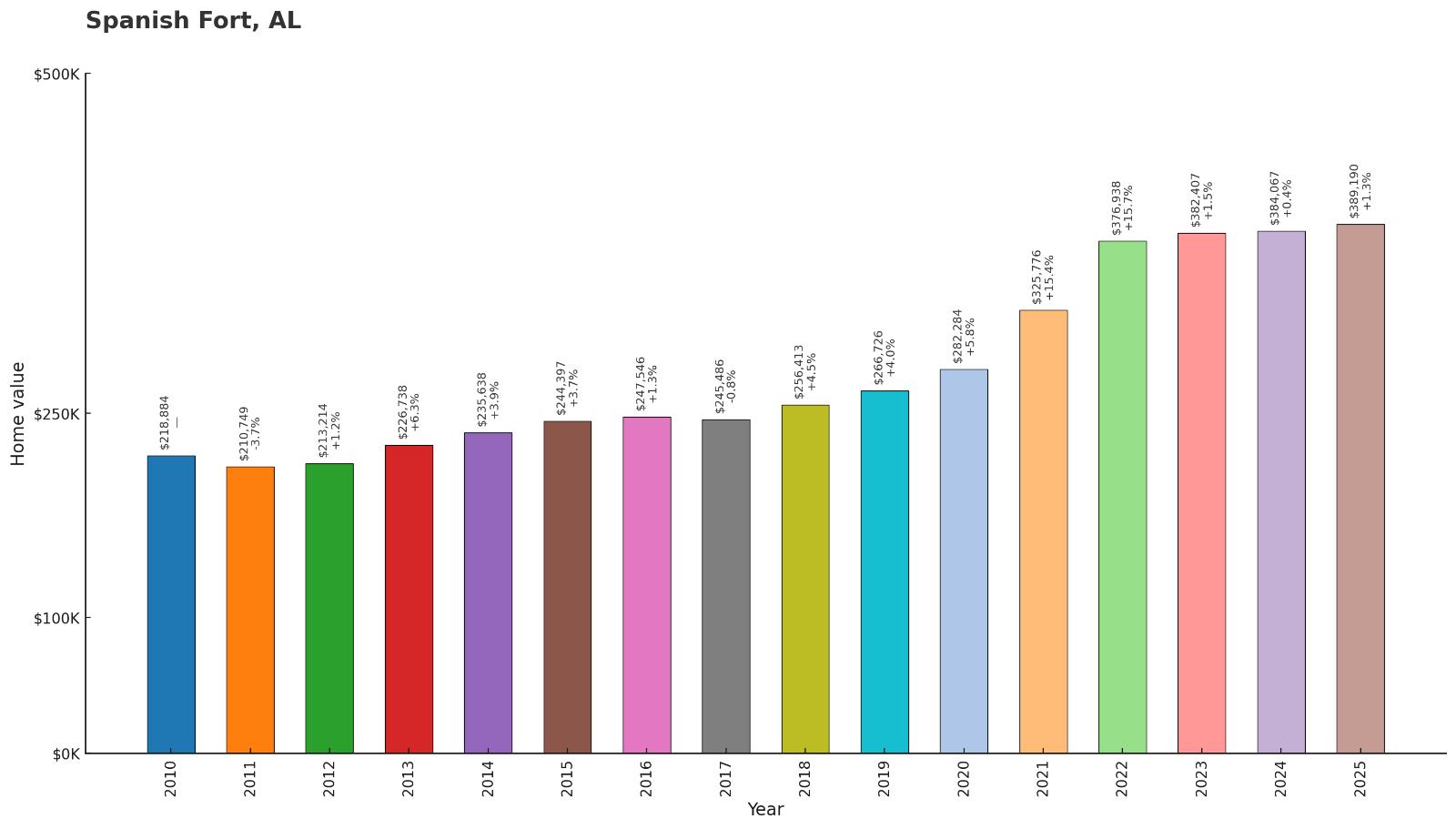
- 2010: $218,884
- 2011: $210,749
- 2012: $213,214
- 2013: $226,738
- 2014: $235,638
- 2015: $244,397
- 2016: $247,546
- 2017: $245,486
- 2018: $256,413
- 2019: $266,726
- 2020: $282,284
- 2021: $325,776
- 2022: $376,938
- 2023: $382,407
- 2024: $384,067
- 2025: $389,190
Spanish Fort has demonstrated solid appreciation since 2010, with home values increasing by 78% over the period. The community showed steady but modest growth through 2020, then accelerated significantly with prices rising from $282,284 to $376,938 between 2020 and 2022. Current values at $389,190 reflect the strong demand for this Baldwin County community that offers suburban amenities with coastal access.
Why Spanish Fort?
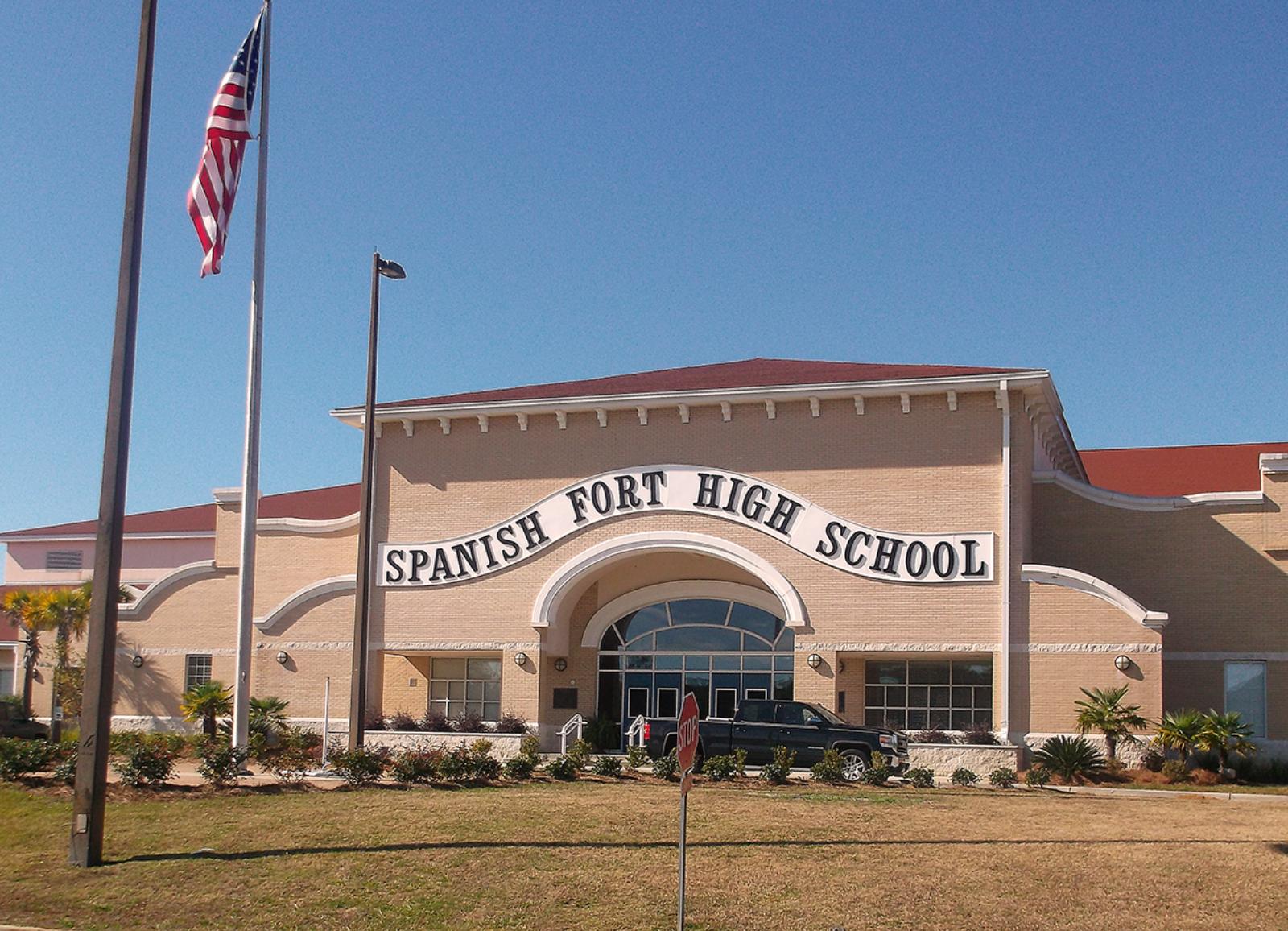
Why Are People Willing to Pay So Much to Live Here? What’s Special About It?
Spanish Fort offers families an ideal combination of excellent schools, modern amenities, and strategic location in Baldwin County. The community features well-planned neighborhoods, shopping centers, and recreational facilities that create a comprehensive suburban lifestyle. Residents appreciate the city’s commitment to quality infrastructure and controlled development.
The area provides convenient access to Mobile for employment while offering proximity to Gulf Coast beaches and recreational opportunities. Spanish Fort’s rapid growth has been accompanied by careful planning that maintains quality of life while accommodating new residents. The combination of family-friendly amenities, good schools, and coastal access justifies premium housing costs for many buyers.
How Spanish Fort Rose to Prominence
Spanish Fort was incorporated in 1993, making it one of Alabama’s newer municipalities. The area was previously unincorporated Baldwin County land that experienced rapid residential and commercial development as Mobile’s growth pushed eastward. Community leaders sought incorporation to gain local control over zoning and development standards.
Growth exploded after incorporation as developers recognized the area’s potential for master-planned communities and retail centers. Spanish Fort’s strategic location along major highways made it attractive to families seeking newer suburban communities with beach access. The city’s focus on comprehensive planning and quality amenities quickly established it as one of Baldwin County’s most desirable residential areas.
3 Interesting Tidbits
- Historic Namesake – The city takes its name from a Spanish colonial fort built in the area during the 18th century to control access to the Mobile River.
- Retail Hub – Spanish Fort has become a major retail destination with shopping centers and restaurants serving the broader Baldwin County area.
- Rapid Growth – Since incorporation in 1993, the city has grown from a rural area to one of Alabama’s fastest-growing suburban communities.
19. Pike Road – 33% Home Price Increase Since 2010
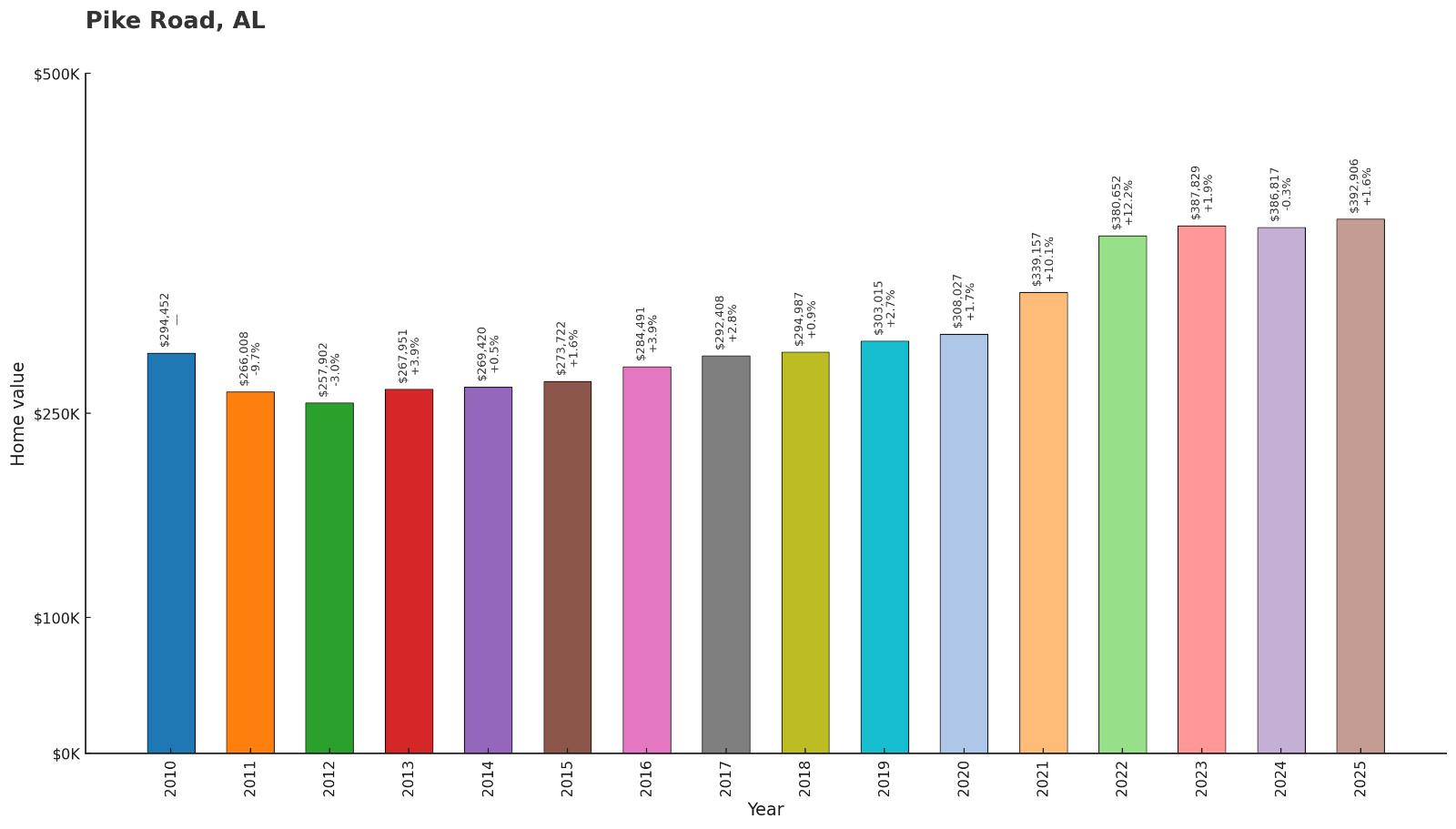
- 2010: $294,452
- 2011: $266,008
- 2012: $257,902
- 2013: $267,951
- 2014: $269,420
- 2015: $273,722
- 2016: $284,491
- 2017: $292,408
- 2018: $294,987
- 2019: $303,015
- 2020: $308,027
- 2021: $339,157
- 2022: $380,652
- 2023: $387,829
- 2024: $386,817
- 2025: $392,906
Pike Road has shown moderate but consistent appreciation since 2010, with home values increasing by 33% over the period. The community maintained relatively stable prices through 2020, then experienced acceleration with values rising from $308,027 to $380,652 between 2020 and 2022. Current values at $392,906 reflect the premium associated with this Montgomery County community known for excellent schools and planned development.
Why Pike Road?
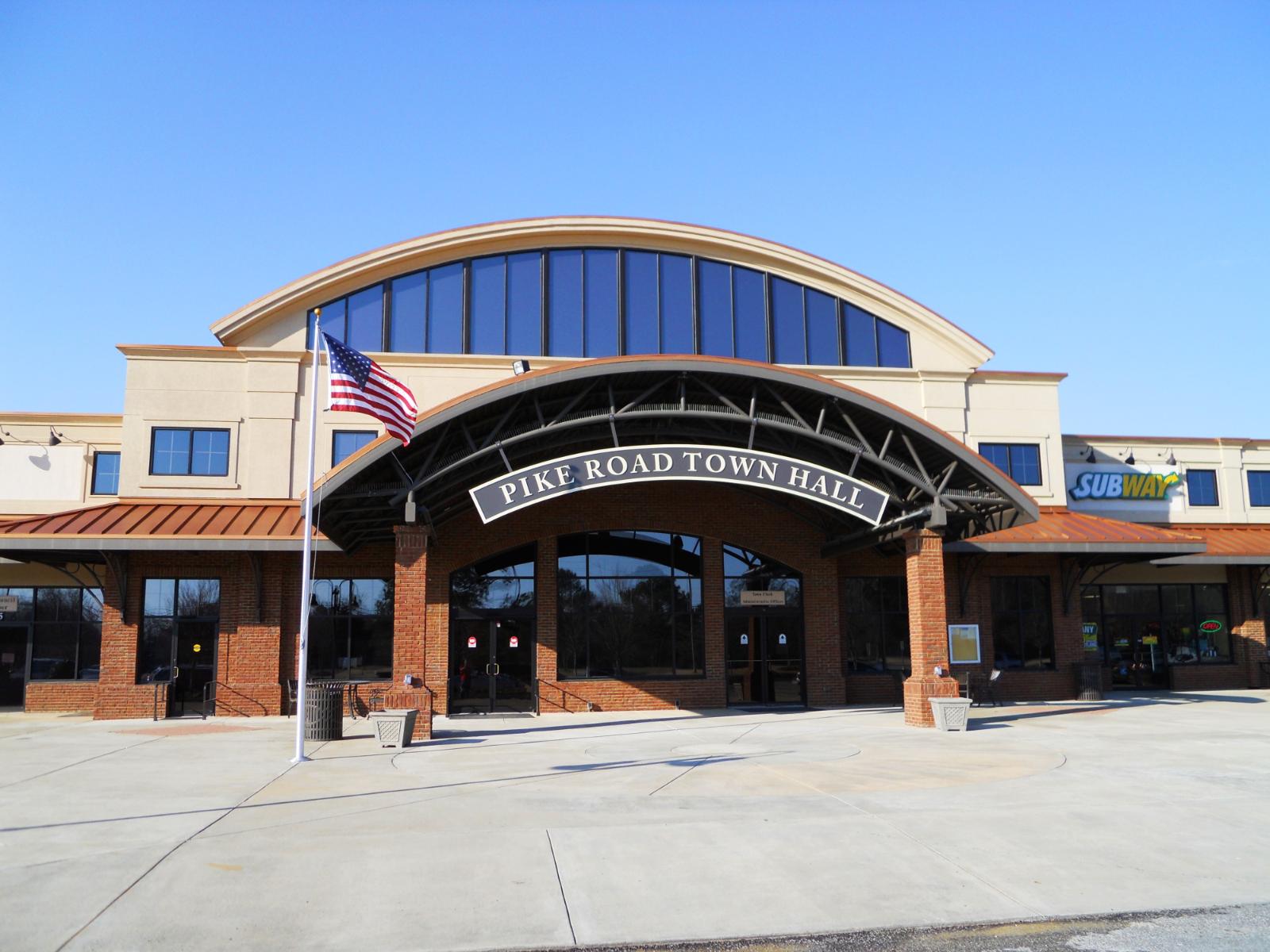
Why Are People Willing to Pay So Much to Live Here? What’s Special About It?
Pike Road attracts affluent families seeking top-tier education and master-planned community living in the Montgomery area. The town offers excellent schools, extensive recreational facilities, and carefully planned neighborhoods that create an upscale suburban lifestyle. Residents value the community’s commitment to maintaining high standards for development and municipal services.
The area provides convenient access to Montgomery employment centers while offering a distinct community identity separate from the capital city. Pike Road’s emphasis on education, recreation, and quality of life appeals to professionals and families willing to pay premium prices for comprehensive community amenities. The town’s controlled growth and planning standards help maintain property values and community character.
How Pike Road Rose to Prominence
Pike Road was incorporated in 1997 as Montgomery County residents sought to create a municipality focused on education and planned development. The area was previously unincorporated land that experienced residential growth as Montgomery’s suburbs expanded southward. Community leaders envisioned a town built around excellent schools and comprehensive planning.
Development accelerated after incorporation as the town established its own school system and implemented comprehensive zoning standards. Pike Road’s focus on education excellence and quality development attracted affluent families seeking premium suburban living. The town’s success in creating a highly-rated school system and maintaining development standards has established it as one of central Alabama’s most desirable residential communities.
3 Interesting Tidbits
- School Excellence – Pike Road Schools consistently rank among Alabama’s top public school systems, with the town incorporating specifically to create quality educational opportunities.
- Planned Community – The town was designed from incorporation to be a master-planned community with comprehensive recreational amenities and infrastructure.
- Sports Facilities – Pike Road features state-of-the-art athletic facilities and has become known for competitive high school sports programs.
18. Houston – 62% Home Price Increase Since 2010
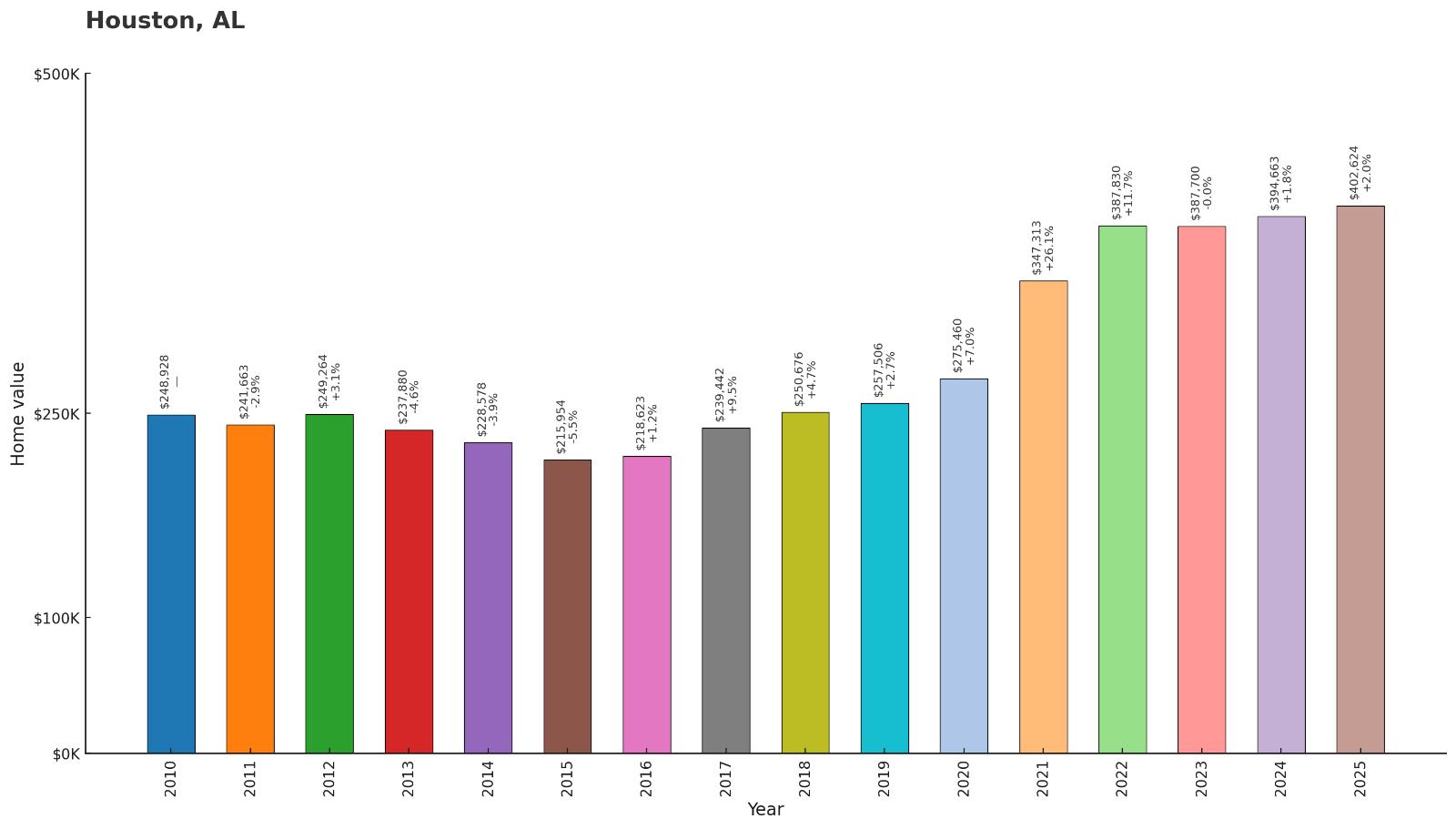
- 2010: $248,928
- 2011: $241,663
- 2012: $249,264
- 2013: $237,880
- 2014: $228,578
- 2015: $215,954
- 2016: $218,623
- 2017: $239,442
- 2018: $250,676
- 2019: $257,506
- 2020: $275,460
- 2021: $347,313
- 2022: $387,830
- 2023: $387,700
- 2024: $394,663
- 2025: $402,624
Houston experienced a unique price pattern, with values declining from 2010 through 2016 before recovering and ultimately increasing by 62% over the full period. The most dramatic appreciation occurred between 2020 and 2022, when prices jumped from $275,460 to $387,830. Current values at $402,624 represent a remarkable turnaround for this Winston County community that offers rural character with modern amenities.
Why Houston?

Why Are People Willing to Pay So Much to Live Here? What’s Special About It?
Houston offers buyers seeking rural tranquility and natural beauty in Winston County’s scenic hill country. The small community provides a peaceful alternative to urban living while maintaining access to modern amenities and services. Residents appreciate the area’s low population density, outdoor recreation opportunities, and tight-knit community atmosphere.
The town’s location in Alabama’s hill country offers scenic views, cooler temperatures, and outdoor activities including hiking, fishing, and hunting. Houston appeals to retirees, remote workers, and families seeking a slower pace of life without sacrificing connectivity. The community’s recent price appreciation reflects growing interest in rural lifestyle options and the premium buyers place on natural beauty and tranquility.
How Houston Rose to Prominence
Houston was incorporated as one of Alabama’s smallest towns, with a population of just a few hundred residents. The community was established in the late 1800s as a small agricultural and timber town serving the surrounding rural area. Throughout most of its history, Houston remained a quiet rural community with limited growth or development.
The town’s transformation began in the 2000s as buyers began seeking alternatives to urban and suburban living. Houston’s combination of rural character, natural beauty, and relative affordability attracted new residents looking for peaceful retreats or permanent homes away from metropolitan areas. The community has managed to preserve its small-town character while accommodating modest growth from buyers seeking authentic rural living.
3 Interesting Tidbits
- Tiny Town – Houston is one of Alabama’s smallest incorporated municipalities, with a population that has remained under 200 residents for decades.
- Hill Country – The town sits in Winston County’s scenic hill country, offering cooler temperatures and mountain views compared to other parts of Alabama.
- Natural Beauty – The area features forests, creeks, and rolling hills that provide excellent opportunities for outdoor recreation and scenic views.
17. Auburn – 96% Home Price Increase Since 2010
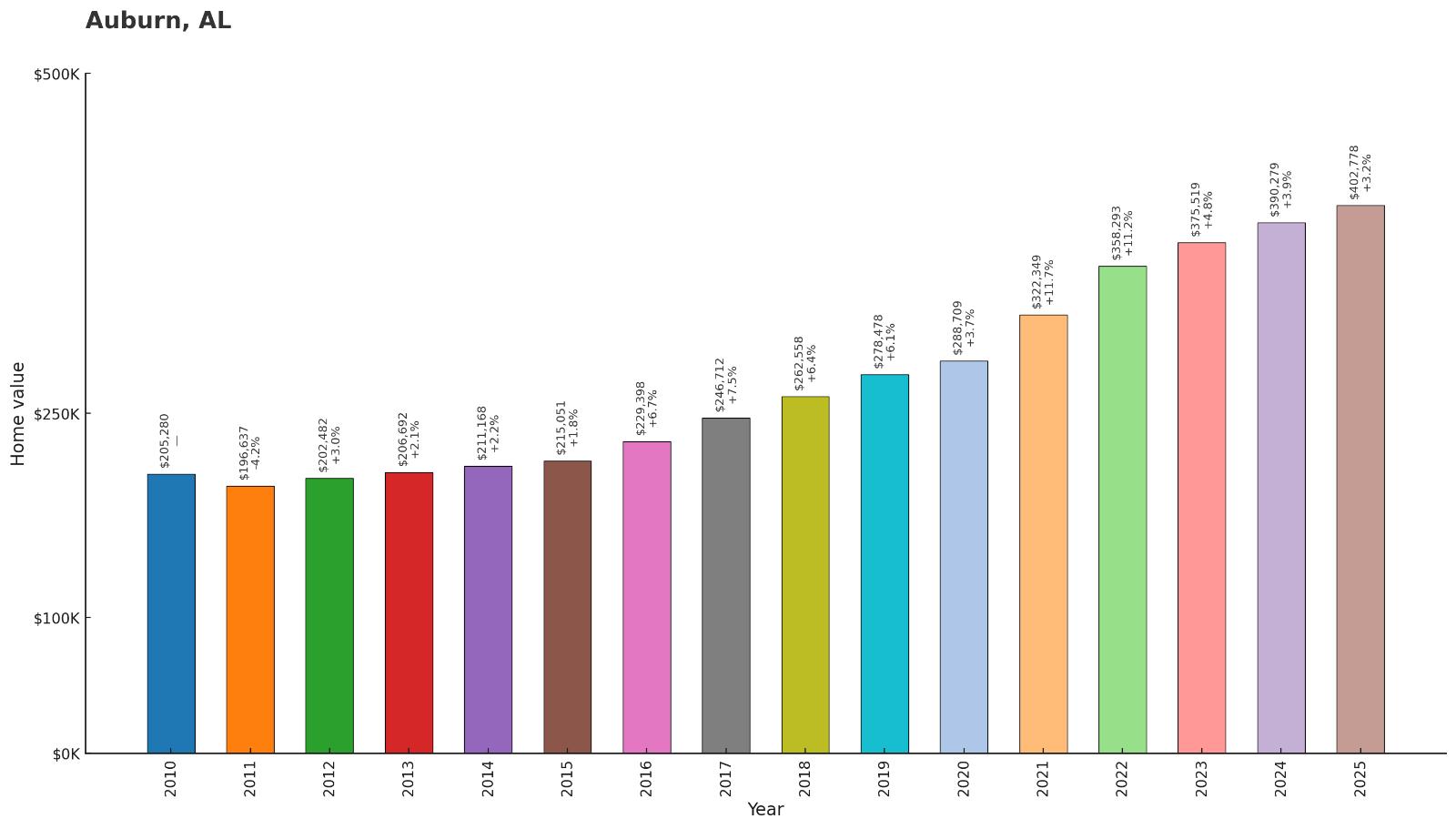
- 2010: $205,280
- 2011: $196,637
- 2012: $202,482
- 2013: $206,692
- 2014: $211,168
- 2015: $215,051
- 2016: $229,398
- 2017: $246,712
- 2018: $262,558
- 2019: $278,478
- 2020: $288,709
- 2021: $322,349
- 2022: $358,293
- 2023: $375,519
- 2024: $390,279
- 2025: $402,778
Auburn has nearly doubled in value since 2010, with home prices increasing by 96% over the 15-year period. The community showed consistent growth throughout the period, with particular acceleration after 2016 when prices began climbing more rapidly each year. Current values at $402,778 reflect the sustained demand for housing in this prominent university town with strong economic fundamentals.
Why Auburn?
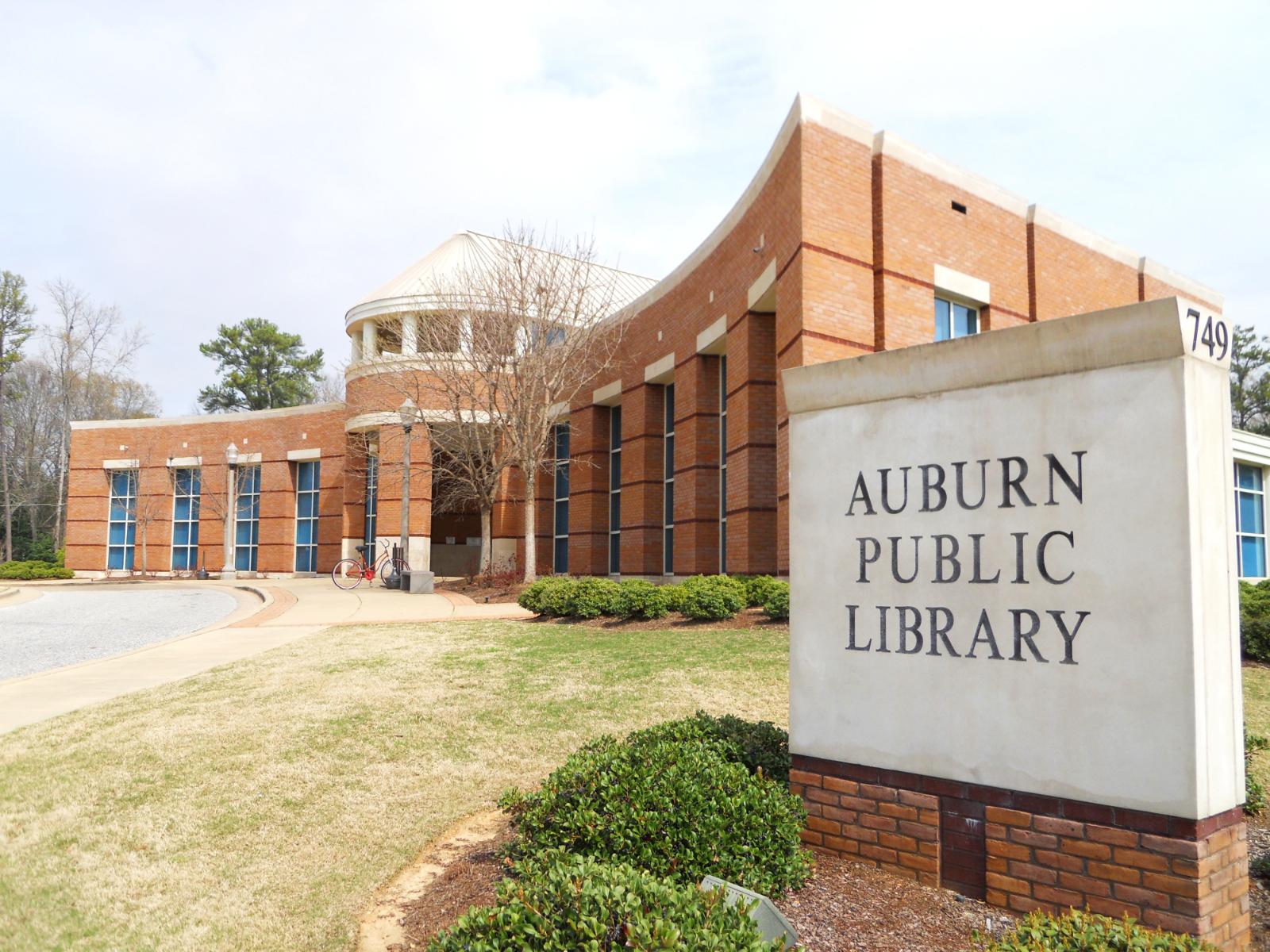
Why Are People Willing to Pay So Much to Live Here? What’s Special About It?
Auburn offers a unique combination of university town culture, strong job market, and small-city charm anchored by Auburn University. The community provides excellent schools, cultural amenities, and recreational opportunities that appeal to faculty, staff, alumni, and families seeking quality education. Residents value the town’s intellectual atmosphere, diverse dining and entertainment options, and strong sense of community pride.
The presence of Auburn University creates economic stability and cultural vibrancy that distinguishes the community from typical small Alabama towns. Auburn’s job market extends beyond the university to include research, healthcare, and professional services that provide diverse employment opportunities. The combination of educational excellence, economic stability, and quality of life justifies premium housing costs for many buyers.
How Auburn Rose to Prominence
Auburn was founded in 1836 and incorporated in 1839, but its transformation into a significant Alabama city began with the establishment of what is now Auburn University in 1856. The school, originally the East Alabama Male College, became the anchor institution that would define the community’s character and economic base for generations.
Growth accelerated throughout the 20th century as Auburn University expanded and gained national recognition, particularly in athletics and academics. The university’s success brought increased enrollment, faculty, and research funding that created jobs and attracted residents beyond the student population. Auburn’s reputation for educational excellence and community pride has made it one of Alabama’s most desirable places to live and invest in real estate.
3 Interesting Tidbits
- War Eagle – Auburn University’s athletic programs, particularly football, create a passionate fan base and community identity centered around the “War Eagle” tradition.
- Research Hub – The university conducts significant research in agriculture, engineering, and veterinary medicine, contributing to the local economy and job market.
- Tree City – Auburn is known for its beautiful tree-lined streets and commitment to urban forestry, earning recognition as a Tree City USA community.
16. Owens Cross Roads – 166% Home Price Increase Since 2010
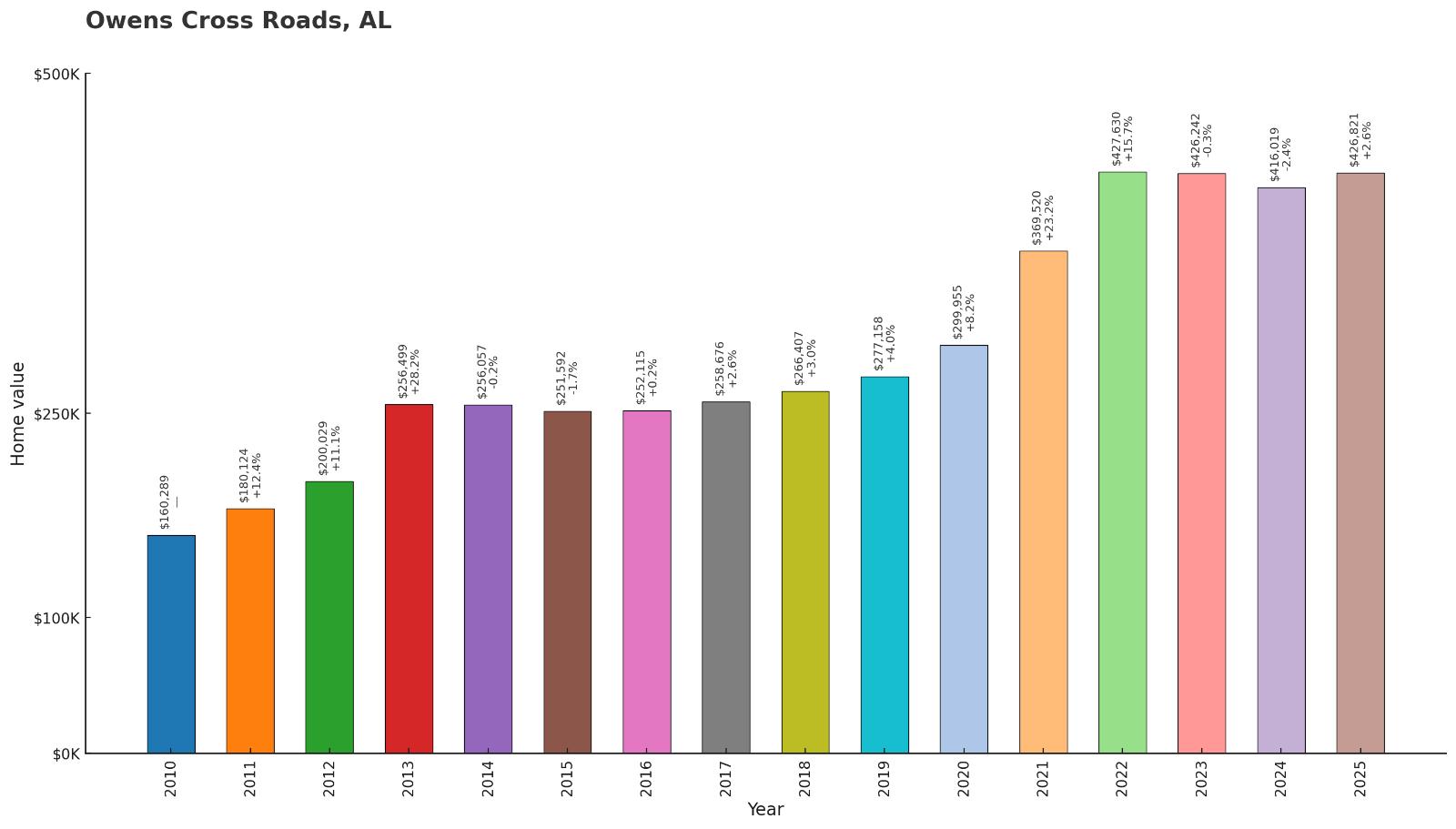
- 2010: $160,289
- 2011: $180,124
- 2012: $200,029
- 2013: $256,499
- 2014: $256,057
- 2015: $251,592
- 2016: $252,115
- 2017: $258,676
- 2018: $266,407
- 2019: $277,158
- 2020: $299,955
- 2021: $369,520
- 2022: $427,630
- 2023: $426,242
- 2024: $416,019
- 2025: $426,821
Owens Cross Roads has delivered exceptional appreciation since 2010, with home values increasing by 166% over the period. The community experienced a significant jump in 2013, followed by steady growth and a major acceleration between 2020 and 2022 when prices rose from $299,955 to $427,630. Current values at $426,821 reflect the premium buyers place on this Madison County community that combines rural character with proximity to Huntsville’s technology corridor.
Why Owens Cross Roads?
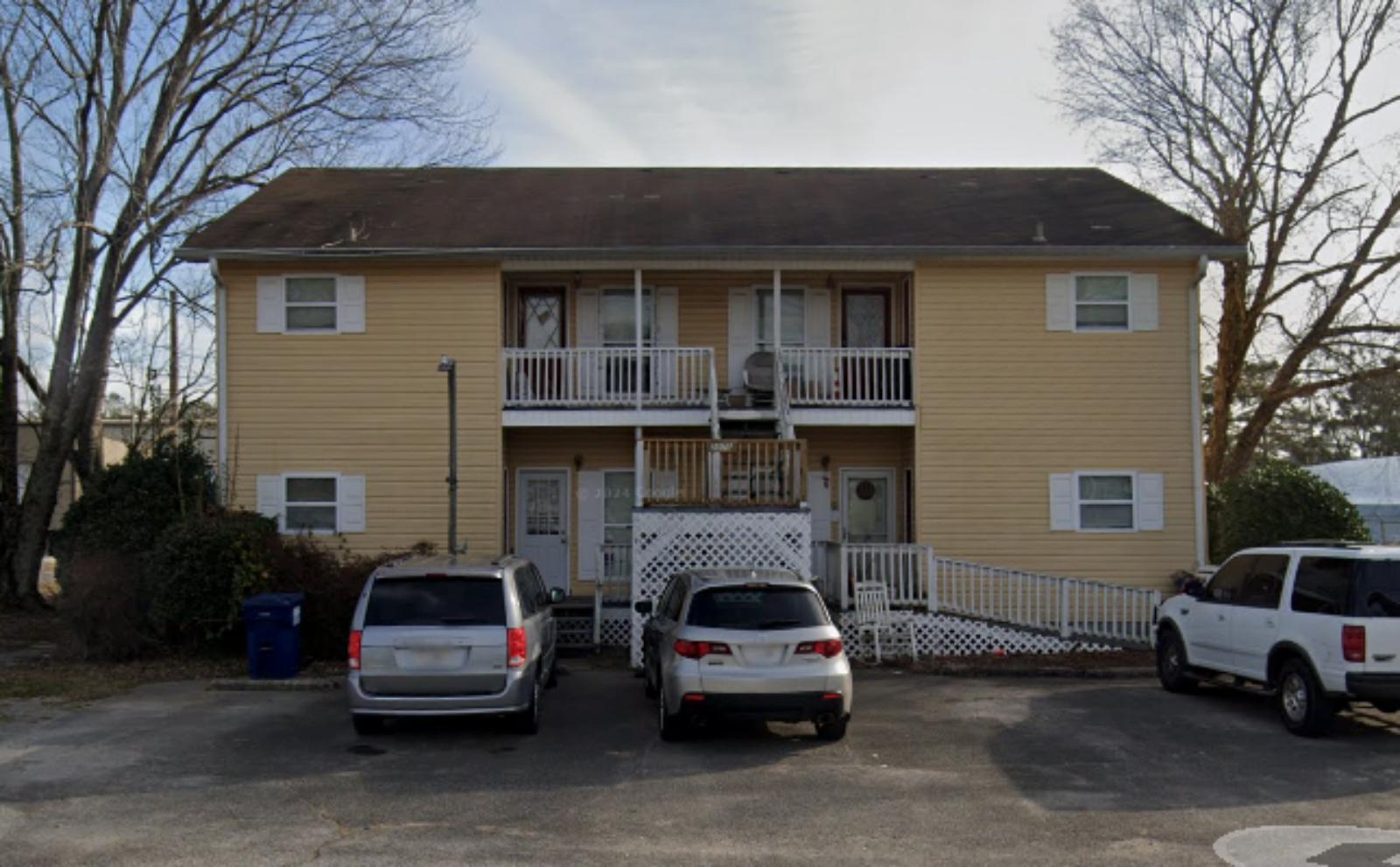
Why Are People Willing to Pay So Much to Live Here? What’s Special About It?
Owens Cross Roads attracts professionals and families seeking a rural lifestyle with easy access to Huntsville’s aerospace and technology employment opportunities. The community offers larger lot sizes, horse properties, and scenic views that provide a countryside atmosphere while maintaining suburban conveniences. Residents value the area’s low population density, excellent schools, and strong property values.
The town’s location in the Huntsville metro area provides access to high-paying technology jobs while offering a distinct rural identity. Owens Cross Roads appeals to buyers seeking custom homes, privacy, and natural beauty without sacrificing proximity to urban amenities. The community has successfully balanced growth with preservation of its rural character, creating a unique niche that commands premium prices.
How Owens Cross Roads Rose to Prominence
Owens Cross Roads was incorporated in 1967 but remained a rural community for most of its early history. The area was primarily agricultural, with small farms and rural homesteads defining the landscape. Limited development occurred until Huntsville’s aerospace industry began expanding and creating demand for suburban housing options.
Growth accelerated in the 1990s and 2000s as technology professionals discovered the area’s potential for larger lots and custom homes while maintaining reasonable commutes to Huntsville employers. The community’s emphasis on preserving rural character while accommodating high-quality residential development attracted affluent buyers seeking alternatives to conventional suburban subdivisions. Owens Cross Roads has maintained its appeal by balancing growth with preservation of open space and rural amenities.
3 Interesting Tidbits
- Aerospace Connection – Many residents work in Huntsville’s aerospace and defense industries, including NASA Marshall Space Flight Center and various technology companies.
- Equestrian Community – The town maintains a horse-friendly culture with numerous properties designed for equestrian activities and rural lifestyles.
- Rural Preservation – Owens Cross Roads has successfully maintained its rural character while accommodating growth, creating a unique suburban-rural hybrid community.
15. Hoover – 70% Home Price Increase Since 2010
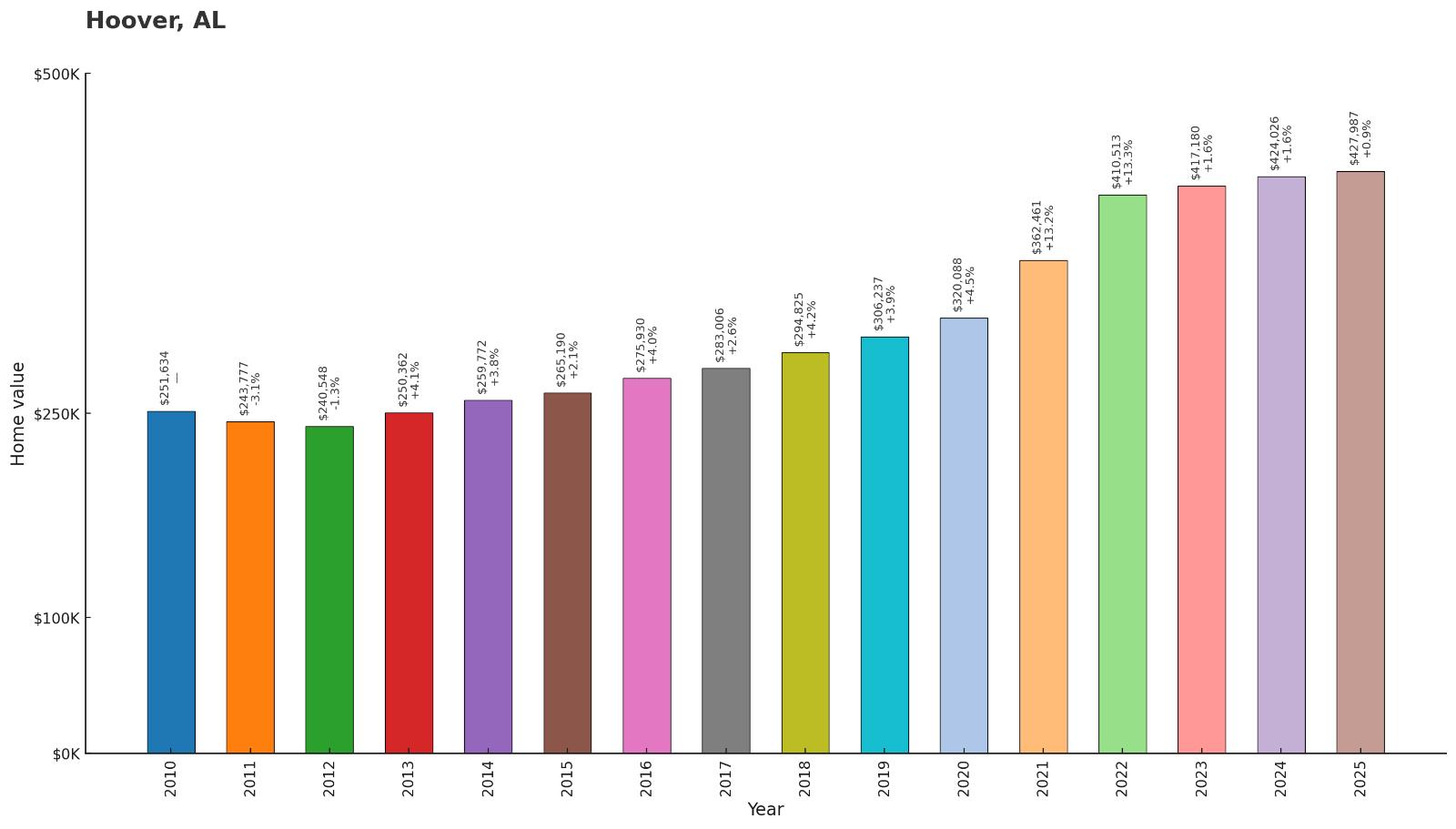
- 2010: $251,634
- 2011: $243,777
- 2012: $240,548
- 2013: $250,362
- 2014: $259,772
- 2015: $265,190
- 2016: $275,930
- 2017: $283,006
- 2018: $294,825
- 2019: $306,237
- 2020: $320,088
- 2021: $362,461
- 2022: $410,513
- 2023: $417,180
- 2024: $424,026
- 2025: $427,987
Hoover has shown steady appreciation since 2010, with home values increasing by 70% over the 15-year period. The community maintained consistent growth throughout most of the period, with acceleration between 2020 and 2022 when prices rose from $320,088 to $410,513. Current values at $427,987 reflect the sustained demand for this established Jefferson County suburb known for excellent schools and comprehensive amenities.
Why Hoover?
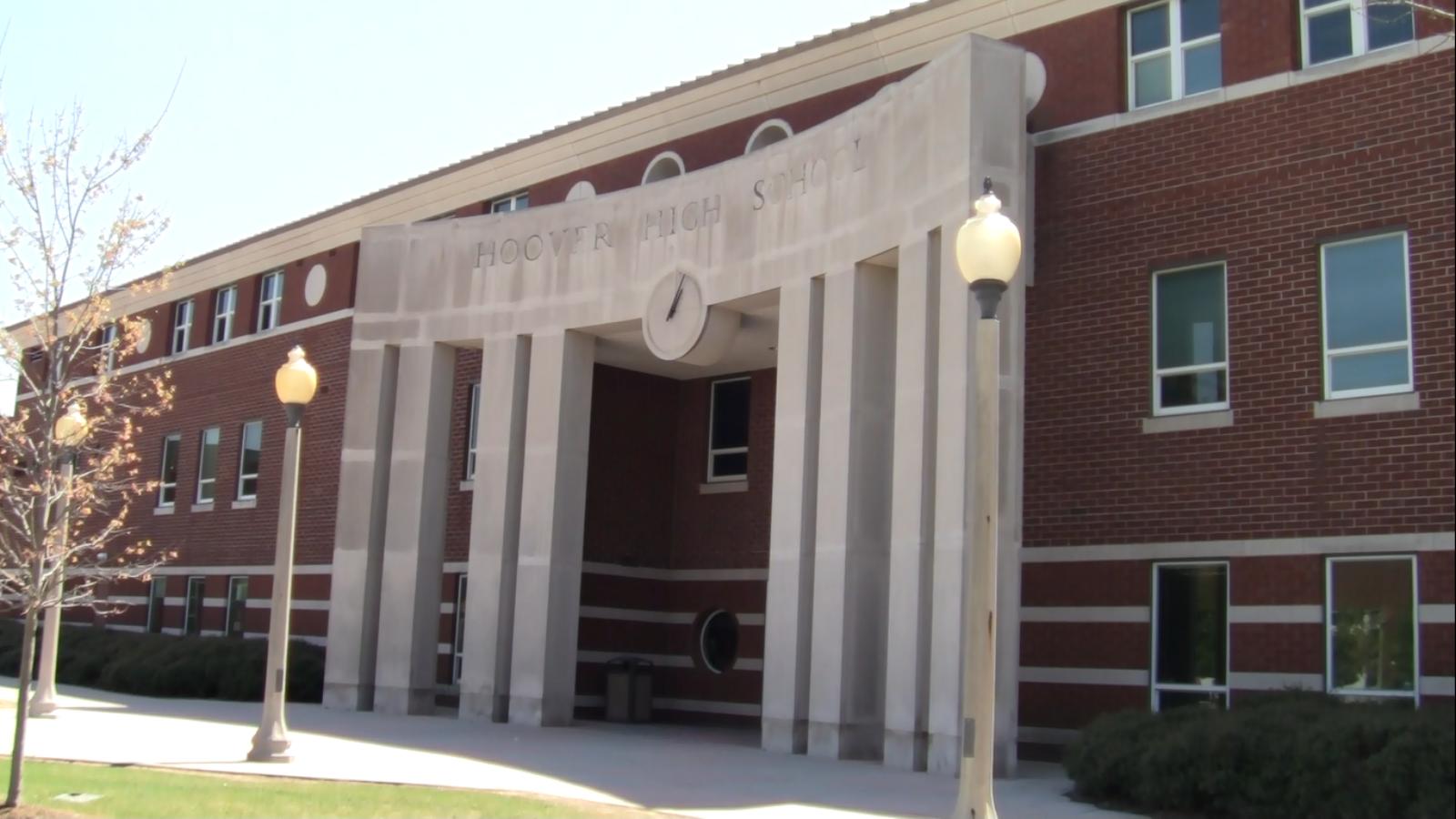
Why Are People Willing to Pay So Much to Live Here? What’s Special About It?
Hoover offers families a comprehensive suburban lifestyle with top-rated schools, extensive shopping and dining options, and numerous recreational facilities. The city features the Riverchase Galleria, one of the Southeast’s largest shopping centers, along with excellent municipal services and well-maintained neighborhoods. Residents appreciate the city’s commitment to quality infrastructure and community amenities.
The community provides easy access to Birmingham employment while maintaining its own economic base and identity. Hoover’s size allows for diverse housing options, from starter homes to luxury estates, accommodating various life stages and income levels. The combination of educational excellence, retail convenience, and recreational opportunities justifies premium housing costs for many families seeking comprehensive suburban living.
How Hoover Rose to Prominence
Hoover was incorporated in 1967 as Birmingham’s suburban expansion pushed south into Jefferson and Shelby counties. The city was named after William Hoover, a local landowner and developer who promoted residential development in the area. Early growth focused on providing quality neighborhoods and amenities for middle-class families seeking alternatives to older urban areas.
The community’s transformation accelerated with the development of the Riverchase Galleria in the 1980s, which established Hoover as a major retail and commercial center. This economic anchor attracted additional businesses, restaurants, and services that created a self-contained suburban city. Hoover’s continued investment in schools, parks, and infrastructure has maintained its reputation as one of Alabama’s premier suburban communities.
3 Interesting Tidbits
- Shopping Destination – The Riverchase Galleria is one of the largest shopping centers in the Southeast, making Hoover a regional retail destination.
- School Excellence – Hoover City Schools consistently rank among Alabama’s top public school systems, particularly known for competitive athletics and academic programs.
- Metropolitan Feel – Despite being a suburb, Hoover has developed into a major city with its own economic base, cultural amenities, and municipal services.
14. Gulf Shores – 120% Home Price Increase Since 2010

- 2010: $207,193
- 2011: $197,816
- 2012: $206,768
- 2013: $222,238
- 2014: $232,246
- 2015: $246,776
- 2016: $260,552
- 2017: $272,910
- 2018: $291,490
- 2019: $313,161
- 2020: $330,644
- 2021: $407,744
- 2022: $477,412
- 2023: $484,963
- 2024: $469,677
- 2025: $455,208
Gulf Shores has more than doubled in value since 2010, with home prices increasing by 120% over the period. The community showed steady growth through 2020, then accelerated dramatically with prices jumping from $330,644 to $477,412 between 2020 and 2022 before moderating slightly. Current values at $455,208 reflect the premium associated with this popular coastal destination that combines beach living with year-round community amenities.
Why Gulf Shores?
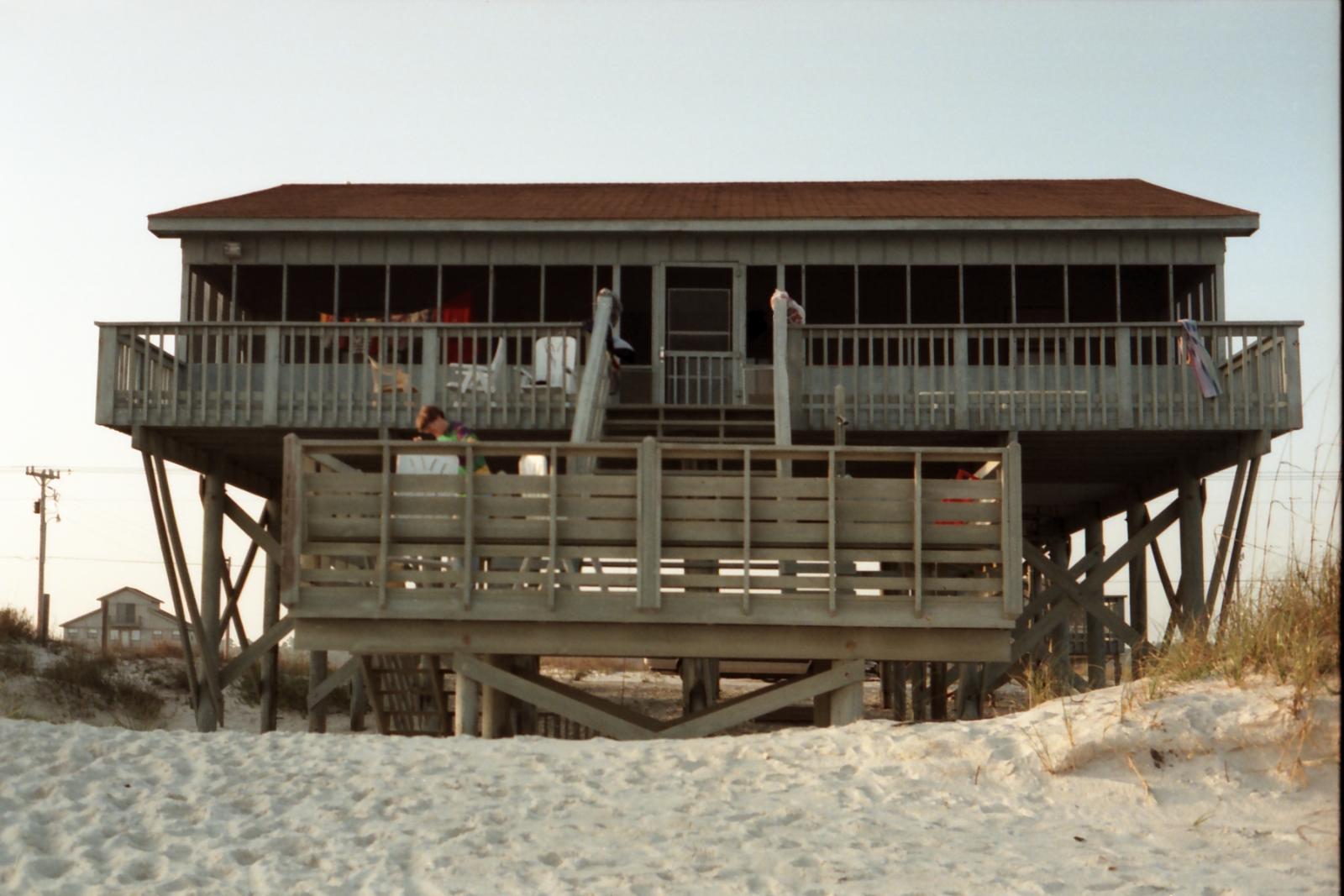
Why Are People Willing to Pay So Much to Live Here? What’s Special About It?
Gulf Shores offers direct access to beautiful white-sand beaches and Gulf of Mexico waters that attract millions of visitors annually. The community combines year-round coastal living with vacation rental investment opportunities that can generate significant income. Residents enjoy beach activities, water sports, and a laid-back coastal lifestyle that’s increasingly rare along developed coastlines.
The city has developed comprehensive amenities including golf courses, restaurants, shopping, and cultural events that create a complete coastal community beyond just beach access. Gulf Shores appeals to retirees, vacation homeowners, and investors seeking coastal property with strong rental potential. The limited supply of beachfront and near-beach properties drives sustained demand and price appreciation despite market fluctuations.
How Gulf Shores Rose to Prominence
Gulf Shores was incorporated in 1956 but remained a small fishing and tourism community for several decades. The area’s beautiful beaches and fishing opportunities attracted visitors, but development was limited and the population remained small. Early growth focused on basic tourism infrastructure and seasonal businesses.
The transformation began in the 1980s and accelerated through the 2000s as developers recognized the area’s potential for large-scale resort and residential development. Hurricane damage periodically setback development, but the community consistently rebuilt with improved infrastructure and amenities. Gulf Shores has evolved from a small beach town into a major coastal resort destination while maintaining its appeal for permanent residents seeking beach living.
3 Interesting Tidbits
- Music Festival – Gulf Shores hosts the annual Hangout Music Festival, one of the Southeast’s premier music events that brings national acts to the beach.
- Fishing Heritage – The area remains famous for deep-sea fishing, with charter boats and fishing tournaments continuing to attract enthusiasts year-round.
- State Park – Gulf State Park provides over 6,000 acres of protected coastal habitat, beaches, and recreational facilities within the city limits.
13. Arley – 76% Home Price Increase Since 2010

- 2010: $261,439
- 2011: $254,258
- 2012: $257,408
- 2013: $251,779
- 2014: $245,690
- 2015: $238,604
- 2016: $246,864
- 2017: $272,707
- 2018: $279,042
- 2019: $283,806
- 2020: $304,850
- 2021: $375,266
- 2022: $430,243
- 2023: $428,710
- 2024: $440,824
- 2025: $459,956
Arley has shown strong appreciation since 2010, with home values increasing by 76% over the period despite experiencing a decline through 2015. The most dramatic growth occurred between 2020 and 2022, when prices surged from $304,850 to $430,243. Current values at $459,956 reflect renewed interest in this Winston County community that offers natural beauty and outdoor recreation opportunities.
Why Arley?

Why Are People Willing to Pay So Much to Live Here? What’s Special About It?
Arley offers buyers access to some of Alabama’s most pristine natural areas, including nearby Bankhead National Forest and the Sipsey Wilderness. The community appeals to outdoor enthusiasts seeking hiking, fishing, hunting, and water recreation opportunities in a rural mountain setting. Residents value the area’s natural beauty, clean air, and peaceful environment away from urban development.
The town’s location along the Sipsey Fork provides excellent fishing and canoeing opportunities, while the surrounding forests offer extensive trails and wildlife viewing. Arley attracts retirees, vacation homeowners, and families seeking authentic rural living with abundant outdoor recreation. The combination of natural amenities and relatively affordable mountain property creates strong appeal for buyers seeking escape from urban areas.
How Arley Rose to Prominence
Arley was established in the late 1800s as a small agricultural and timber community in the foothills of Alabama’s Appalachian region. The town remained primarily rural throughout most of its history, with logging, farming, and small-scale manufacturing providing limited economic activity. The area’s natural beauty attracted some visitors, but development remained minimal.
The community’s transformation began in recent decades as outdoor recreation gained popularity and people began seeking rural retreats near wilderness areas. Arley’s proximity to Bankhead National Forest and the Sipsey Wilderness made it attractive to buyers seeking natural amenities and outdoor recreation opportunities. The town has managed to preserve its rural character while accommodating modest growth from buyers seeking mountain living and outdoor recreation access.
3 Interesting Tidbits
- Wilderness Access – Arley provides convenient access to the Sipsey Wilderness, Alabama’s only federally designated wilderness area with pristine forests and waterfalls.
- River Town – The community sits along the Sipsey Fork, which offers excellent fishing, canoeing, and swimming opportunities in a natural mountain setting.
- Forest Gateway – Bankhead National Forest surrounds the area, providing over 180,000 acres of public land for hiking, hunting, and outdoor recreation.
12. Dauphin Island – 57% Home Price Increase Since 2010
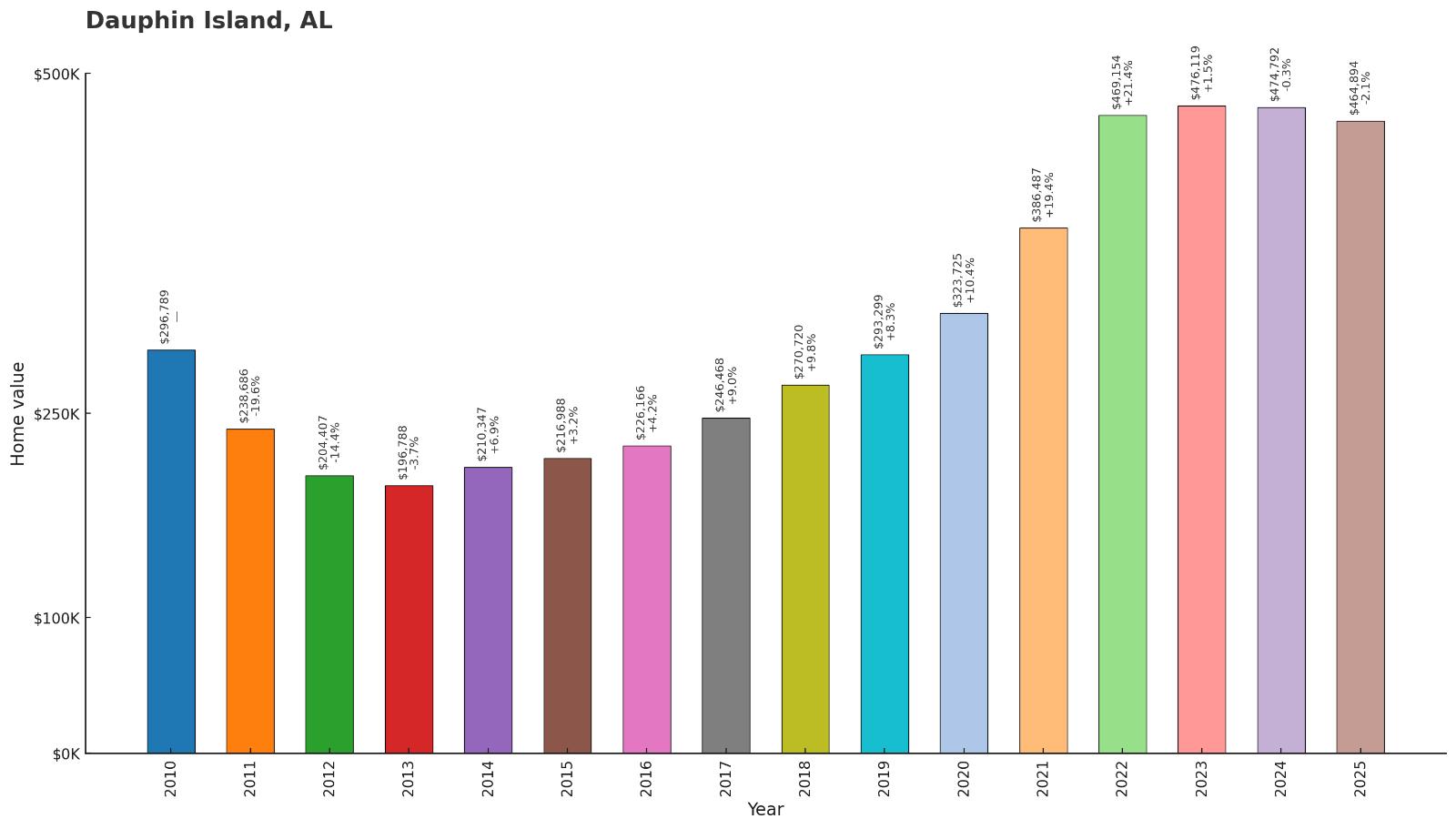
- 2010: $296,789
- 2011: $238,686
- 2012: $204,407
- 2013: $196,788
- 2014: $210,347
- 2015: $216,988
- 2016: $226,166
- 2017: $246,468
- 2018: $270,720
- 2019: $293,299
- 2020: $323,725
- 2021: $386,487
- 2022: $469,154
- 2023: $476,119
- 2024: $474,792
- 2025: $464,894
Dauphin Island has shown remarkable resilience, with home values increasing by 57% since 2010 despite significant volatility in the early years. The community experienced major price declines through 2013, followed by steady recovery and dramatic acceleration between 2020 and 2022. Current values at $464,894 reflect the premium associated with this unique barrier island that offers both Gulf and bay waterfront opportunities.
Why Dauphin Island?

Why Are People Willing to Pay So Much to Live Here? What’s Special About It?
Dauphin Island offers a unique barrier island lifestyle with access to both Gulf of Mexico beaches and protected bay waters. The community provides exceptional fishing, birding, and wildlife viewing opportunities along with historic sites and natural preserves. Residents enjoy a relaxed coastal atmosphere with less commercial development than other beach destinations.
The island’s limited developable land creates scarcity that supports property values despite periodic hurricane damage. Dauphin Island appeals to buyers seeking authentic coastal living, investment properties, and vacation homes with diverse water recreation opportunities. The combination of natural beauty, wildlife habitat, and relative seclusion attracts buyers willing to pay premiums for unique waterfront properties.
How Dauphin Island Rose to Prominence
Dauphin Island has a rich history dating back to French colonial settlement in the early 1700s, serving as the first capital of French Louisiana. The island played strategic roles in various conflicts and served as a fishing and shipping community throughout the 19th and early 20th centuries. Hurricane damage periodically impacted development, but the community consistently rebuilt.
Modern development began in the mid-20th century as the island became accessible by bridge and attracted visitors seeking beach recreation and fishing opportunities. Dauphin Island’s emergence as a premier birdwatching destination, combined with its historic sites and natural preserves, created diverse appeal beyond traditional beach tourism. The community has balanced development with environmental protection, maintaining its unique character as both a residential and recreational destination.
3 Interesting Tidbits
- Birding Paradise – Dauphin Island is considered one of the premier bird watching destinations in North America, especially during spring and fall migration seasons.
- Historic Fort – Fort Gaines, a Civil War-era fort, sits on the eastern end of the island and played a crucial role in the Battle of Mobile Bay.
- Barrier Island – As a barrier island, Dauphin Island provides critical protection for the mainland coast while offering unique ecosystems and wildlife habitat.
11. Fairhope – 111% Home Price Increase Since 2010
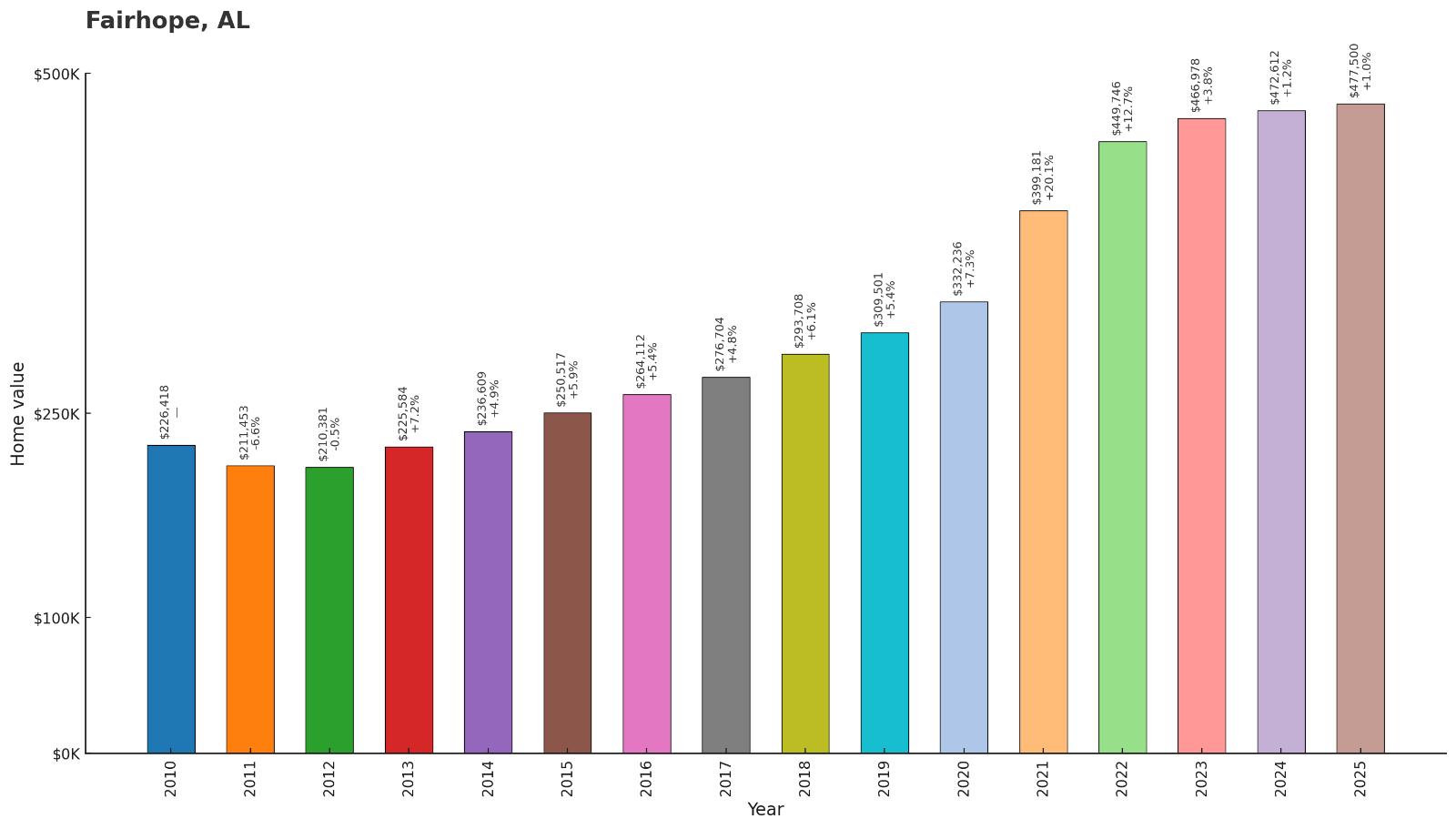
- 2010: $226,418
- 2011: $211,453
- 2012: $210,381
- 2013: $225,584
- 2014: $236,609
- 2015: $250,517
- 2016: $264,112
- 2017: $276,704
- 2018: $293,708
- 2019: $309,501
- 2020: $332,236
- 2021: $399,181
- 2022: $449,746
- 2023: $466,978
- 2024: $472,612
- 2025: $477,500
Fairhope has more than doubled in value since 2010, with home prices increasing by 111% over the period. The community showed steady growth throughout most of the period, with significant acceleration between 2020 and 2022 when prices rose from $332,236 to $449,746. Current values at $477,500 reflect the sustained demand for this charming Baldwin County city known for its arts community and waterfront location.
Why Fairhope?
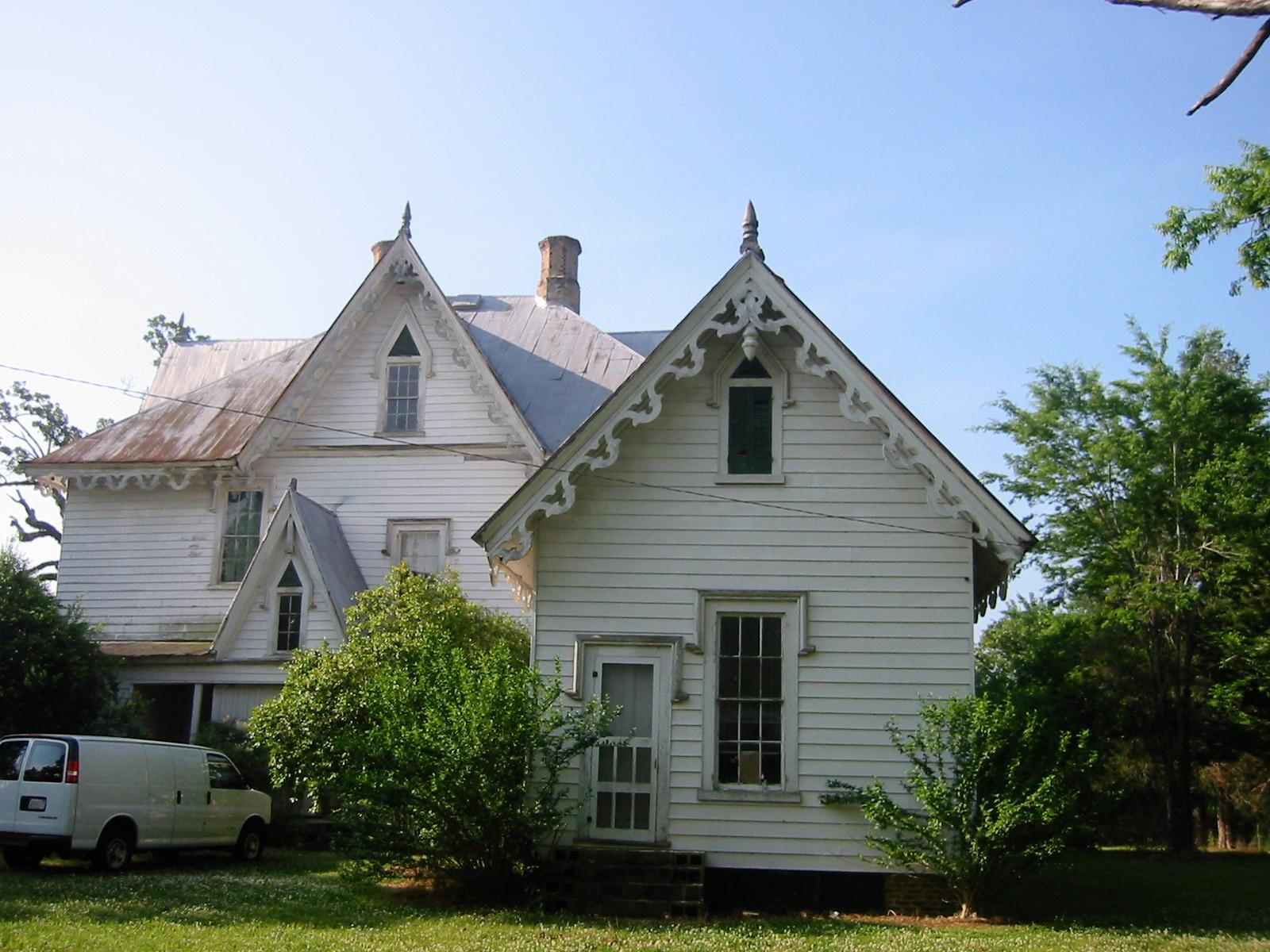
Why Are People Willing to Pay So Much to Live Here? What’s Special About It?
Fairhope offers a unique combination of arts culture, historic charm, and Mobile Bay waterfront access that creates a distinctive coastal community. The downtown area features art galleries, boutique shops, and restaurants that foster a vibrant cultural scene. Residents appreciate the city’s commitment to preserving historic character while supporting artistic and cultural activities.
The community provides beautiful bay views, recreational opportunities, and a walkable downtown that appeals to retirees, artists, and families seeking small-town charm with cultural amenities. Fairhope’s reputation as an arts destination and its scenic waterfront location create strong demand from buyers seeking unique coastal living. The city’s careful growth management and historic preservation help maintain property values and community character.
How Fairhope Rose to Prominence
Fairhope was founded in 1894 as a utopian single-tax colony based on the economic theories of Henry George. The community was established by Midwestern settlers seeking to create an ideal society with shared land ownership and cooperative economic principles. While the utopian experiment evolved, Fairhope retained its progressive character and commitment to community cooperation.
The city’s transformation into an arts destination began in the mid-20th century as artists and writers discovered its scenic waterfront location and supportive community atmosphere. Fairhope’s downtown revitalization efforts, combined with its historic character and bay location, established it as one of Alabama’s most desirable small cities. The community has successfully balanced growth with preservation of its unique character and cultural identity.
3 Interesting Tidbits
- Utopian Origins – Fairhope was founded in 1894 as a single-tax colony based on Henry George’s economic theories, creating a unique community structure that persists today.
- Arts Destination – The city has developed into a major arts community with numerous galleries, studios, and cultural events that attract visitors and residents.
- Jubilee Phenomenon – Mobile Bay occasionally experiences “jubilees” where fish and crabs move to shallow water, creating unique fishing opportunities that Fairhope residents enjoy.
10. Lake Purdy – 78% Home Price Increase Since 2010
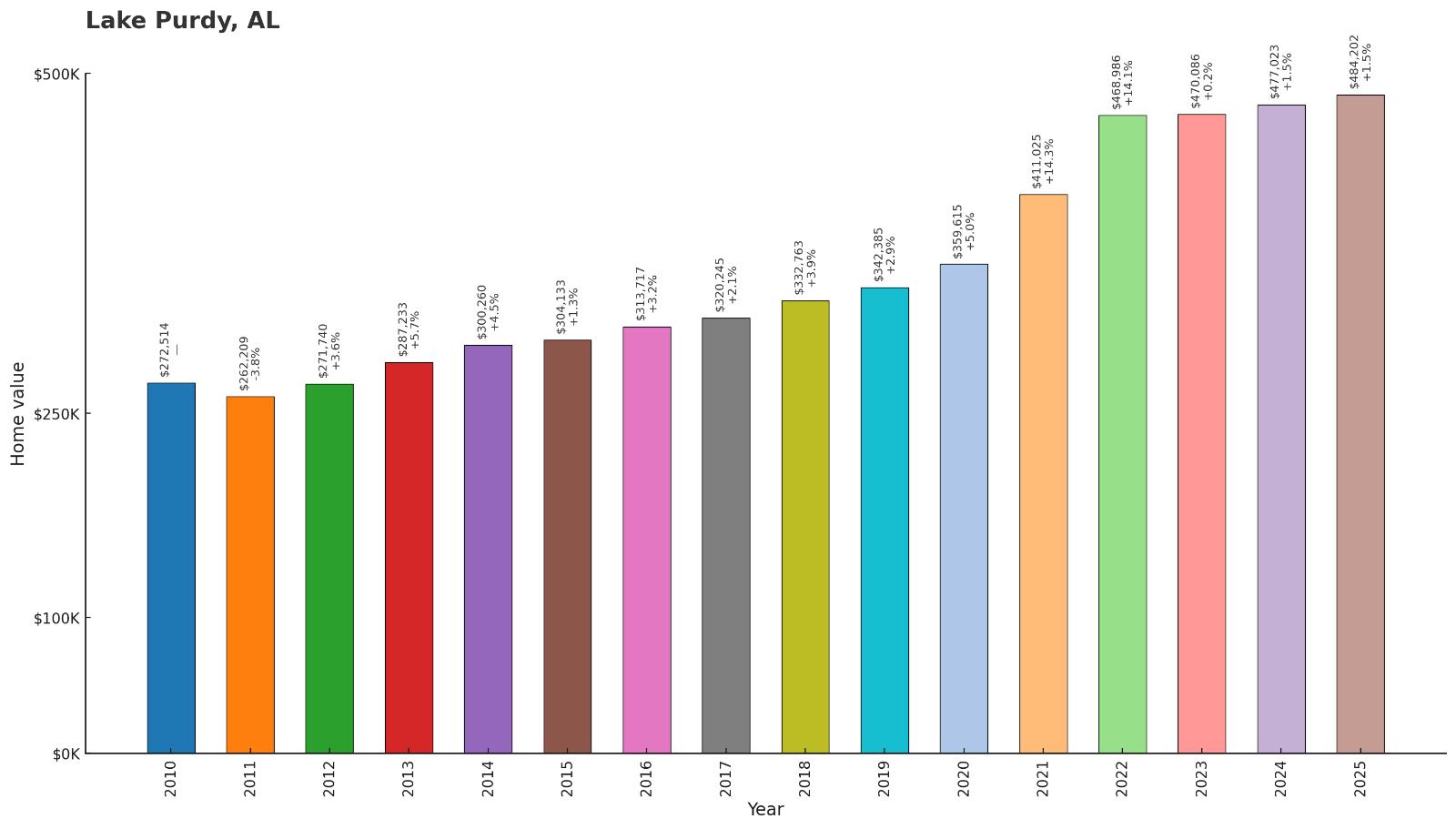
- 2010: $272,514
- 2011: $262,209
- 2012: $271,740
- 2013: $287,233
- 2014: $300,260
- 2015: $304,133
- 2016: $313,717
- 2017: $320,245
- 2018: $332,763
- 2019: $342,385
- 2020: $359,615
- 2021: $411,025
- 2022: $468,986
- 2023: $470,086
- 2024: $477,023
- 2025: $484,202
Lake Purdy has shown consistent appreciation since 2010, with home values increasing by 78% over the period. The community maintained steady growth throughout the period, with acceleration between 2020 and 2022 when prices rose from $359,615 to $468,986. Current values at $484,202 reflect the premium associated with this exclusive lakefront community that offers water recreation with proximity to Birmingham.
Why Lake Purdy?

Why Are People Willing to Pay So Much to Live Here? What’s Special About It?
Lake Purdy offers exclusive lakefront living with direct access to a pristine 800-acre reservoir that serves Birmingham’s water supply. The community features luxury homes with private docks, scenic water views, and recreational opportunities including boating, fishing, and swimming. Residents value the area’s privacy, natural beauty, and proximity to Birmingham employment centers.
The lake’s status as a protected watershed creates strict development standards that preserve water quality and limit density, maintaining the area’s exclusive character. Lake Purdy appeals to affluent buyers seeking waterfront luxury homes with recreational amenities and convenient access to urban employment. The combination of natural beauty, recreational opportunities, and exclusivity justifies premium pricing for discerning buyers.
How Lake Purdy Rose to Prominence
Lake Purdy was created in the 1930s as a water supply reservoir for Birmingham, with the surrounding land carefully managed to protect water quality. Early development was limited and controlled, with only select properties allowed around the lake perimeter. The area remained relatively undeveloped for several decades due to watershed protection requirements.
Upscale residential development began in the 1970s and 1980s as Birmingham’s affluent residents discovered the lake’s potential for luxury waterfront homes. The community’s exclusivity was maintained through strict building standards and environmental controls that preserved the area’s natural beauty. Lake Purdy has remained one of Birmingham’s most prestigious residential areas, attracting buyers seeking the ultimate combination of luxury, privacy, and water recreation.
3 Interesting Tidbits
- Water Supply – Lake Purdy serves as a primary water source for Birmingham, with strict watershed protection that maintains exceptional water quality and limits development.
- Exclusive Community – The area features some of Birmingham’s most expensive homes, with many properties offering private docks and waterfront amenities.
- Recreation Paradise – Despite being a water supply reservoir, Lake Purdy allows recreational activities including boating, fishing, and swimming for residents with access.
9. Crane Hill – 113% Home Price Increase Since 2010
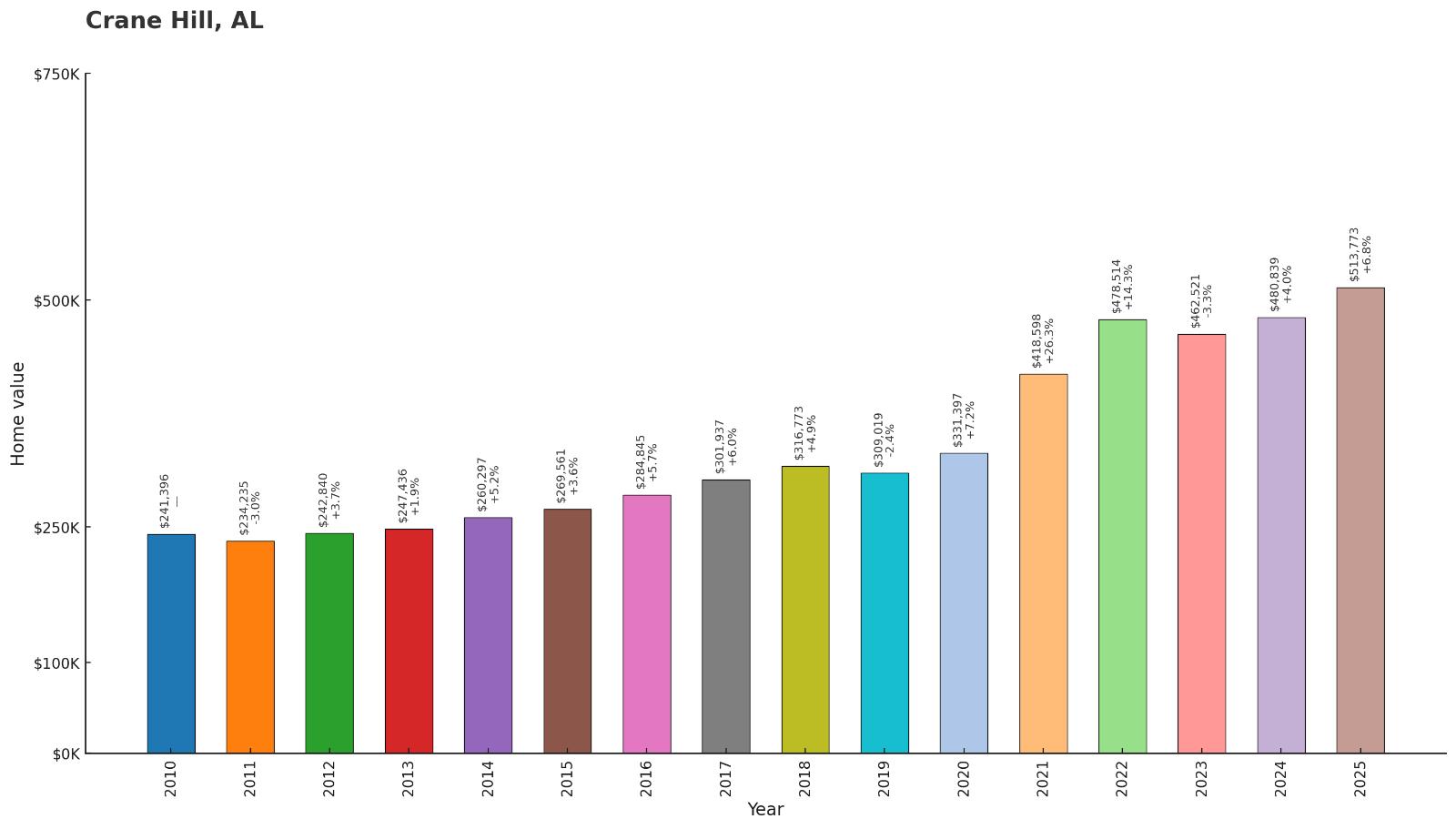
- 2010: $241,396
- 2011: $234,235
- 2012: $242,840
- 2013: $247,436
- 2014: $260,297
- 2015: $269,561
- 2016: $284,845
- 2017: $301,937
- 2018: $316,773
- 2019: $309,019
- 2020: $331,397
- 2021: $418,598
- 2022: $478,514
- 2023: $462,521
- 2024: $480,839
- 2025: $513,773
Crane Hill has more than doubled in value since 2010, with home prices increasing by 113% over the period. The community showed steady growth through 2020, then experienced dramatic acceleration with prices jumping from $331,397 to $478,514 between 2020 and 2022. Current values at $513,773 reflect the strong demand for this Cullman County community that offers scenic lake living and rural charm.
Why Crane Hill?

Why Are People Willing to Pay So Much to Live Here? What’s Special About It?
Crane Hill offers buyers access to Lewis Smith Lake, one of Alabama’s clearest and most pristine recreational lakes with excellent fishing and water sports opportunities. The community provides a perfect combination of lakefront living and rural mountain scenery in north Alabama’s hill country. Residents enjoy cooler temperatures, clean air, and abundant outdoor recreation in a peaceful setting.
The area appeals to retirees, vacation homeowners, and families seeking authentic rural living with modern lake amenities. Crane Hill’s location provides relative seclusion while maintaining reasonable access to larger cities for employment and services. The combination of natural beauty, recreational opportunities, and rural character creates strong appeal for buyers seeking escape from urban development and suburban sprawl.
How Crane Hill Rose to Prominence
Crane Hill developed as a small rural community in Cullman County, with agriculture and timber providing the primary economic base for most of its history. The area remained sparsely populated and primarily rural until the creation of Lewis Smith Lake by Alabama Power in the 1960s transformed the region’s appeal and development potential.
The community’s transformation accelerated as people discovered Lewis Smith Lake’s exceptional water clarity and recreational opportunities. Crane Hill became a popular destination for lake homes, retirement properties, and vacation retreats as buyers sought natural beauty and outdoor recreation. The area has managed to preserve its rural character while accommodating growth from buyers attracted to pristine lake living and mountain scenery.
3 Interesting Tidbits
- Clearest Lake – Lewis Smith Lake is considered one of the clearest lakes in Alabama, with visibility often exceeding 20 feet due to strict watershed management.
- Mountain Setting – Crane Hill sits in Alabama’s Appalachian foothills, providing scenic mountain views and cooler temperatures than other parts of the state.
- Fishing Paradise – The lake is renowned for excellent fishing, particularly for spotted bass, largemouth bass, and various other game fish species.
8. Dadeville – 123% Home Price Increase Since 2010
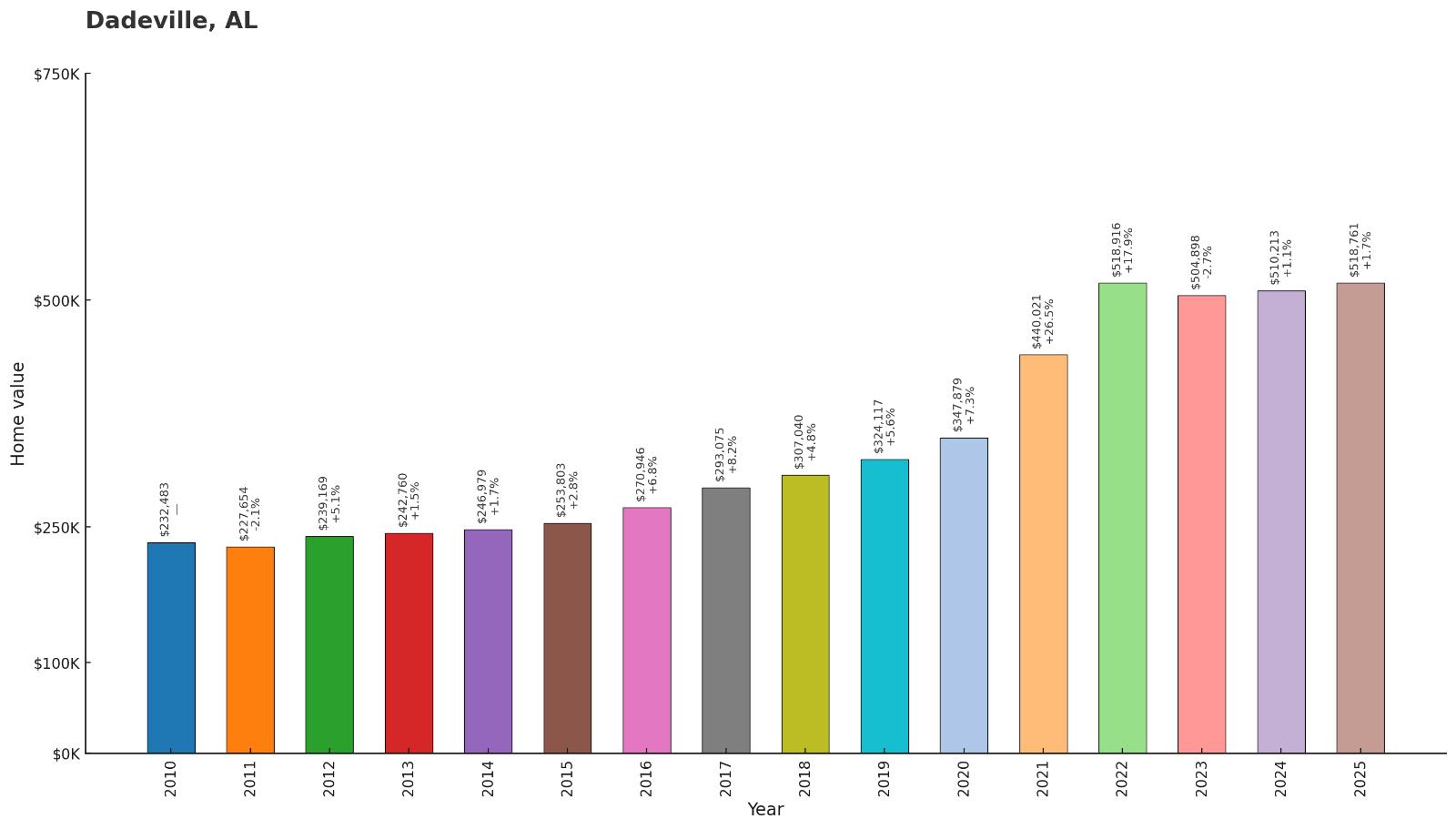
- 2010: $232,483
- 2011: $227,654
- 2012: $239,169
- 2013: $242,760
- 2014: $246,979
- 2015: $253,803
- 2016: $270,946
- 2017: $293,075
- 2018: $307,040
- 2019: $324,117
- 2020: $347,879
- 2021: $440,021
- 2022: $518,916
- 2023: $504,898
- 2024: $510,213
- 2025: $518,761
Dadeville has delivered exceptional appreciation since 2010, with home values increasing by 123% over the period. The community showed consistent growth throughout the period, with dramatic acceleration between 2020 and 2022 when prices surged from $347,879 to $518,916. Current values at $518,761 reflect the premium associated with this Lake Martin community that serves as the county seat while offering premier waterfront recreation.
Why Dadeville?

Why Are People Willing to Pay So Much to Live Here? What’s Special About It?
Dadeville offers prime access to Lake Martin, one of Alabama’s largest and most prestigious recreational lakes with 750 miles of pristine shoreline. The town combines county seat amenities with waterfront recreation, providing government services, historic downtown areas, and excellent lake access. Residents enjoy world-class fishing, boating, and water sports in a scenic setting with full-service community infrastructure.
The community appeals to diverse buyers including permanent residents, vacation homeowners, and Auburn University affiliates seeking lake properties within reasonable commuting distance. Dadeville’s role as Tallapoosa County seat provides stability and services while its Lake Martin location offers recreational opportunities that rival more expensive markets. The combination of government employment, recreational amenities, and waterfront access creates sustained demand from multiple buyer segments.
How Dadeville Rose to Prominence
Dadeville was incorporated in 1837 and named after Major Francis Langhorne Dade, who died in the Second Seminole War. The town served as the county seat of Tallapoosa County and developed as a regional commercial and government center throughout the 19th and early 20th centuries. Agriculture and small-scale manufacturing provided the economic base for most of the town’s history.
The community’s transformation began with the creation of Lake Martin by Alabama Power in the 1920s, which dramatically changed the area’s recreational potential and appeal. Dadeville evolved from a typical small Southern county seat into a premier lake community while maintaining its government and commercial functions. The town has successfully balanced its traditional role as a county seat with its emergence as a recreational destination and residential community.
3 Interesting Tidbits
- Lake Martin Gateway – Dadeville serves as a primary access point to Lake Martin, with marinas, boat ramps, and lake services concentrated in the area.
- County Seat Heritage – As the Tallapoosa County seat since 1837, Dadeville maintains government buildings and services that provide economic stability.
- Auburn Connection – The town’s proximity to Auburn University makes it popular with faculty, staff, and alumni seeking lake properties with reasonable commutes.
7. Homewood – 109% Home Price Increase Since 2010
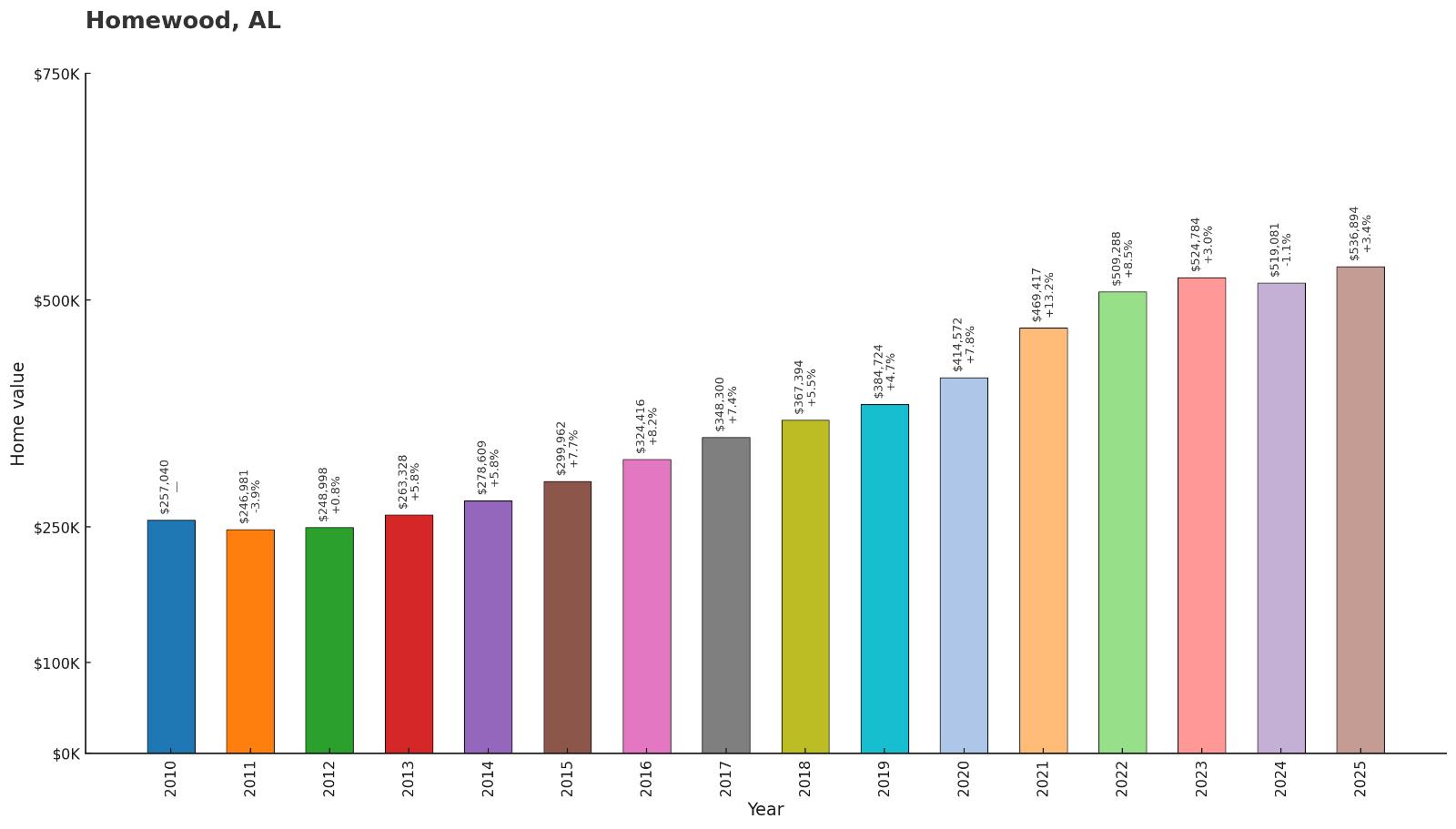
- 2010: $257,040
- 2011: $246,981
- 2012: $248,998
- 2013: $263,328
- 2014: $278,609
- 2015: $299,962
- 2016: $324,416
- 2017: $348,300
- 2018: $367,394
- 2019: $384,724
- 2020: $414,572
- 2021: $469,417
- 2022: $509,288
- 2023: $524,784
- 2024: $519,081
- 2025: $536,894
Homewood has more than doubled in value since 2010, with home prices increasing by 109% over the period. The community showed remarkable consistency with steady growth every year through 2023, including significant acceleration between 2020 and 2022. Current values at $536,894 reflect the premium associated with this prestigious Jefferson County suburb known for excellent schools and prime location adjacent to Birmingham.
Why Homewood?
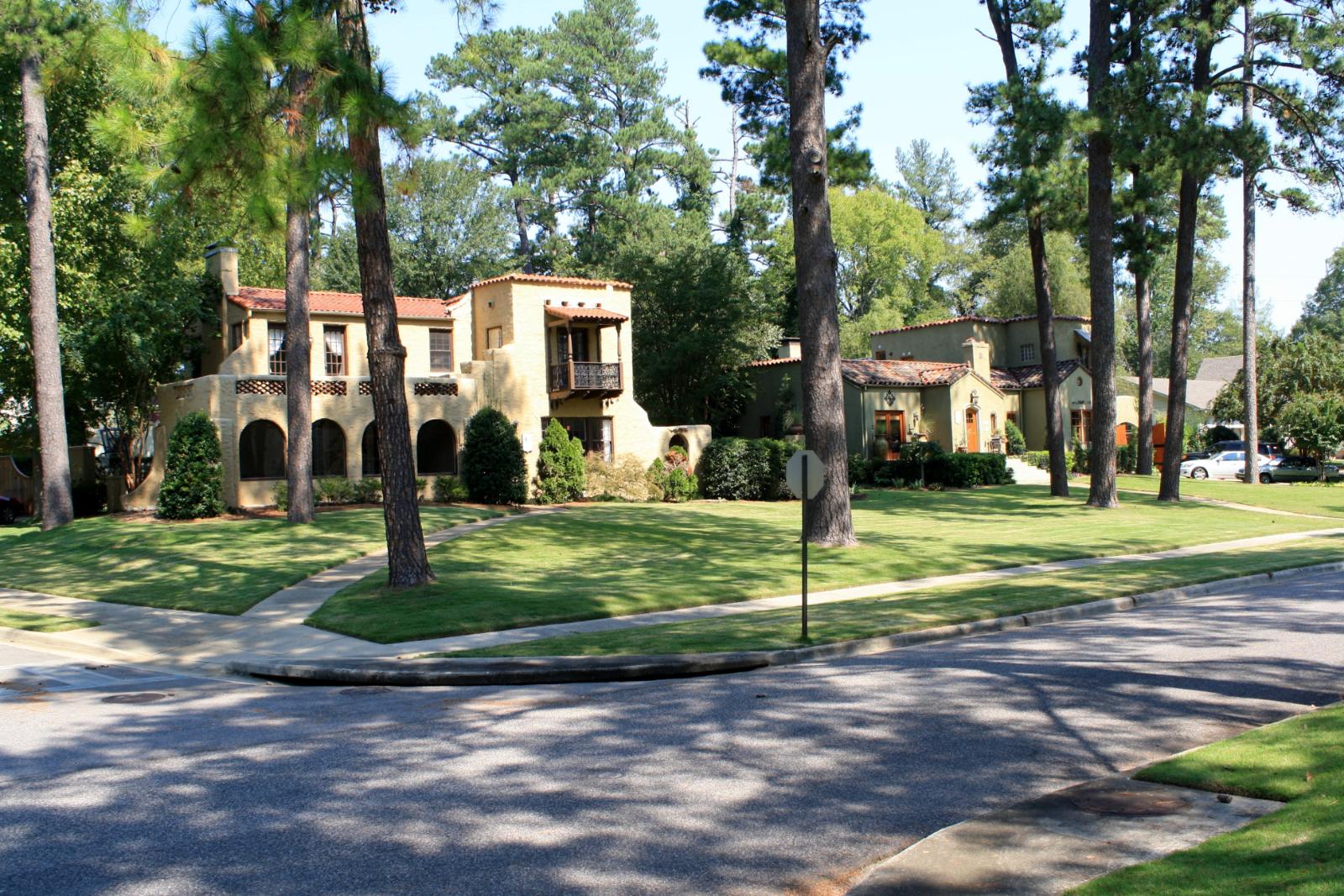
Why Are People Willing to Pay So Much to Live Here? What’s Special About It?
Homewood offers families one of Alabama’s most prestigious addresses with top-rated schools, walkable neighborhoods, and immediate access to Birmingham’s employment and cultural opportunities. The community features tree-lined streets, historic homes, and a vibrant downtown area with shops and restaurants. Residents appreciate the city’s commitment to maintaining neighborhood character while providing excellent municipal services.
The area’s “over-the-mountain” location provides cooler temperatures and scenic views while maintaining urban convenience and walkability. Homewood appeals to professionals, executives, and families seeking the ultimate combination of suburban amenities and urban access. The community’s reputation for educational excellence, property maintenance, and civic engagement creates sustained demand that justifies premium housing costs.
How Homewood Rose to Prominence
Homewood was incorporated in 1926 as Birmingham’s suburban expansion pushed south over Red Mountain. The community was planned as an upscale residential suburb featuring tree-lined streets, quality homes, and convenient access to Birmingham’s business district. Early development focused on attracting middle and upper-middle-class families seeking alternatives to urban neighborhoods.
The city’s transformation into one of Alabama’s most prestigious communities occurred gradually through careful planning and commitment to quality. Homewood’s emphasis on education, historic preservation, and neighborhood character attracted affluent residents and established its reputation for excellence. The community has maintained its exclusive character while adapting to changing demographics and housing preferences over multiple generations.
3 Interesting Tidbits
- School Excellence – Homewood City Schools consistently rank among Alabama’s top public school systems, with graduates regularly attending prestigious universities nationwide.
- Walkable Community – The city features walkable neighborhoods with sidewalks, parks, and local businesses that create a pedestrian-friendly environment rare in Alabama.
- Historic Character – Many neighborhoods feature homes from the 1920s and 1930s that have been carefully preserved and maintained, creating distinctive architectural character.
6. Vestavia Hills – 76% Home Price Increase Since 2010
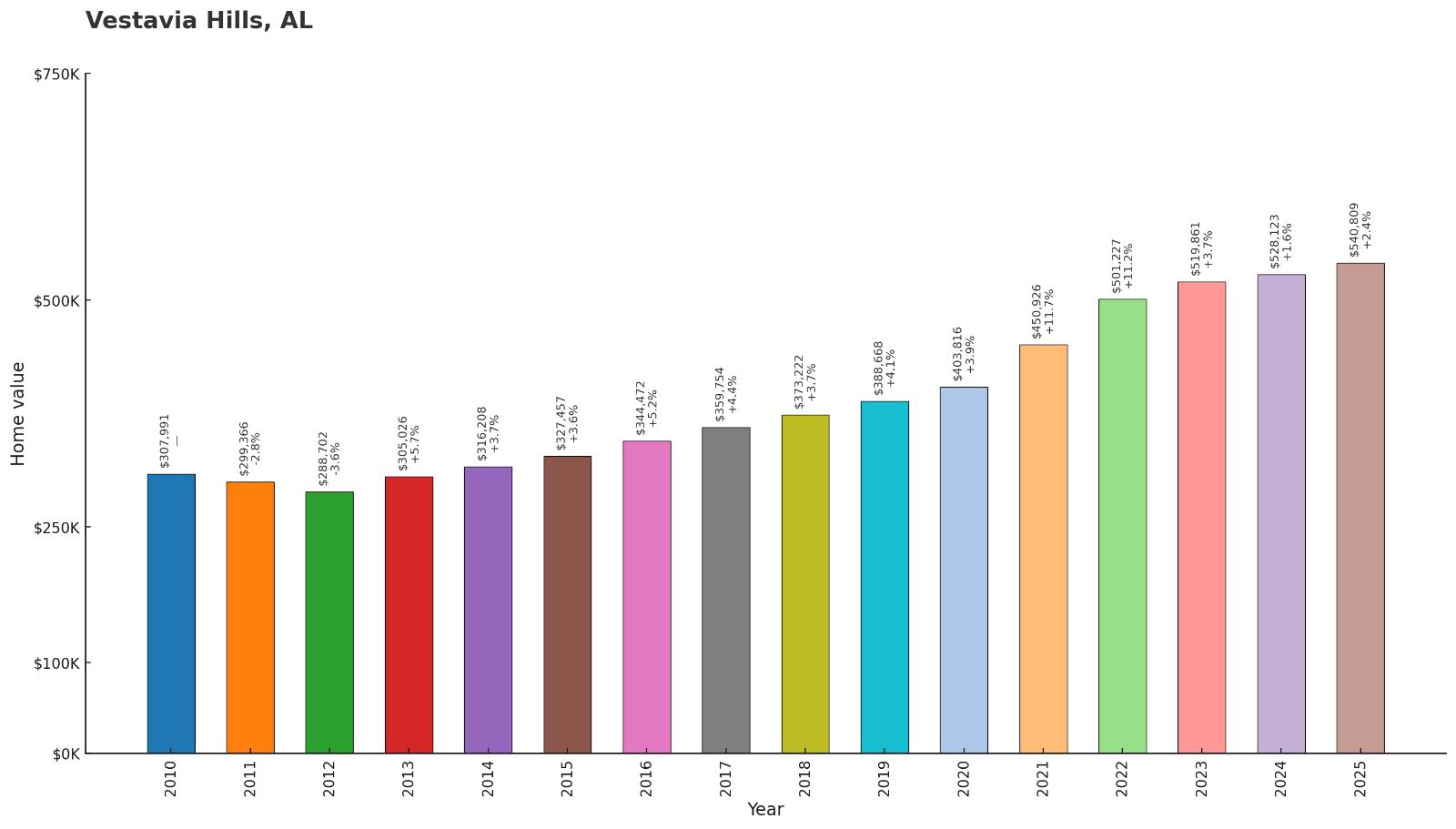
- 2010: $307,991
- 2011: $299,366
- 2012: $288,702
- 2013: $305,026
- 2014: $316,208
- 2015: $327,457
- 2016: $344,472
- 2017: $359,754
- 2018: $373,222
- 2019: $388,668
- 2020: $403,816
- 2021: $450,926
- 2022: $501,227
- 2023: $519,861
- 2024: $528,123
- 2025: $540,809
Vestavia Hills has shown consistent appreciation since 2010, with home values increasing by 76% over the period. The community maintained steady growth throughout most years, with notable acceleration between 2020 and 2023 when prices rose from $403,816 to $519,861. Current values at $540,809 reflect the sustained demand for this established Jefferson County suburb known for excellent schools and comprehensive community amenities.
Why Vestavia Hills?
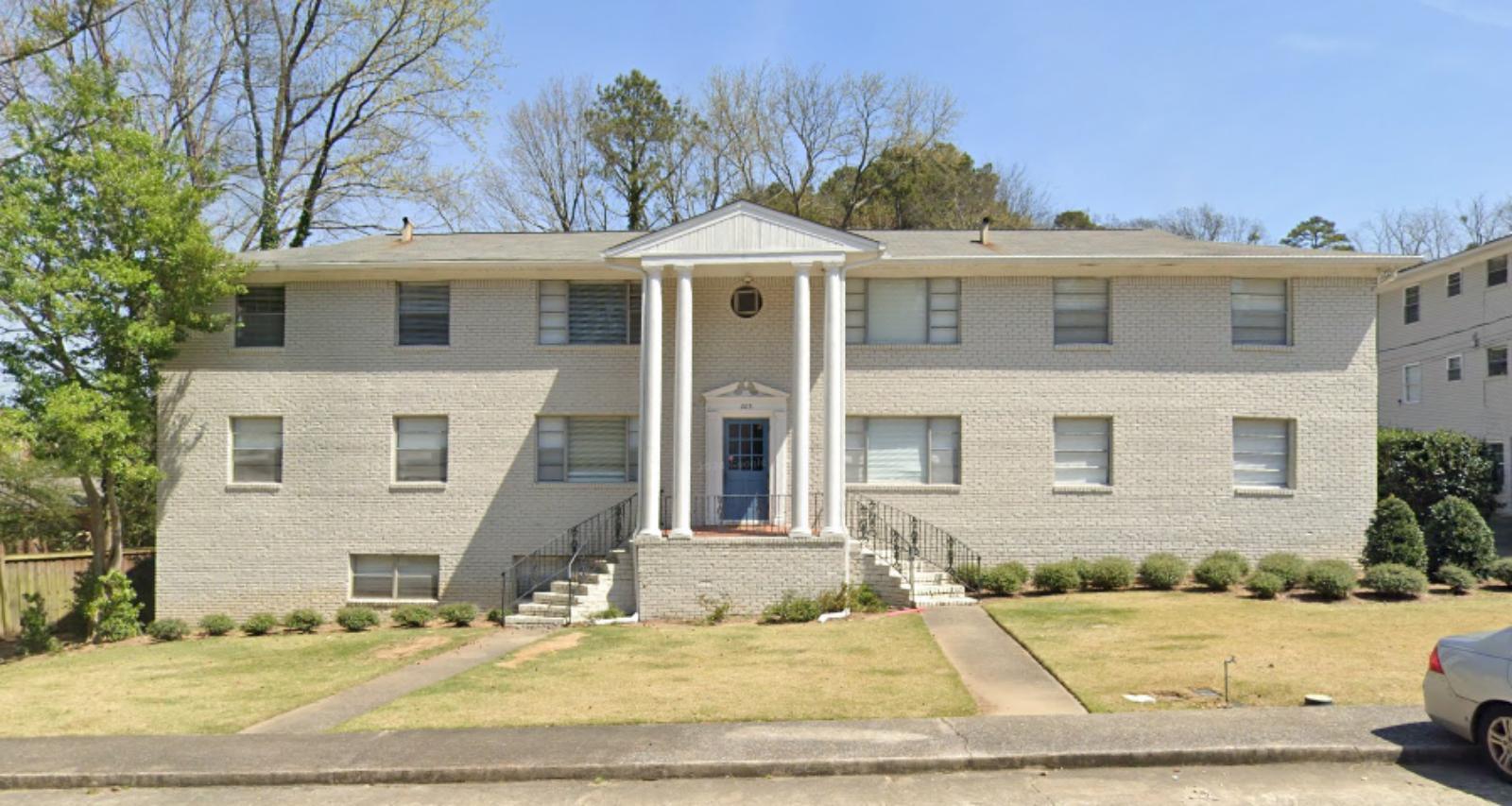
Why Are People Willing to Pay So Much to Live Here? What’s Special About It?
Vestavia Hills offers families a complete suburban lifestyle with top-rated schools, extensive recreational facilities, and well-planned neighborhoods that create an ideal environment for raising children. The city features numerous parks, sports complexes, and community programs that foster family engagement and outdoor activity. Residents value the city’s commitment to maintaining high standards for development and municipal services.
The community provides convenient access to Birmingham employment while offering distinct neighborhood identity and comprehensive amenities. Vestavia Hills appeals to professionals and families seeking quality schools, recreational opportunities, and safe neighborhoods with modern infrastructure. The city’s reputation for educational excellence and community life creates consistent demand that supports premium housing values.
How Vestavia Hills Rose to Prominence
Vestavia Hills was incorporated in 1950, taking its name from the estate of former Birmingham mayor George Ward, whose home was modeled after the Roman Temple of Vesta. The community developed as Birmingham’s suburban expansion reached Jefferson County’s southern areas. Early growth focused on providing quality residential neighborhoods for middle-class families.
The city’s emergence as a premier suburban community accelerated in the 1970s and 1980s as comprehensive planning created excellent schools, parks, and infrastructure. Vestavia Hills’ emphasis on family amenities, recreational facilities, and educational quality established its reputation as one of Alabama’s best places to raise children. The community has maintained its appeal through continued investment in schools, parks, and municipal services.
3 Interesting Tidbits
- Temple Heritage – The city name comes from George Ward’s estate, which featured a home modeled after the Roman Temple of Vesta, parts of which still exist today.
- Recreation Focus – Vestavia Hills maintains over 700 acres of parkland and recreational facilities, including the Vestavia Hills Athletic Complex and numerous neighborhood parks.
- Educational Excellence – Vestavia Hills High School consistently ranks among Alabama’s top public high schools, with graduates achieving high college admission rates and test scores.
5. Indian Springs Village – 107% Home Price Increase Since 2010

- 2010: $276,171
- 2011: $266,289
- 2012: $269,973
- 2013: $283,767
- 2014: $306,070
- 2015: $323,545
- 2016: $338,578
- 2017: $352,296
- 2018: $371,171
- 2019: $388,006
- 2020: $416,553
- 2021: $476,366
- 2022: $530,579
- 2023: $526,170
- 2024: $555,679
- 2025: $571,019
Indian Springs Village has more than doubled in value since 2010, with home prices increasing by 107% over the period. The community showed consistent growth throughout the entire period, with significant acceleration between 2020 and 2022 when prices rose from $416,553 to $530,579. Current values at $571,019 reflect the premium associated with this exclusive Shelby County community known for custom homes and natural beauty.
Why Indian Springs Village?

Why Are People Willing to Pay So Much to Live Here? What’s Special About It?
Indian Springs Village offers buyers an exclusive community with custom homes, extensive green space, and natural spring-fed amenities that create a unique residential environment. The village features large lots, architectural diversity, and carefully preserved natural areas that provide privacy and scenic beauty. Residents appreciate the community’s commitment to environmental preservation and low-density development.
The area appeals to affluent buyers seeking custom homes, privacy, and natural amenities while maintaining reasonable access to Birmingham employment. Indian Springs Village’s emphasis on preserving natural springs, forests, and wildlife habitat creates a distinctive living environment that commands premium prices. The community’s exclusivity and environmental focus attract discerning buyers willing to pay for unique residential experiences.
How Indian Springs Village Rose to Prominence
Indian Springs Village was incorporated in 1990, but the area’s history centers around natural springs that Native Americans and early settlers used for their healing properties. The Indian Springs Hotel operated from the 1850s through the early 1900s as a resort destination where people came to enjoy the spring waters and mountain scenery.
Modern residential development began in the 1970s as developers recognized the area’s potential for upscale custom homes amid the natural spring and forest setting. The community incorporated to maintain local control over development and preserve the natural features that make the area unique. Indian Springs Village has successfully balanced exclusive residential development with environmental preservation, creating one of Alabama’s most distinctive communities.
3 Interesting Tidbits
- Natural Springs – The community features several natural springs that historically attracted visitors seeking their purported healing properties and continue to provide scenic amenities.
- Historic Resort – The Indian Springs Hotel operated as a popular 19th-century resort destination before the area’s transformation into an exclusive residential community.
- Environmental Focus – The village maintains strict development standards to preserve natural features, wildlife habitat, and the spring-fed streams that define the community’s character.
4. Jacksons Gap – 159% Home Price Increase Since 2010
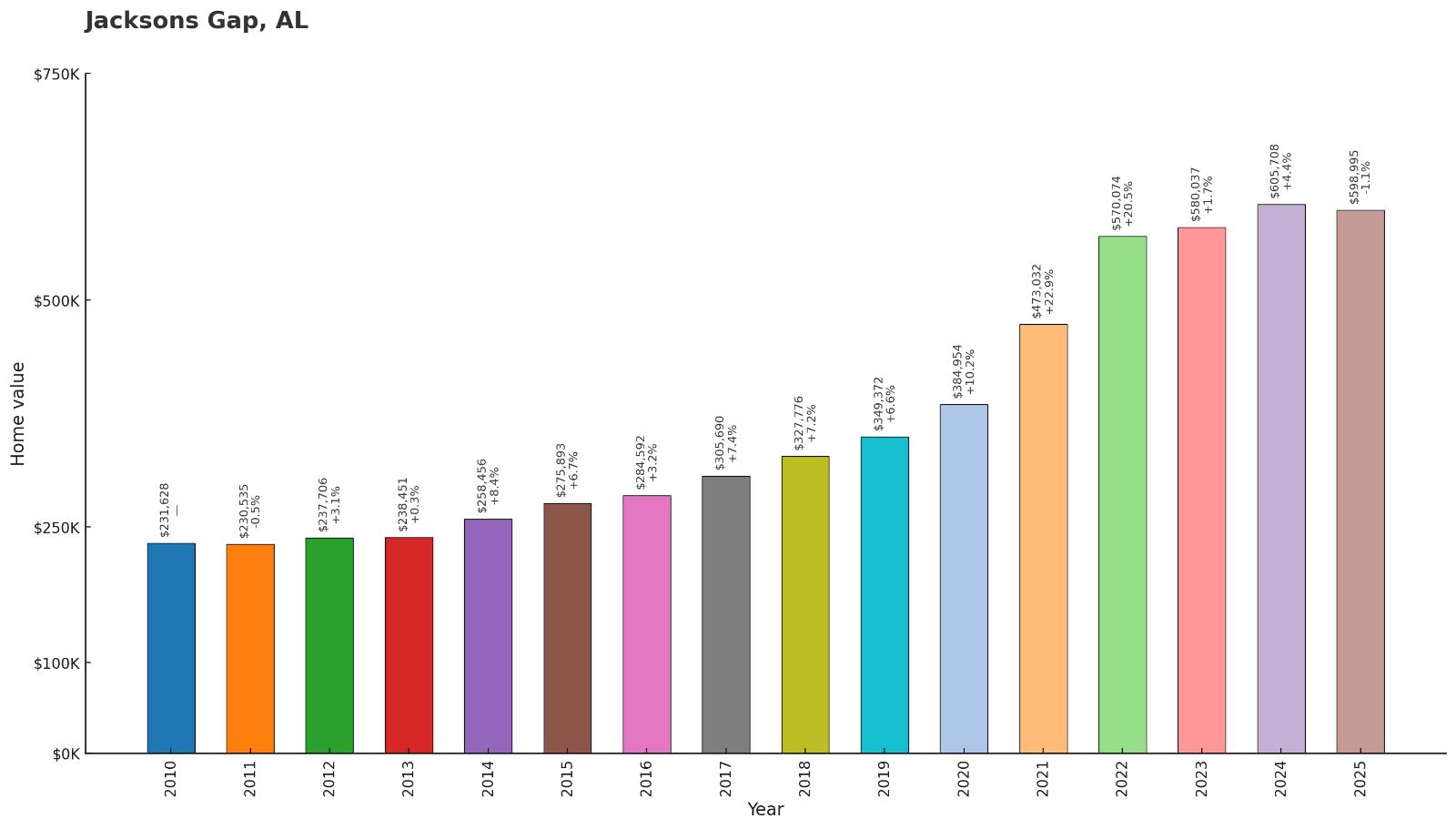
- 2010: $231,628
- 2011: $230,535
- 2012: $237,706
- 2013: $238,451
- 2014: $258,456
- 2015: $275,893
- 2016: $284,592
- 2017: $305,690
- 2018: $327,776
- 2019: $349,372
- 2020: $384,954
- 2021: $473,032
- 2022: $570,074
- 2023: $580,037
- 2024: $605,708
- 2025: $598,995
Jacksons Gap has delivered remarkable appreciation since 2010, with home values increasing by 159% over the period. The community showed steady growth throughout the entire period, with dramatic acceleration between 2020 and 2022 when prices surged from $384,954 to $570,074. Current values at $598,995 reflect the exceptional demand for this Lake Martin community that offers premium waterfront living and recreational opportunities.
Why Jacksons Gap?

Why Are People Willing to Pay So Much to Live Here? What’s Special About It?
Jacksons Gap offers prime Lake Martin waterfront access with some of Alabama’s most expensive and desirable lake properties. The community features luxury lake homes, private docks, and direct access to 750 miles of pristine shoreline that attracts affluent buyers from across the Southeast. Residents enjoy world-class fishing, boating, and water recreation in a scenic setting with upscale amenities and services.
The area appeals to wealthy retirees, vacation homeowners, and successful professionals seeking premium lake living with recreational opportunities that rival more expensive markets in other states. Jacksons Gap’s location on Lake Martin provides access to clear water, excellent fishing, and comprehensive marina services that create a resort-like lifestyle. The combination of natural beauty, recreational amenities, and luxury accommodations justifies premium pricing for discerning buyers.
How Jacksons Gap Rose to Prominence
Jacksons Gap was established as a small rural community in Tallapoosa County, remaining primarily agricultural throughout most of its early history. The area was sparsely populated with limited development until the creation of Lake Martin by Alabama Power in the 1920s began transforming the region’s potential for recreational and residential development.
The community’s emergence as a premier lake destination accelerated in the 1980s and 1990s as developers and affluent buyers recognized Lake Martin’s exceptional qualities and development potential. Jacksons Gap became synonymous with luxury lake living as high-end homes, marinas, and resort amenities were developed along the shoreline. The area has maintained its reputation as one of Alabama’s most exclusive lake communities, attracting buyers seeking the ultimate in waterfront luxury.
3 Interesting Tidbits
- Luxury Lake Homes – According to lakehomes.com, six out of eight of Alabama’s most expensive lake homes are located on Lake Martin, with many in the Jacksons Gap area.
- Clear Water Paradise – Lake Martin’s exceptional water clarity and quality make it one of the Southeast’s premier recreational lakes for swimming, diving, and water sports.
- Million-Dollar Views – The community features numerous multi-million-dollar waterfront estates with private beaches, boat houses, and panoramic lake views.
3. Equality – 124% Home Price Increase Since 2010

- 2010: $278,455
- 2011: $285,379
- 2012: $289,827
- 2013: $291,710
- 2014: $313,179
- 2015: $321,315
- 2016: $325,542
- 2017: $339,194
- 2018: $351,063
- 2019: $362,440
- 2020: $373,045
- 2021: $452,864
- 2022: $517,513
- 2023: $532,198
- 2024: $612,444
- 2025: $622,549
Equality has delivered exceptional appreciation since 2010, with home values increasing by 124% over the period. The community showed steady but modest growth through 2020, then experienced dramatic acceleration with prices jumping from $373,045 to $517,513 between 2020 and 2022, and continuing to surge through 2025. Current values at $622,549 reflect the premium associated with this exclusive Lake Martin community known for luxury waterfront properties.
Why Equality?

Why Are People Willing to Pay So Much to Live Here? What’s Special About It?
Equality offers access to some of Lake Martin’s most prestigious waterfront properties, with luxury homes that often reach into the millions of dollars. The small community provides an exclusive setting for affluent buyers seeking premier lake living with privacy, natural beauty, and recreational amenities. Residents enjoy direct access to pristine lake waters, private beaches, and world-class fishing in a setting that rivals expensive lake communities nationwide.
The area’s limited population of around 150 residents creates an intimate, exclusive atmosphere that appeals to wealthy retirees and vacation homeowners. Equality’s location on Lake Martin provides access to clear water, excellent boating conditions, and comprehensive recreational opportunities while maintaining seclusion from larger developments. The combination of natural beauty, exclusivity, and luxury accommodations creates exceptional appeal for discerning buyers willing to pay premium prices.
How Equality Rose to Prominence
Equality began as a small agricultural community in Coosa County, remaining largely undeveloped and sparsely populated for most of its history. The area was primarily farmland with limited residential development until Lake Martin’s creation in the 1920s began changing the region’s character and development potential.
The community’s transformation into an exclusive lake destination occurred gradually as affluent buyers discovered the area’s potential for luxury waterfront development. Equality’s emergence as a premium Lake Martin community accelerated in recent decades as high-end homes and estates were developed along the shoreline. The area has maintained its exclusivity through limited development and high property values that attract only the most affluent buyers seeking ultimate lake living experiences.
3 Interesting Tidbits
- Tiny Population – With only about 150 residents, Equality maintains an intimate, exclusive atmosphere that appeals to affluent buyers seeking privacy and seclusion.
- Lake Martin Jewel – The community sits on one of Lake Martin’s most scenic areas, with many properties offering panoramic water views and private shoreline access.
- Million-Dollar Market – Equality features some of Alabama’s most expensive residential properties, with waterfront estates often selling for multiple millions of dollars.
2. Orange Beach – 110% Home Price Increase Since 2010
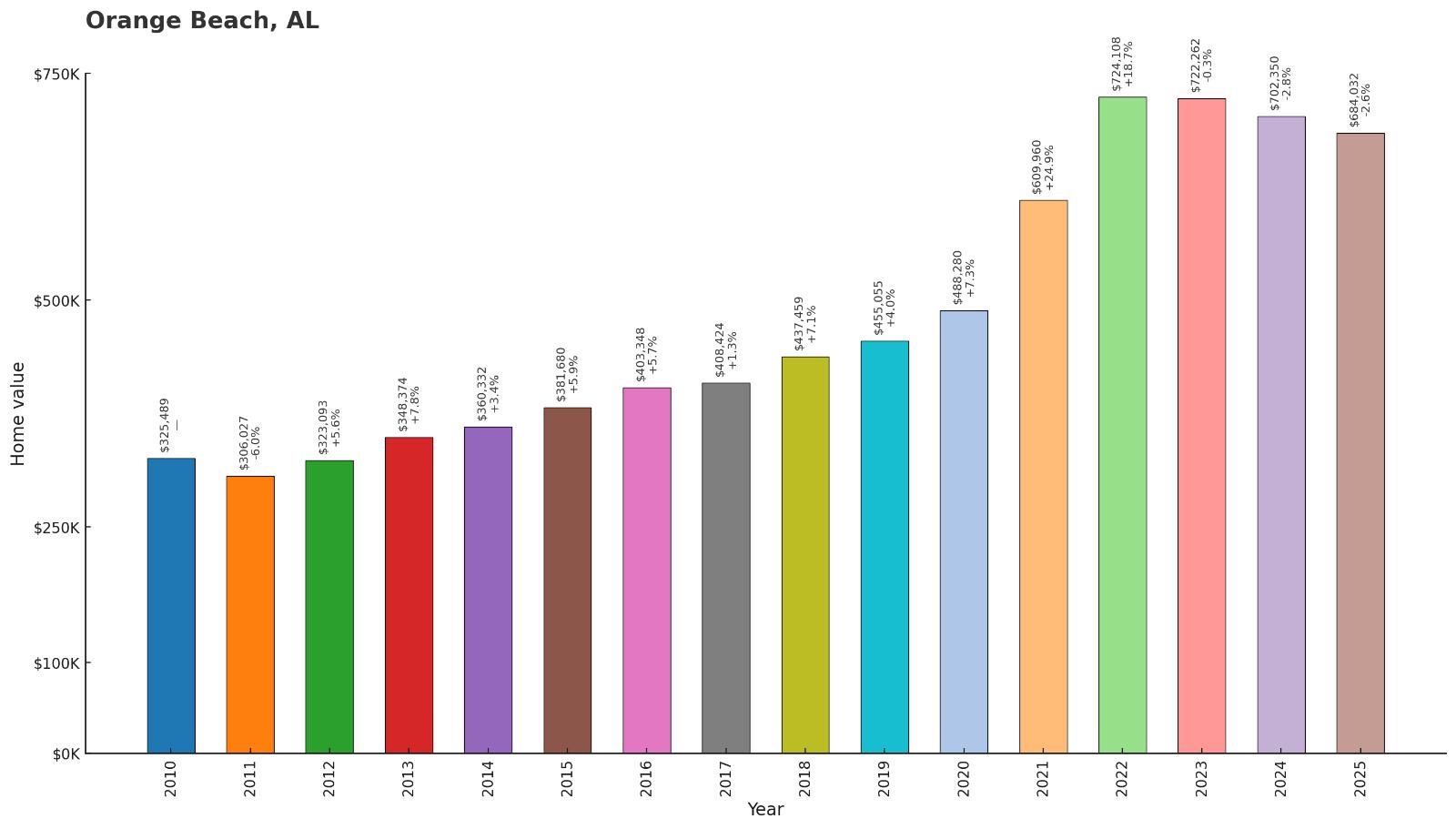
- 2010: $325,489
- 2011: $306,027
- 2012: $323,093
- 2013: $348,374
- 2014: $360,332
- 2015: $381,680
- 2016: $403,348
- 2017: $408,424
- 2018: $437,459
- 2019: $455,055
- 2020: $488,280
- 2021: $609,960
- 2022: $724,108
- 2023: $722,262
- 2024: $702,350
- 2025: $684,032
Orange Beach has more than doubled in value since 2010, with home prices increasing by 110% over the period. The community showed consistent growth through 2020, then experienced dramatic acceleration with prices surging from $488,280 to $724,108 between 2020 and 2022 before moderating. Current values at $684,032 reflect the premium associated with this upscale coastal community that offers luxury beach living and resort amenities.
Why Orange Beach?

Why Are People Willing to Pay So Much to Live Here? What’s Special About It?
Orange Beach offers luxury coastal living with beautiful white-sand beaches, upscale resort amenities, and comprehensive recreational opportunities along Alabama’s Gulf Coast. The community features high-rise condominiums, luxury beach houses, and resort-style developments that create an upscale beach destination. Residents enjoy world-class fishing, boating, golf courses, and dining options that rival more expensive coastal markets.
The area appeals to affluent retirees, vacation homeowners, and investors seeking premium coastal properties with strong rental potential and luxury amenities. Orange Beach’s development standards and resort atmosphere distinguish it from typical beach communities, creating a sophisticated coastal lifestyle. The combination of natural beauty, luxury accommodations, and recreational opportunities justifies premium pricing for buyers seeking the ultimate beach living experience.
How Orange Beach Rose to Prominence
Orange Beach was incorporated in 1984, making it one of Alabama’s newer municipalities. The area was previously undeveloped coastline that began attracting attention as Gulf Shores and other coastal communities demonstrated the potential for beach tourism and residential development. Early development focused on creating an upscale alternative to more established beach destinations.
The community’s transformation into a luxury coastal destination accelerated through the 1990s and 2000s as developers created high-end resorts, condominiums, and residential communities. Orange Beach’s emphasis on quality development and resort amenities attracted affluent buyers and established its reputation as Alabama’s premier upscale beach community. The area has maintained its luxury positioning while expanding amenities and accommodations for discerning coastal buyers.
3 Interesting Tidbits
- Fishing Capital – Orange Beach bills itself as the “Red Snapper Capital of the World” and hosts major fishing tournaments that attract anglers from across the country.
- Luxury Developments – The community features numerous high-rise condominiums and luxury resorts that create a sophisticated beachfront skyline.
- Resort Amenities – Orange Beach offers championship golf courses, marinas, spas, and fine dining establishments that create a comprehensive luxury beach experience.
1. Mountain Brook – 80% Home Price Increase Since 2010
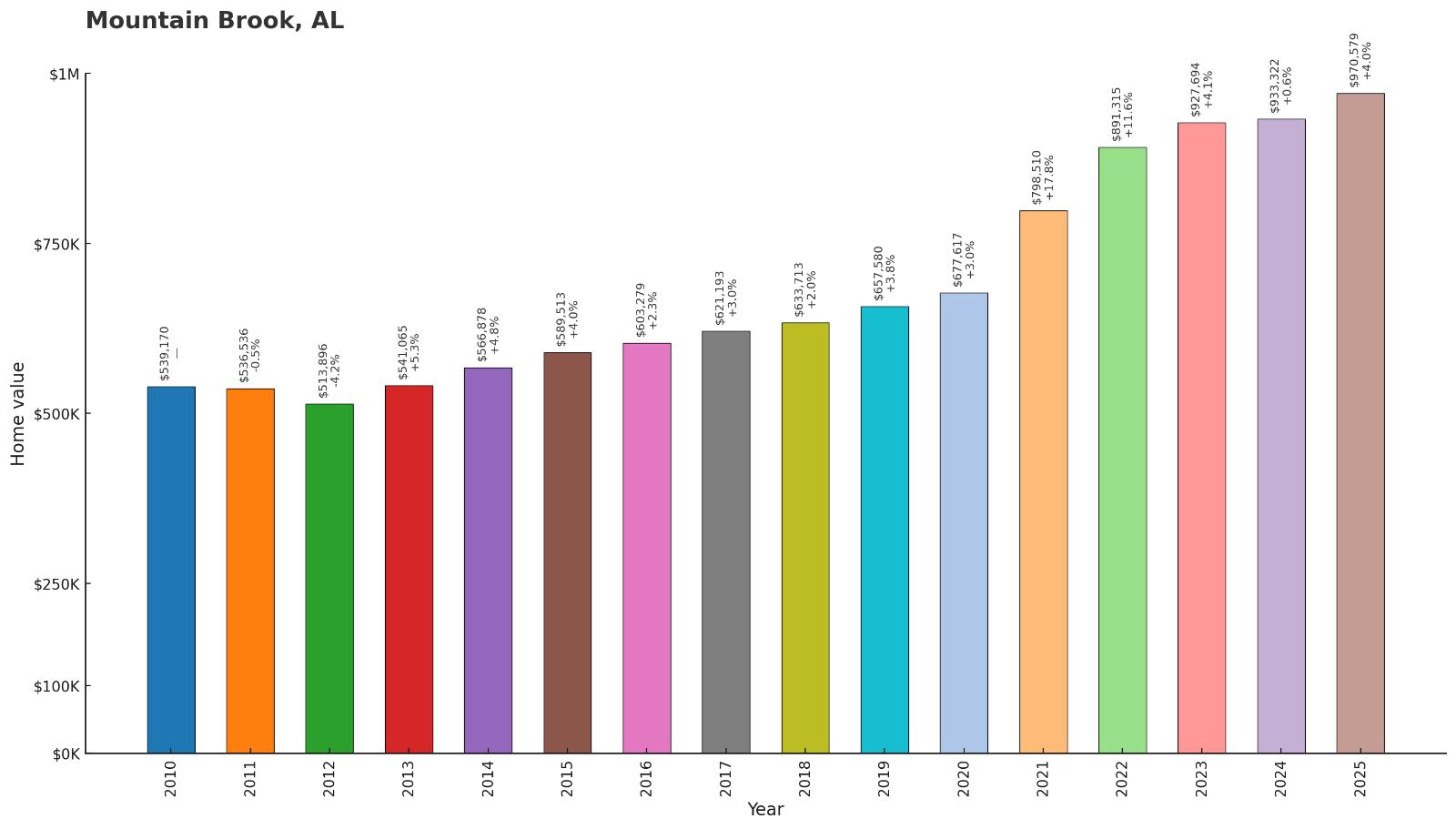
- 2010: $539,170
- 2011: $536,536
- 2012: $513,896
- 2013: $541,065
- 2014: $566,878
- 2015: $589,513
- 2016: $603,279
- 2017: $621,193
- 2018: $633,713
- 2019: $657,580
- 2020: $677,617
- 2021: $798,510
- 2022: $891,315
- 2023: $927,694
- 2024: $933,322
- 2025: $970,579
Mountain Brook has shown consistent appreciation since 2010, with home values increasing by 80% over the period despite starting at the highest base price. The community maintained steady growth throughout the entire period, with notable acceleration between 2020 and 2023 when prices rose from $677,617 to $927,694. Current values at $970,579 represent Alabama’s most expensive residential market and reflect the ultimate premium for prestige, exclusivity, and quality of life.
Why Mountain Brook?

Why Are People Willing to Pay So Much to Live Here? What’s Special About It?
Mountain Brook represents the pinnacle of Alabama luxury living, offering estate-sized lots, custom mansions, and unparalleled exclusivity that attracts the state’s wealthiest residents. The community features three distinct village centers, top-tier schools, and meticulously maintained neighborhoods that create the ultimate suburban luxury experience. Residents enjoy exceptional municipal services, beautiful parks, and a prestigious address that opens doors throughout the Southeast.
The area provides everything affluent families desire including educational excellence, cultural amenities, safe neighborhoods, and social prestige that justifies the highest housing costs in Alabama. Mountain Brook’s stringent development standards, architectural requirements, and community oversight maintain property values and exclusivity. The combination of location, prestige, amenities, and quality creates sustained demand among Alabama’s elite that supports premium pricing regardless of market conditions.
How Mountain Brook Rose to Prominence
Mountain Brook was developed in 1929 by real estate magnate Robert Jemison Jr., who envisioned Birmingham’s most exclusive suburb built around three village centers connected by scenic parkways. The community was planned from inception as a luxury residential area featuring large lots, architectural standards, and comprehensive amenities that would attract Birmingham’s elite.
The city’s reputation for exclusivity and quality was established early through careful planning, deed restrictions, and community standards that maintained property values and social prestige. Mountain Brook’s development of excellent schools, recreational facilities, and municipal services created a self-contained luxury community. The area has maintained its status as Alabama’s most exclusive address for over 80 years through continued investment in amenities and strict maintenance of development standards.
3 Interesting Tidbits
- Planned Perfection – Mountain Brook was designed by renowned landscape architect Warren Manning, who created the village concept and scenic parkway system that defines the community today.
- School Excellence – Mountain Brook Schools consistently rank as Alabama’s top public school system, with graduates attending the nation’s most prestigious universities.
- Village Centers – The community features three distinct village areas – Mountain Brook Village, English Village, and Crestline Village – each with unique character and amenities.
